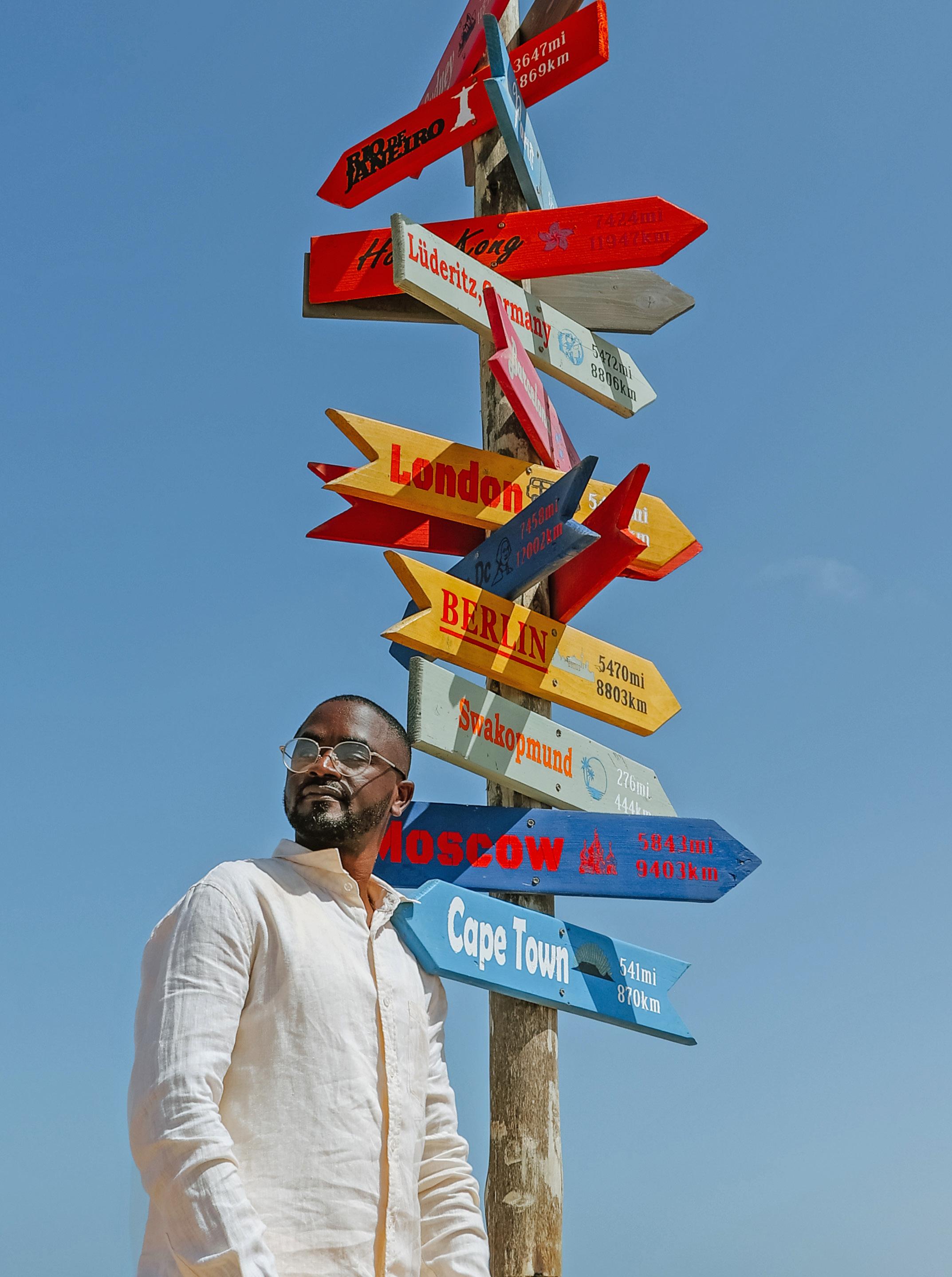




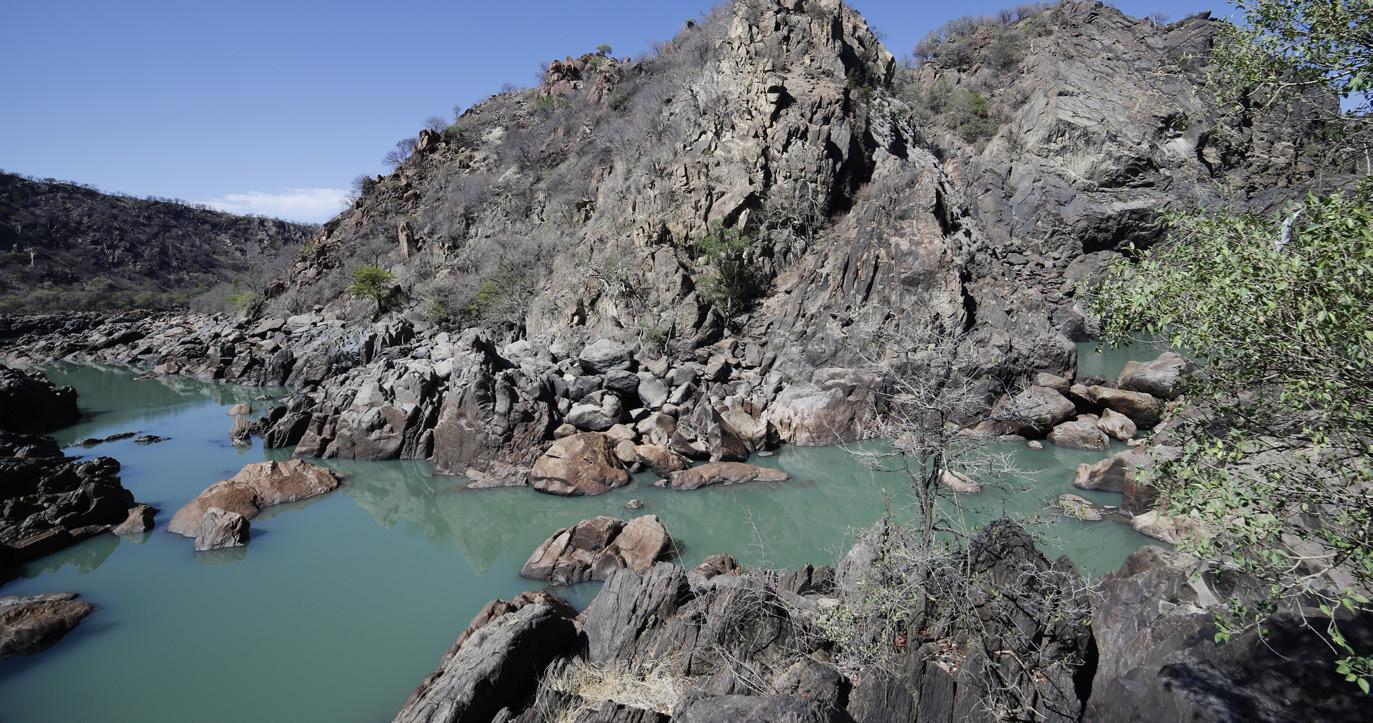
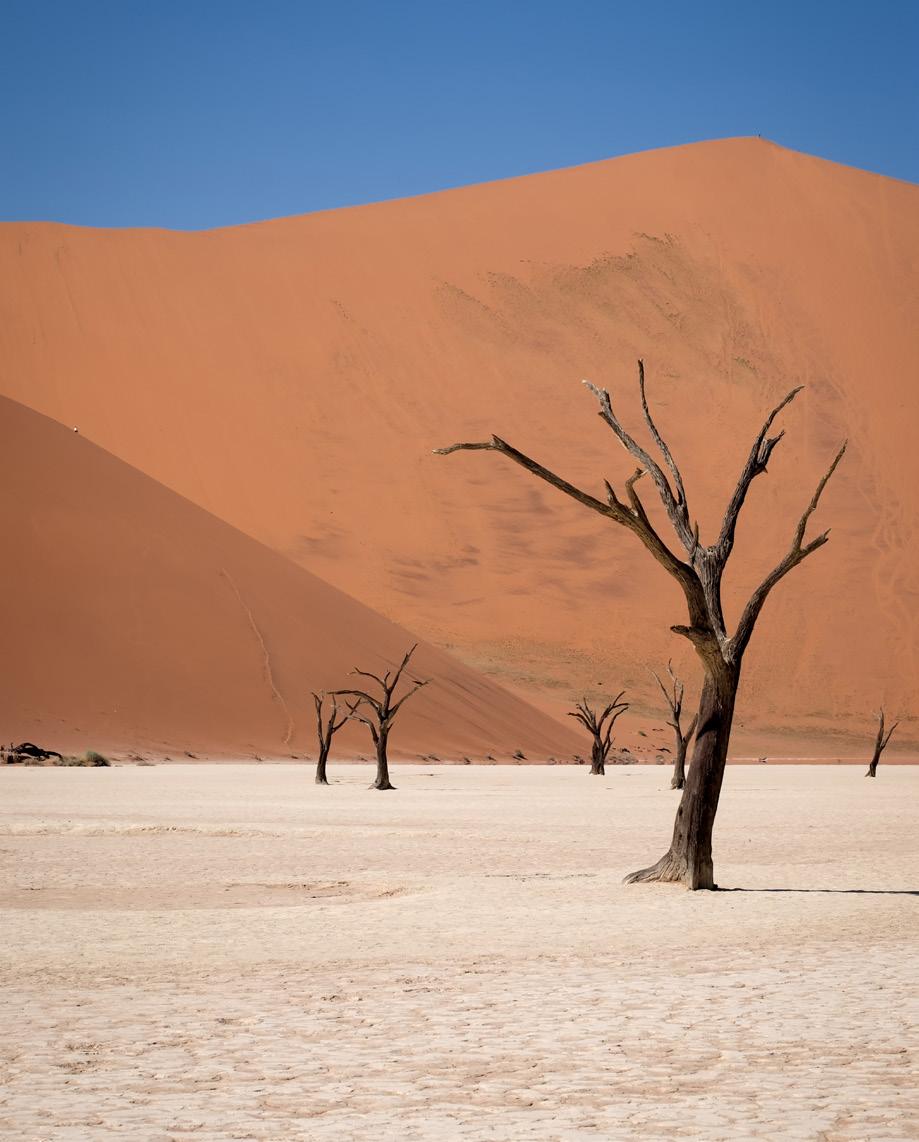
Namibia, with its breathtaking landscapes, vibrant wildlife, and rich cultural heritage, has long been a top destination for travellers. Under the slogan “The Best Get 100% Better,” the Namibia Tourism Board is enhancing its country’s tourism offerings, emphasizing safety, peace, and sustainable development to provide a world-class experience for every visitor.
A significant milestone in Namibia’s progress is the election of Hon. Ndemupelila Netumbo Nandi-Ndaitwah as the country’s first female president. Her leadership brings a new era of political stability, inclusivity, and good governance. By prioritizing transparency, Namibia continues to build trust among its citizens and international visitors. This peaceful political climate contributes to the country’s growing reputation as one of Africa’s safest and most welcoming destinations. Safety and peace are top priorities for the Namibia Tourism Board, and the government is committed to ensuring that tourists feel secure while exploring the country. Whether visiting the desert dunes or remote wildlife parks, travellers can enjoy Namibia’s wonders with peace of mind.
In addition to its dedication to security, Namibia continues to enhance the quality of services available to tourists. From luxury lodges to local tours, the country’s tourism industry has undergone significant improvements in training and development. Namibians are known for their warm hospitality, and visitors are increasingly treated to exceptional service at every level.
Namibia is also at the forefront of sustainable tourism. The country’s commitment to protecting its natural environment is clear, with eco-friendly initiatives and community-based conservation projects. Visitors can enjoy Namibia’s pristine landscapes, from the giant Namib Desert to the wildlife-filled Etosha National Park, all while supporting efforts to preserve the country’s rich biodiversity.
As Namibia continues to grow, it remains committed to offering a safe, peaceful, and sustainable destination for travellers. With a strong political foundation, a focus on security, and a dedication to improving services, Namibia’s tourism offerings are truly getting 100% better. Whether you’re an adventurer seeking thrills or someone looking for peace and tranquillity, Namibia guarantees an unforgettable experience.
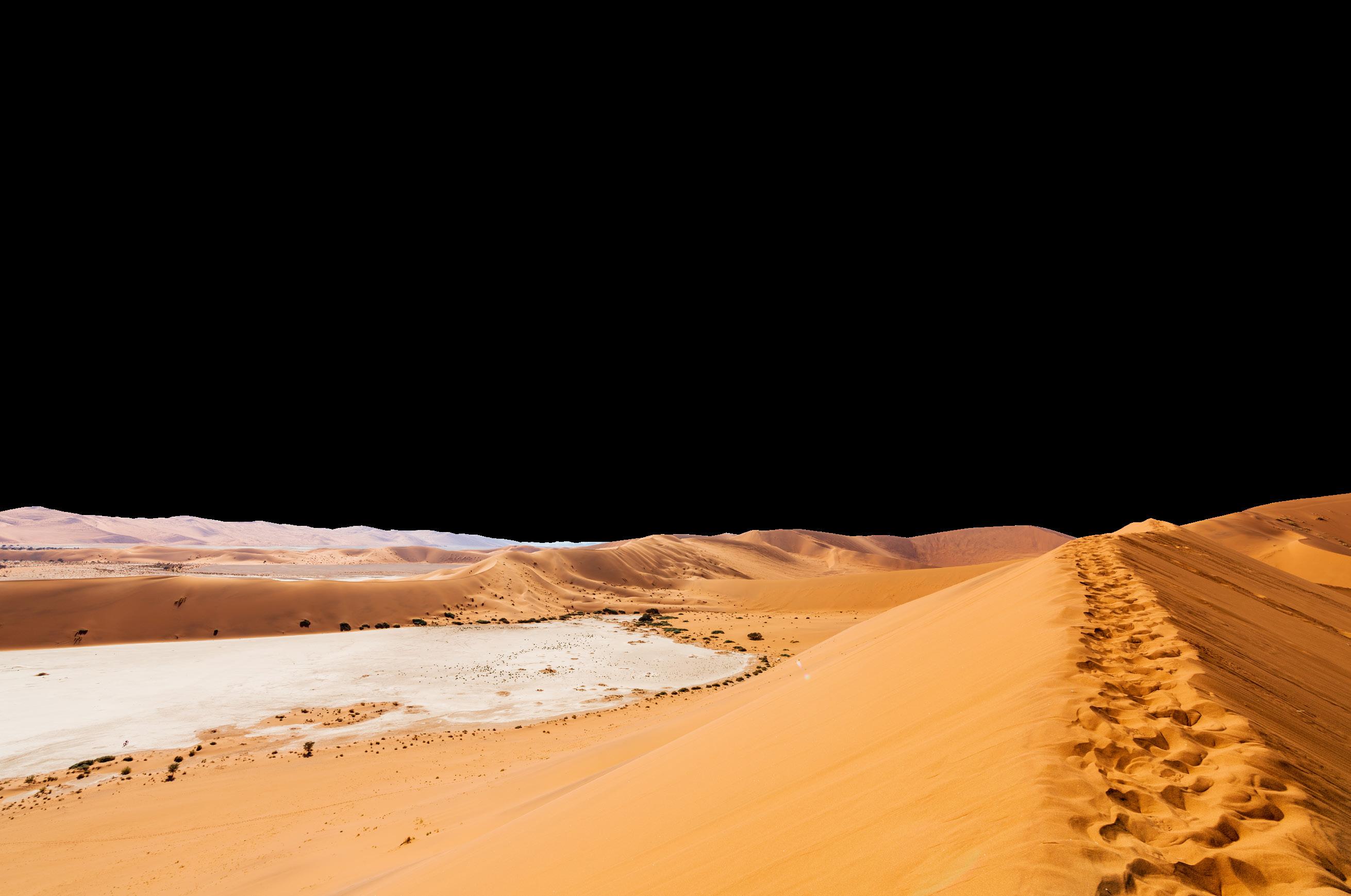


is published by Venture Media in Windhoek, Namibia www.thisisnamibia.com
Tel: +264 81 285 7450, 5 Conradie Street, Windhoek PO Box 21593, Windhoek, Namibia
EDITOR Elzanne McCulloch elzanne@venture.com.na
PUBLIC RELATIONS Elzanne McCulloch elzanne@venture.com.na
PRODUCTION & LAYOUT Liza Lottering liza@venture.com.na
CUSTOMER SERVICE Bonn Nortjé bonn@venture.com.na
TEXT CONTRIBUTORS
Le Roux van Schalkwyk, Elzanne McCulloch, Kirsty Watermeyer, Suné van Wyk, Pompie Burger, Madeleen Duvenhage, Martha Asheeke PHOTOGRAPHERS
Le Roux van Schalkwyk, Kirsty Watermeyer, Suné van Wyk, Pompie Burger, York Duvenhage, Kilian Brues/Hooves & Gardens, Charene Labuschagne, Elzanne McCulloch, Duncan Irvine


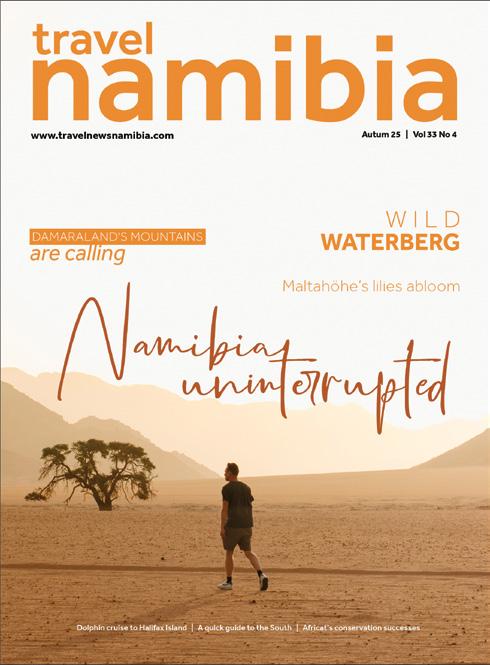
Travel Namibia is published quarterly, distributed worldwide via Zinio digital newsstand and in physical format in southern Africa. The editorial content of TN is contributed by the Venture Media team, freelance writers and journalists. It is the sole property of the publisher and no part of the magazine may be reproduced without written permission from the publisher.
All information and travel details are correct at the time of going to press. Due to uncertain circumstances, this may have changed after the date of publication. Please check businesses' individual websites for up-to-date details.

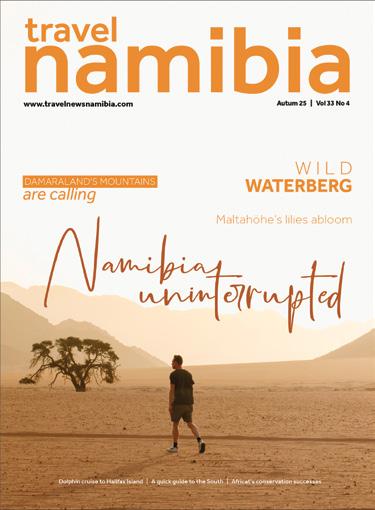








E L L , G R O W , S H A R E
O U R S T O R Y W I T H U S I N 2 0 2 1


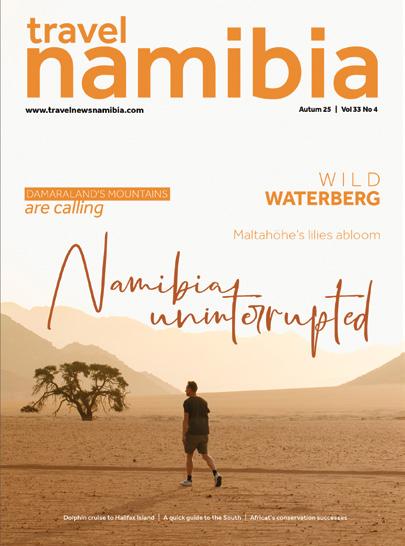


Venture Media is the pioneer of Namibia tourism promotion. We are the leader in spreading the tourism word around the world. We distribute accurate, credible, up to date and regular tourism-related information on paper, in social media, on the World Wide Web, and on mobile apps. We have reached hundreds of thousands over three decades. Be part of our community and let’s do it together.
In 2021, we're focussing on telling and sharing STORIES THAT MATTER across our various magazines and digital platforms. Join the journey and share your stories with audiences that understand and value why certain things matter.
We focus on telling and sharing STORIES THAT MATTER across our various magazines and digital platforms. Join the journey and share your stories with audiences that understand and value why certain things matter.
Why ethical business, conservation, tourism, people and communities matter. How these elements interrelate and how we can bring about change, contribute to the world and support each other. Whether for an entire nation, an industry, a community, or even just an individual.
Why ethical business, conservation, tourism, people and communities matter.
WWW.VENTURE.COM.NA or email us at info@venture.com.na for a curated proposal
How these elements interrelate and how we can bring about change, contribute to the world and support each other. Whether for an entire nation, an industry, a community or even just an individual.

W W W . V E N T U R E . C O M . N A

It was the kind of rain that knocked the power out. Thunder cracked, lightning lit up the sky in short, dramatic flashes, and the chaos of a Namibian thunderstorm unfolded in all its raw and awe-inspiring beauty.
Inside, we lit oil lanterns, laid down towels to soak up the water creeping in through the cracks, and listened to the rhythmic drumming of raindrops on the tin roof.
A stunning storm. Beautiful in its ferocity.
Raw beauty aside, what it symbolises is so much more. In a land where rain is not just a weather event but a defining force, its arrival is met with a mix of gratitude, relief, and sometimes, bittersweet longing.
The farmer runs out to his rain gauge the moment the maelstrom settles into a gentle drizzle. How much reached the ground? How much was carried away by the winds, drifting to the east or west, soaking another stretch of soil no more or less deserving? The drought took its toll on us all, and even with the knowledge that others, too, deserve this blessing, it’s hard not to feel a pang of disappointment when the clouds skirt around your piece of earth—teasing, threatening, but ultimately leaving you dry.
And so, the ritual repeats. Heading out into intermittent drops, petrichor in the air, eyes fixed on the millimeter reading of a simple plastic cone that has become the keeper of your happiness. The measure of your mood.
Autumn arrives in the wake of the rains, and this year, it feels like a season of gratitude. The land has responded with open arms—savannah grasslands stretching green, the stark branches of acacia trees bursting into leaf, even the ancient Namib Desert rejoicing in scattered, miraculous blooms. Along the red termite mounds, omajova mushrooms push through damp earth, a gift from the heavens. The dust has settled, the air is fresh, and for a moment, the weight of drought is lifted.
In this issue, we explore a Namibia transformed by rain. We walk through the rugged landscapes of Damaraland and the Waterberg, where life stirs after the dry season. We visit Sandhof farm, where thousands of lilies bloom in ephemeral beauty, and travel to Okonjima and meet AfriCat’s conservationists. We uncover a myriad of amazing stories in between, watching how water— whether in rain, fog, or ocean spray—shapes the land and the creatures that call it home. We see how hope blooms for a year of abundance ahead.
As the navy thunderclouds roll away, we look to the future with cautious optimism. We know that this rain, however generous, will not last forever. But for now, we lift our faces, breathe in the scent of damp earth, and whisper our gratitude to the skies.
With love from Namibia,

Elzanne McCulloch ON THE COVER
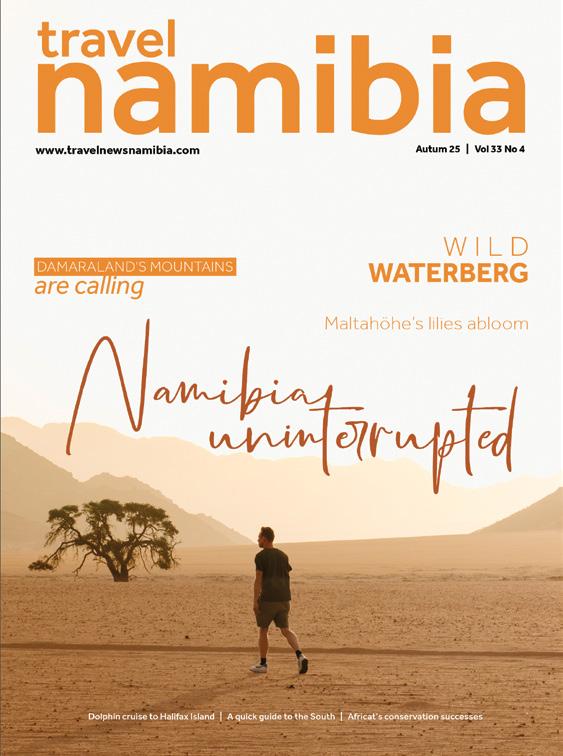
As the sun sets over Namibia’s southern desert, golden sands and vast silence invite reflection - every step a journey into solitude, wonder and endless possibility.
Image: Suné van Wyk
FOLLOW US ON INSTAGRAM @thisis_namibia

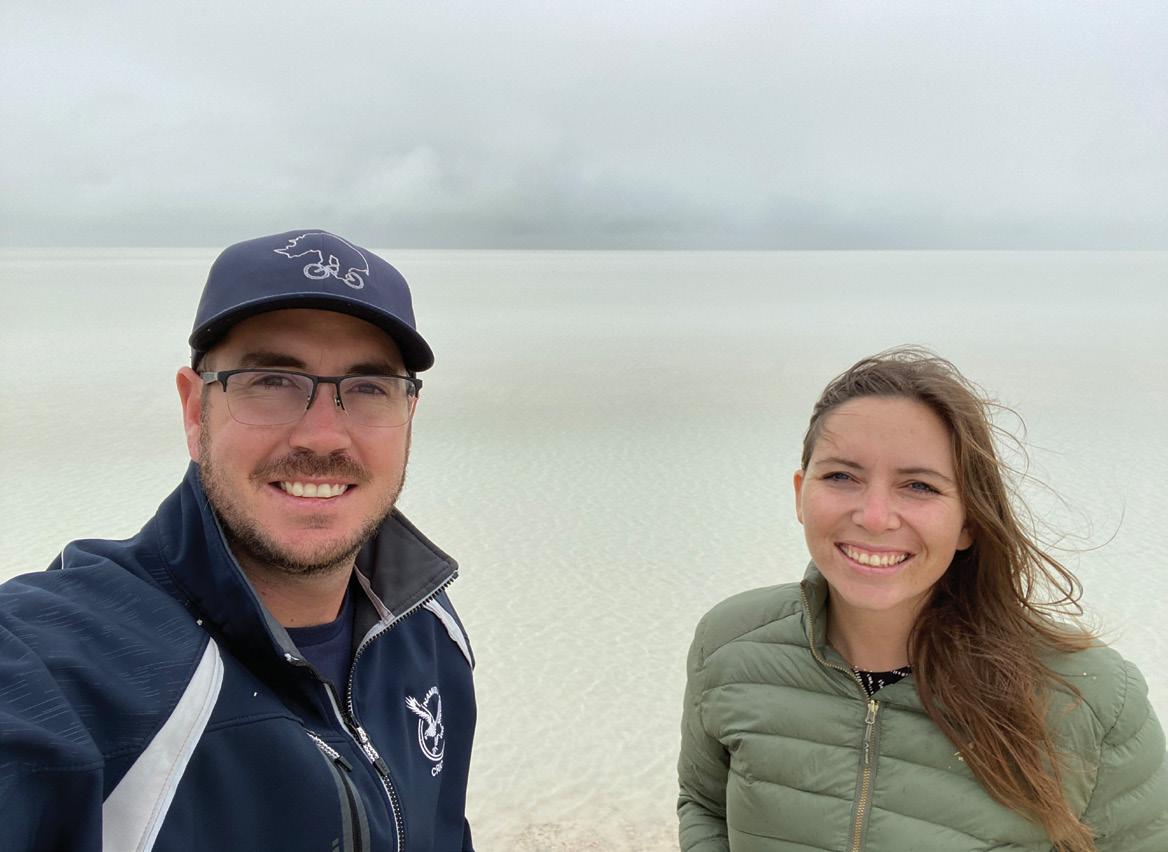
the rainy season.

BETWEEN A ROCK AND A TIMELESS PLACE p14
Uncover the hidden gems of Waterberg
A LOVE LETTER TO THE SANDHOF LILIES p28
The kind of beauty that makes you realise you’re witnessing something magical.
BIRDING IN THE ZAMBEZI p38
When, where and why?
CARVED FROM ROCK p54
The place where the bones of the earth stretch across the land

WHERE THE WILD THINGS WADDLE | Sailing to Halifax Island
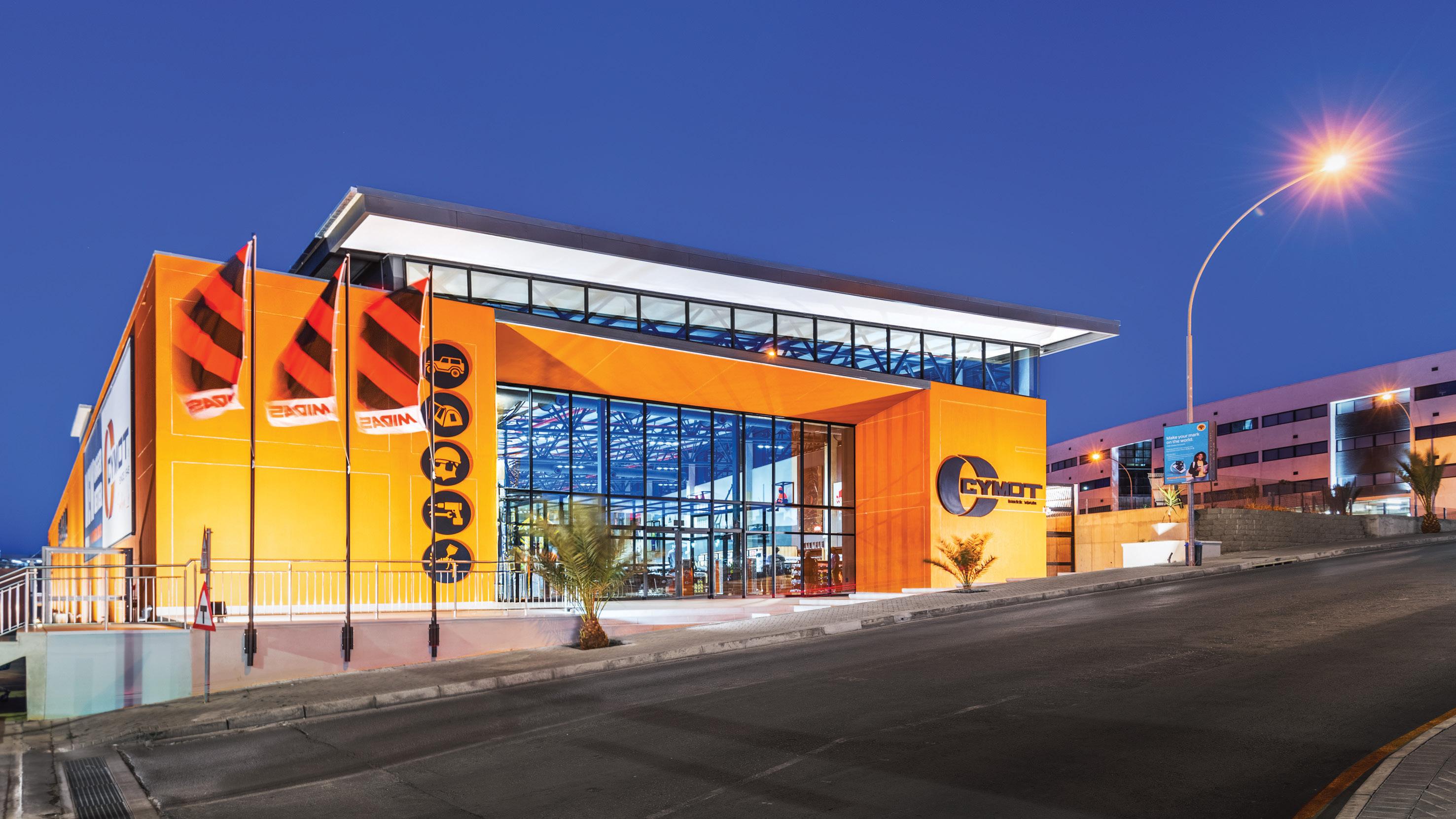



Whether you're on business or exploring Namibia, CYMOT Hilltop has everything you need under one roof!
Conveniently located next to Grove Mall in Windhoek, we make shopping easy, hassle-free, and enjoyable.
Start your journey with the perfect cup! Fuel up with the rich aroma and bold avours of Slow Town Coffee, available in-store. From a quick espresso to a smooth latte, every cup is crafted to perfection.

Explore our wide range of products and services: Automotive

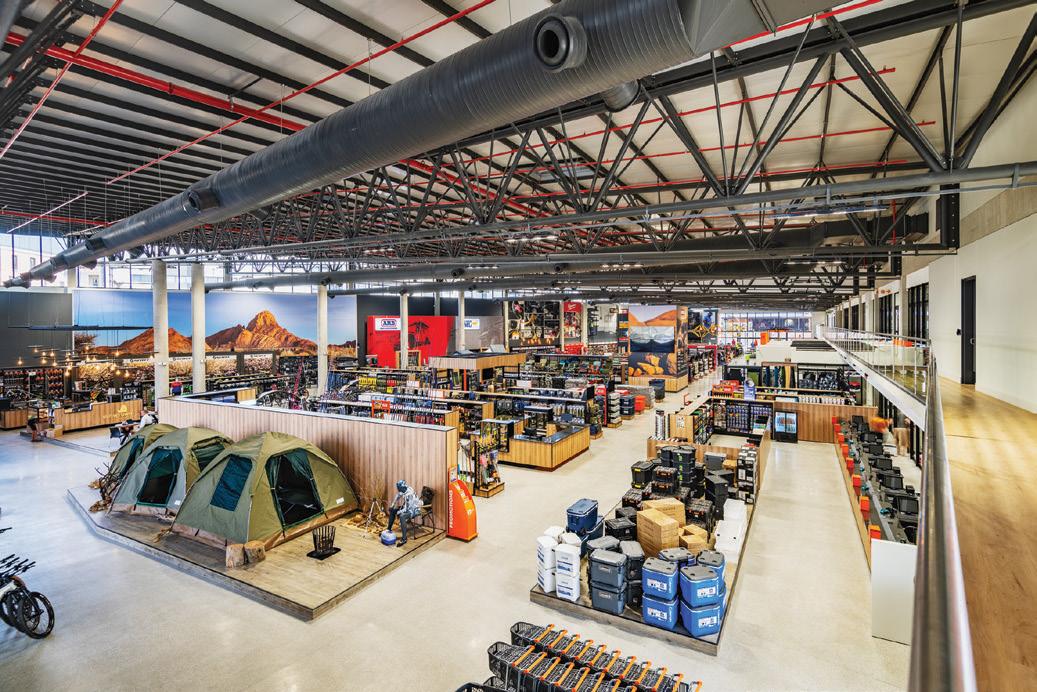
We’re open 7 days a week! Monday - Friday: 09:00 - 18:00
09:00 - 15:00
09:00 - 13:00

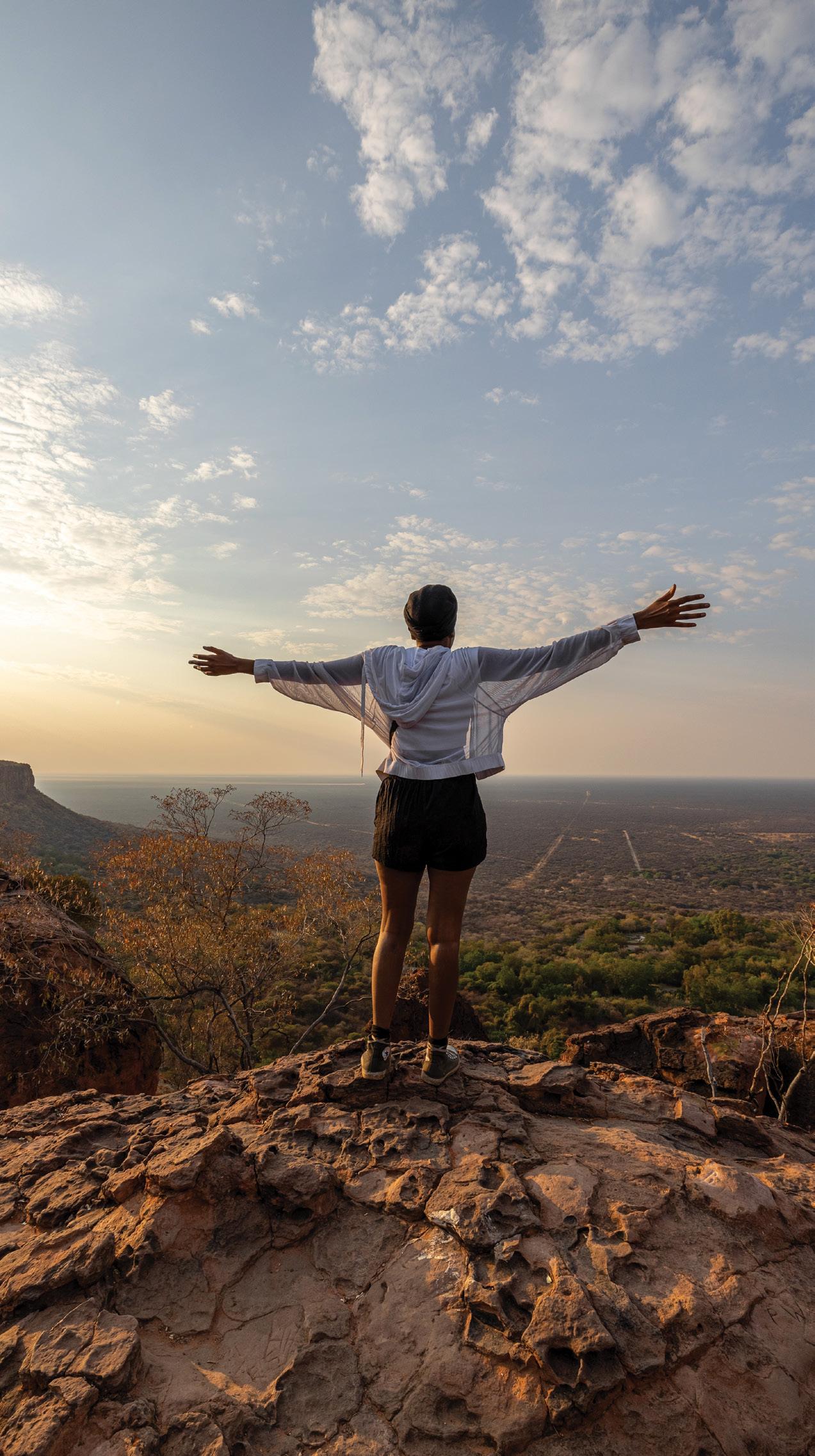
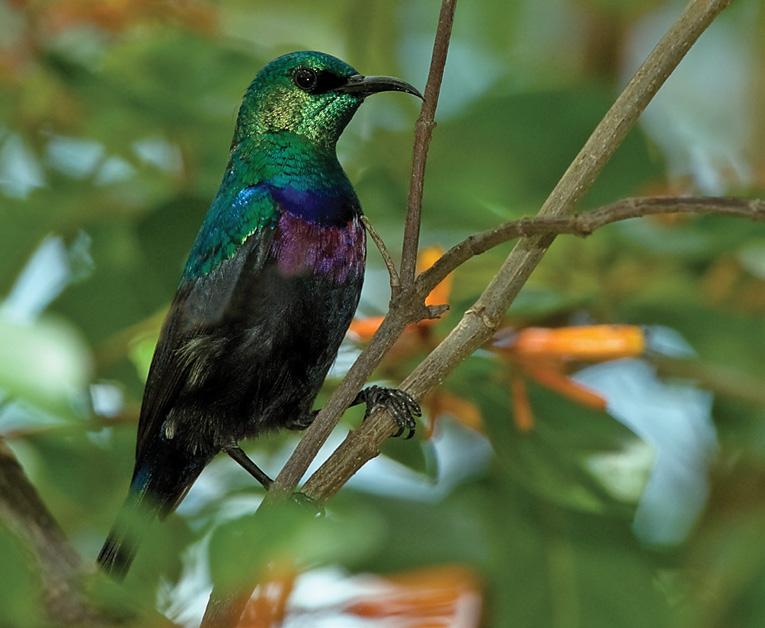



Onguma Nature Reserve in Namibia will launch Onguma Trails Camp on 1 April 2025, offering an intimate 2-night walking safari experience, with an option to extend to 3 nights. Designed for adventure seekers, the camp accommodates just eight guests in four luxury bell tents, each featuring extra-length beds, a private outdoor bathroom, and a wood-fired hot tub. Days are spent on expertguided 6-8 km walking safaris, with bush breakfasts, intimate boma dinners, and conservation talks. Eco-conscious design ensures minimal environmental impact. Rates start at NAD 26,000 per person sharing, with scheduled departures from April to September 2025. Book now at Onguma.com or email reservations@onguma.com

African Countries: Benin, Burkina Faso, Burundi, Cabo Verde, Cameroon, Central African Republic, Chad, Comoros, Côte d’Ivoire, Djibouti, Equatorial Guinea, Eritrea, Gabon, Gambia, Ghana, Guinea, Guinea-Bissau, Liberia, Madagascar, Mauritania, Niger, Rwanda, São Tomé and Príncipe, Sierra Leone, Togo, Tunisia, Western Sahara Republic, Uganda.
Other Countries: Argentina, Armenia, Australia, Austria, Azerbaijan, Belarus, Belgium, Bulgaria, Canada, Cambodia, Chile, Croatia, Czech Republic, Denmark, Ecuador, Estonia, Finland, France, Germany, Greece, Hungary, Iceland, Ireland, Israel, Italy, Kazakhstan, Kyrgyzstan, Latvia, Liechtenstein, Lithuania, Luxembourg, Mexico, Moldova, Netherlands, New Zealand, Nicaragua, Norway, Paraguay, Peru, Poland, Portugal, Romania, Singapore, Slovakia, Spain, South Korea, Sweden, Switzerland, Tajikistan, Thailand, Turkey, Turkmenistan, Ukraine, United Arab Emirates, United Kingdom, United States of America, Uruguay, Uzbekistan, Vatican/Holy See, Venezuela, Vietnam.
The Ministry of Home Affairs, Immigration, Safety and Security, in collaboration with the Namibia Investment Promotion & Development Board (NIPDB), the Namibia Tourism Board (NTB), and the tourism private sector—represented by the Tour and Safari Association (TASA) and the Hospitality Association of Namibia (HAN)—is pleased to introduce Namibia’s new Visa on Arrival (VOA) process for international travellers.
Effective immediately, nationals from selected countries can now apply for their visa online (available from 3 March 2025) or opt for the Visa on Arrival service at Namibia’s designated ports of entry starting 1 April 2025. This enhancement reduces waiting times and streamlines the entry process, offering greater flexibility for visitors.
The online visa application, available via Namibia’s official government portal, allows travellers to obtain pre-approval before arrival. With a confirmed E-Visa Permit, visitors can enter through all specified points of entry—whether by land, air, or sea—without the need to visit a consulate. This digital option minimises delays at immigration counters. In cases where an online visa application is denied, applicants should contact the nearest Namibian embassy or the Ministry of Home Affairs, Immigration, Safety and Security for further assistance.
For those opting for an in-person Visa on Arrival, the facility will be available at designated ports of entry. However, travellers with a pre-approved online E-Visa Permit can enjoy faster processing at most official entry points. Upon arrival, all visa applicants must be ready to present any supporting documentation as required by their online application.
All Visa on Arrival (VOA) visas will be Multiple Entry Visas, allowing travellers to leave and re-enter Namibia throughout the visa’s validity period. This is particularly beneficial for those exploring multiple countries within Southern Africa, providing ease of travel while ensuring smooth re-entry into Namibia for further exploration or departure flights.
Visitors arriving before 1 April 2025, who plan to leave and return to Namibia after this date, must request a multiple-entry visa upon arrival. The visa’s validity must cover their return travel dates, and clear travel itineraries should be presented to immigration officials.
As part of this initiative, Namibia is also introducing card payment facilities at specified ports of entry, allowing visitors to pay for their visas using credit or debit cards. This eliminates the need for cash payments, enhancing security and convenience for travellers.
• Valid passport (with at least 6 months validity +3 blank pages)
• Completed visa application form
• Confirmation of accommodation (hotel reservation or invitation letter)
• Confirmation of sufficient funds • Travel itinerary
• Travel/ Medical Insurance
• Full birth certificate or parental consent letter if travelling with children
• Online visa on arrival applicants require a printed copy of the approved e-visa
• NAD 1,600 (approximately USD 90) for citizens from non-African countries.
• NAD 1,200 (approximately USD 70) for citizens from African countries. These fees are subject to an annual review.
The new visa system and digital payment options reflect Namibia’s commitment to providing a seamless, efficient entry process, enabling visitors to focus on experiencing the country’s breathtaking landscapes, rich cultural heritage, and diverse wildlife.
Additionally, the Namibian government remains open to reciprocal visa agreements with countries listed under the new system, ensuring efficient services at all ports of entry.
More more information visit: www.thisisnamibia.com/visting-namibia-visa-info Apply online: https://eservices.mhaiss.gov.na/
FlyNamibia has appointed Nerine Uys, who has served as General Manager: Commercial for the past four years, as the airline’s new lead. According to the country’s only local-based scheduled passenger operator, Uys’s strategic vision and leadership have been pivotal in driving the airline’s growth. With a background in management accounting, retail, and entrepreneurship—and holding an Honours BComm from the University of Stellenbosch—Uys brings commercial acumen and innovation. FlyNamibia Board Chairwoman Ambassador Tonata ItengeEmvula stated, “Nerine’s expertise and fresh approach make her the perfect leader to drive our expansion and excellence.” Her extensive experience in market expansion and financial planning underscores her ability to steer FlyNamibia into its next phase of growth.



The Namibia Tourism Board (NTB) has appointed Sebulon Chicalu as its new Chief Executive Officer, effective 1 March 2025. A seasoned tourism strategist, Chicalu brings extensive experience in tourism product development, hospitality, and business event management. He previously served as Director of Tourism and Gaming at the Ministry of Environment, Forestry and Tourism, where he played a key role in shaping Namibia’s tourism policies.
With an MBA and expertise in corporate governance, Chicalu is well-placed to strengthen Namibia’s tourism sector. The Board has expressed confidence in his strategic vision, highlighting his commitment to enhancing Namibia’s appeal as a top travel destination. Congratulations to Mr Chicalu! We wish him all the best and great success in this new role!
The Hospitality Association of Namibia (HAN) entered 2025 with a renewed vision under the theme “Why Tourism Matters”. HAN welcomes Ndinelao Shikemeni as its new Tourism Executive Officer, based in Windhoek. With a Master’s in Tourism & Hospitality Management and extensive experience at Gondwana Collection Namibia, Shikemeni brings expertise and passion to the role. She will work closely with CEO Gitta Paetzold and the HAN Executive Committee to drive tourism development in Namibia.




The Lüderitz Nest Hotel has unveiled its newly renovated Luxury Suites, offering an elevated stay with direct sea views, a spacious lounge, and a private balcony. Thoughtfully designed for both comfort and elegance, they provide a serene retreat where luxury meets the rhythm of the ocean. Visit their website for bookings & more information: www.nesthotel.com TN
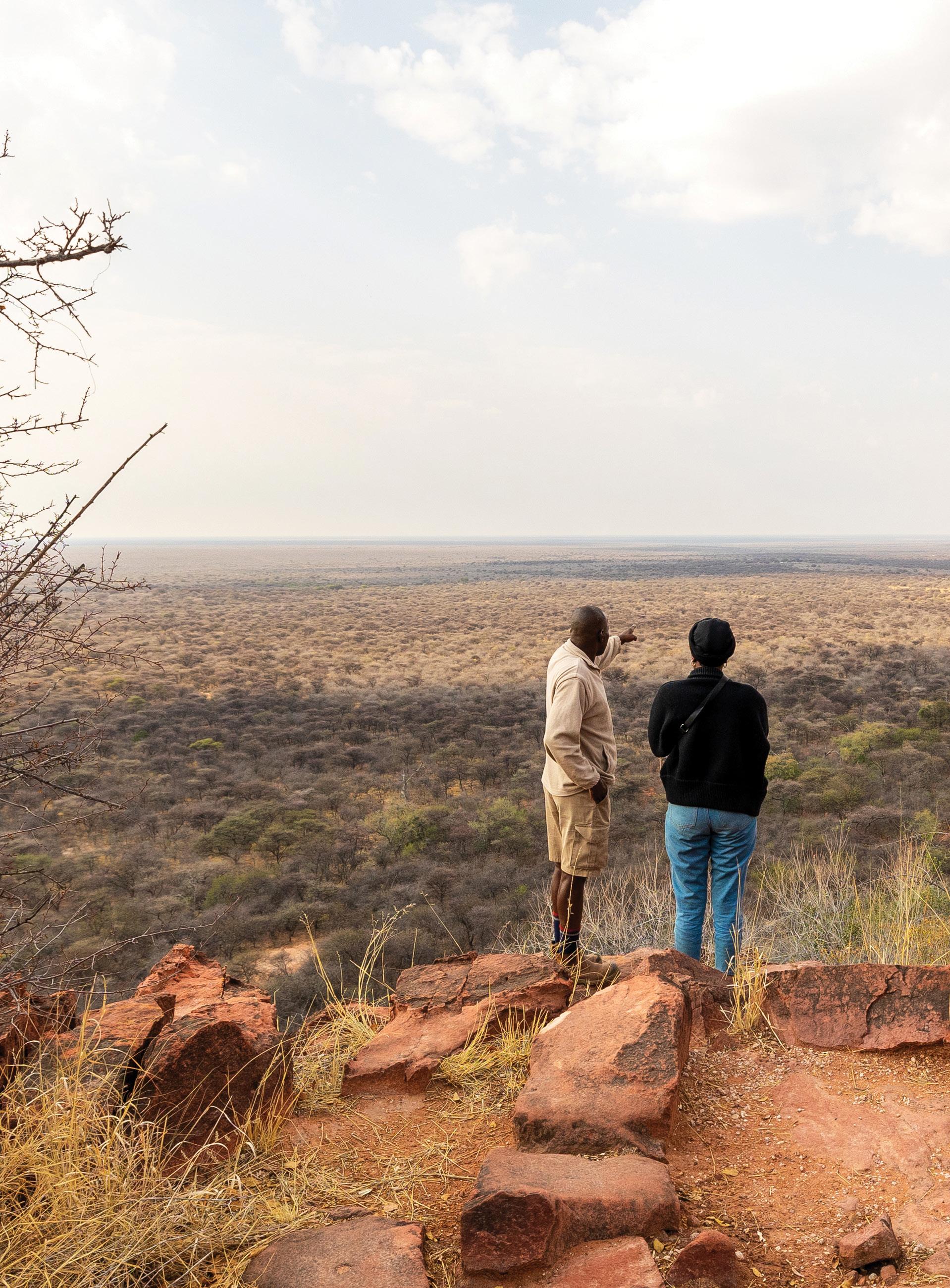

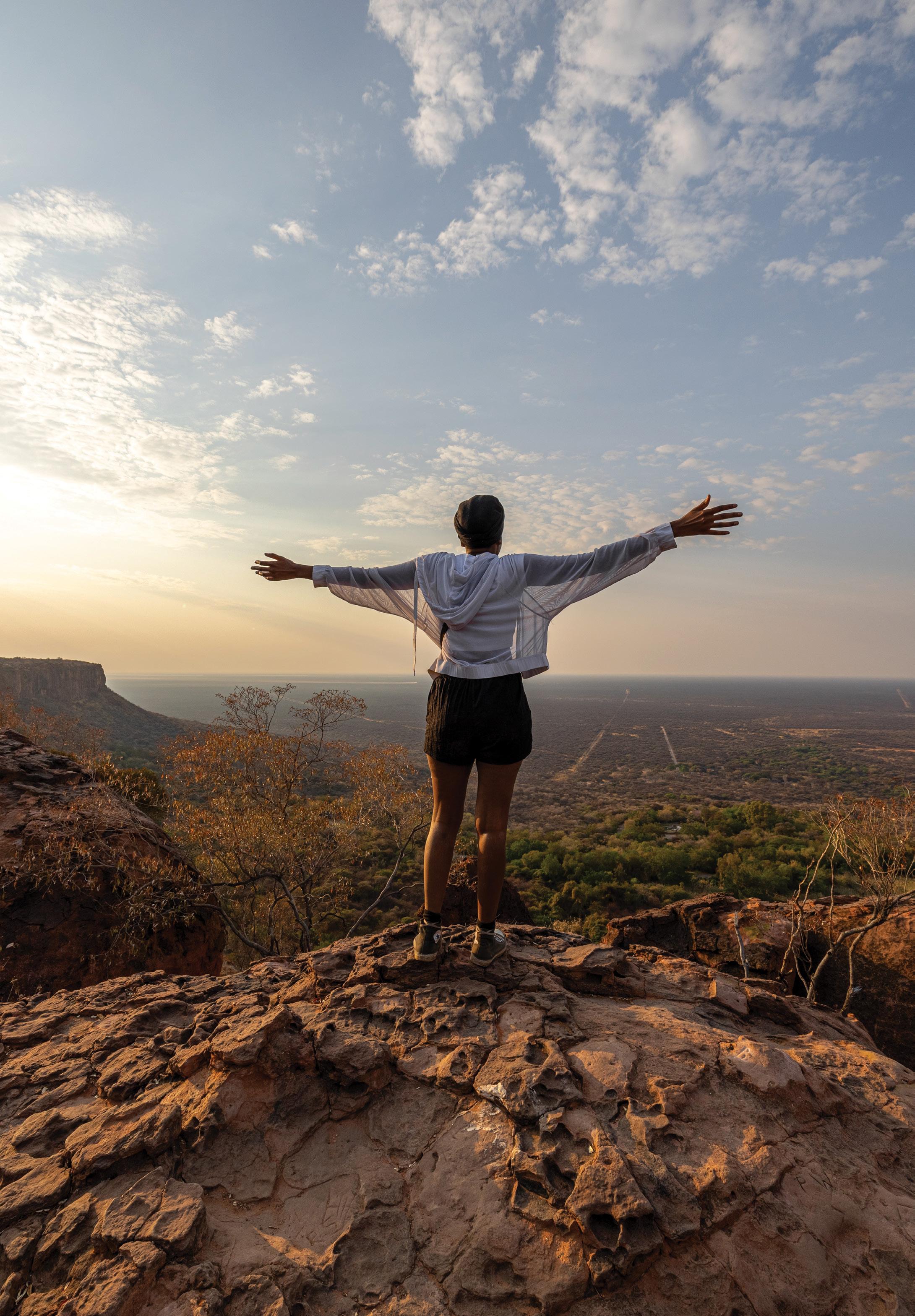

As someone who has travelled extensively across Namibia, I often feel like I have seen it all. But this country never ceases to amaze me. Every journey reveals something new, something magical that leaves me in awe. My recent trip to Waterberg Plateau Park was no exception – it felt like stepping into another world.
The experience began as soon as I turned off the B1 highway onto the C22. The sight of the Waterberg Plateau looming in the distance was truly magnificent, its silhouette standing proudly against the horizon. I had visited Waterberg on a day trip last year, but it is one of those places that never loses its grandeur. No matter how many times you visit, the sheer majesty of the plateau feels like a fresh revelation. From a distance, its presence is commanding, but it is not until you get closer that you truly appreciate its scale.
As you approach, the landscape begins to transform. Compared to the surrounding areas, the vegetation becomes remarkably dense. It feels like stepping into a forest (a word I rarely use to describe Namibia’s landscape). The lush greenery envelops you, making it feel like you have entered a hidden realm. By the time you reach the Waterberg Resort, the towering precipice of the plateau dominates the scene. The mountain face, with its rustcoloured rocks streaked with chartreuse and grey-mint lichen, is a striking feature. The textures and colours look almost too perfect, as if they had been carefully sculpted by hand.
The game drive was an adventure of its own. Unlike Etosha, where the animals often appear indifferent to human presence, Waterberg’s dense vegetation adds an air of mystery. Spotting wildlife feels like a game of hide-and-seek. Through the thick bush, I managed to catch a fleeting glimpse of a herd of gemsbok. It was like playing “I spy” with nature, challenging myself to spot movement amidst the greenery.


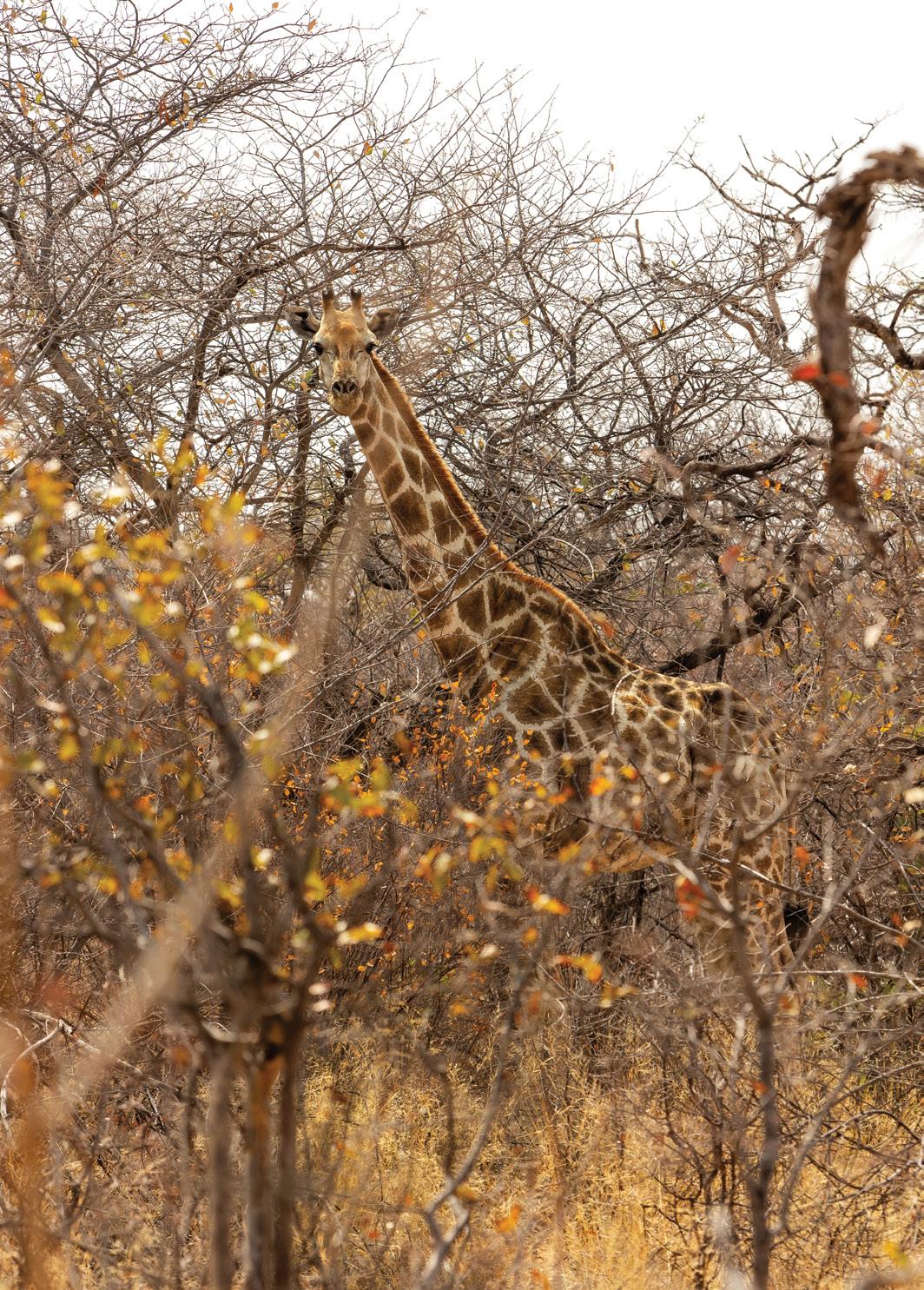


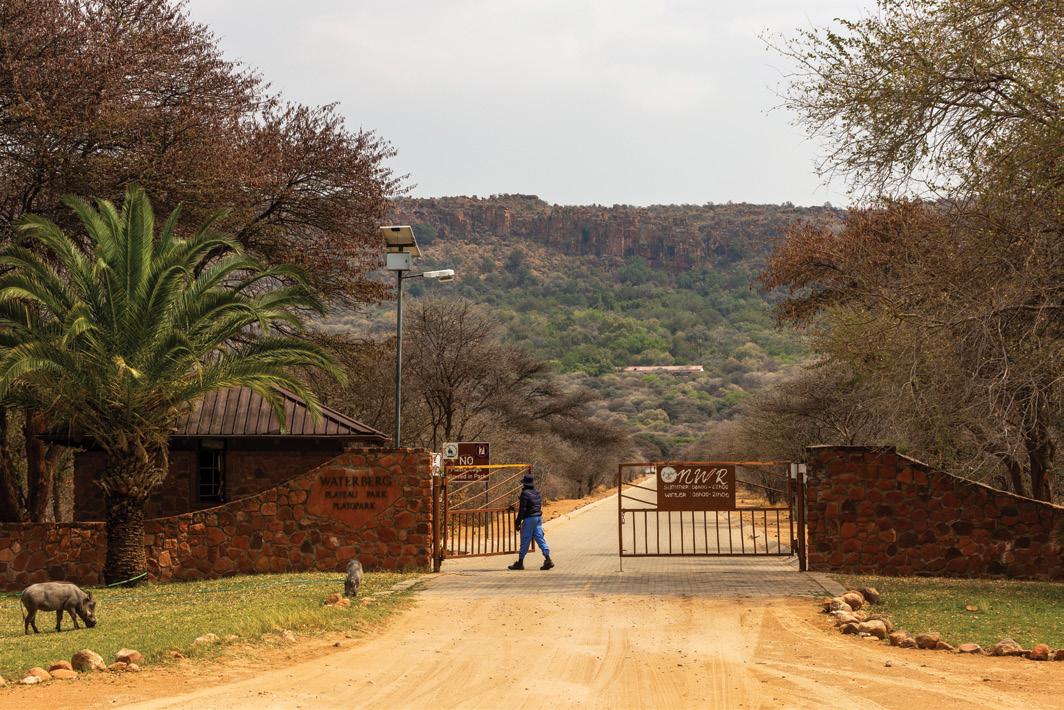


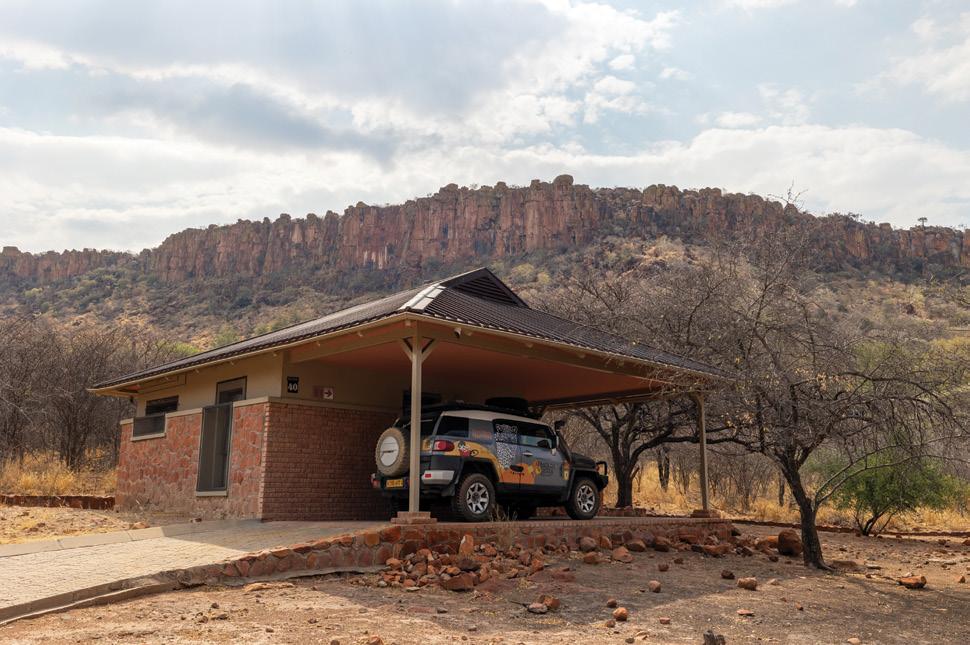

The highlight of the drive, however, was the appearance of a rhino and her calf. Seeing these magnificent creatures in their natural habitat was breathtaking. The dense bush provided just enough cover to make the sighting feel like a rare and special privilege. Reaching the top of the plateau was another unforgettable experience. Once you are on the plateau, you cannot quite grasp the scale, but standing at the edge quickly reminds you of the elevation. The panoramic view is nothing short of cinematic, evoking that same sense of awe I felt as a kid watching Jurassic Park. The plateau’s untouched beauty feels ancient, as if dinosaurs could stroll by at any moment without looking out of place.
Though the morning watering hole was quiet, I did not mind. The peacefulness of the scene was a gift in itself, punctuated by a giraffe quietly enjoying its breakfast. Its camouflage was so effective that I nearly missed it – another reminder of how seamlessly nature operates here.
The accommodation at Namibia Wildlife Resorts’ Waterberg Resort offers more than just the basics, providing a welcoming ambiance. The layout of the resort makes you feel like it is just you out in nature.
I left Waterberg inspired and longing to return. Next time, I would love to explore the surrounding areas more deeply, perhaps visit the nearby farms or seek out the petrified dinosaur tracks that I have heard so much about. The idea of walking in the footsteps of creatures from another era awakens my inner child. Waterberg is not just another destination; it is a portal to wonder, a place that reminds us of nature’s artistry and the timeless beauty of Namibia. TN

Text & Photographs Kirsty Watermeyer
Located just 22 kilometres northwest of Mariental, Hardap Dam, which is fed by the Fish River, covers a sprawling 25 square kilometres. While it serves as a vital source of electricity and water for the region, it is also a sanctuary for certain wildlife species, drawing many nature enthusiasts to make a stop here while in the south of Namibia.
Travelling southwards through Namibia from the capital Windhoek, we broke up the long road with a stopover at Hardap Dam. Staying in one of their five well-appointed VIP bungalows, we enjoyed the lovely features such as balconies for watching the sun set and cosy braai nooks with ample seating to enjoy a quintessential Namibian moment around the fire.
With the sun hanging low on the horizon, we set out to explore the area on foot. The low conical hills and the striking sapphire waters create a beautiful contrast, offering a refreshing escape from the arid landscape that surrounds this area.
Hardap Dam is renowned as an angler’s paradise, offering exceptional fishing year-round. However, what surprised me most was the story of the pelicans here. This is the home of one of Namibia’s most significant breeding colonies of great white pelicans (Pelecanus onocrotalus).
Great white pelicans are highly social and spend their time in large flocks. They are well suited for life on the water, with webbed feet and strong legs that help them swim and take off from the water. In the air, they look graceful, alternating slow wingbeats with gliding. You will often spot them flying in stunning formations, while they can travel long distances at a time.
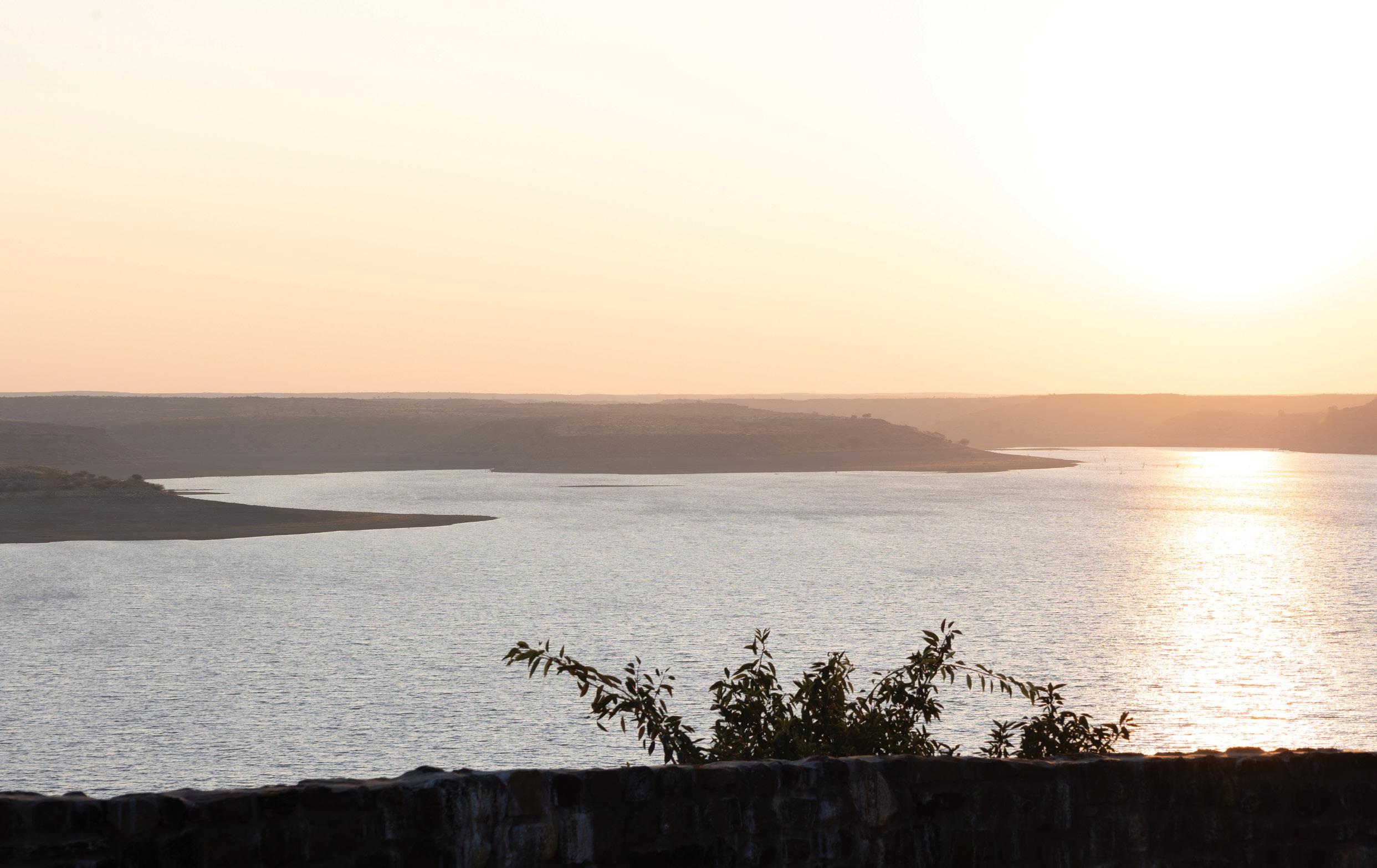
When it comes to food, these pelicans mainly feast on fish, using their huge bills to scoop them up from the surface instead of diving. Hardap Dam makes for a perfect breeding ground, with colonies setting up their breeding base on the small islands you find throughout the dam.
The number of pelicans at Hardap Dam has fluctuated over recent years. There was a huge increase from 800 to 4,024 birds between 1999 and early 2003, but this number dipped

to 1,522 between 2007 and 2012. However, it is worth noting that no comprehensive wetland surveys were done during this time. Either way, the numbers indicate that this is an important breeding spot for Namibia’s pelican population.
Great white pelicans prefer nesting in safe spots, like islands in dams, and nearly every year young pelicans successfully fledge at Hardap Dam. Interestingly, more pelicans are found inland than along the coast. Coastal colonies usually only have about 80 nests, while inland colonies can have over 1,000 nests.
Surrounding the southern sector of Hardap Dam is the Hardap Game Reserve, a vast 25,000-hectare wildlife sanctuary featuring a diverse landscape of dwarf shrub savanna and thorn trees. This reserve is home to a wide variety of Namibian wildlife, including common antelope species and even black rhino.
Birdwatchers will be thrilled by the abundant avian life here, with opportunities to spot everything from flamingos and fish eagles to the majestic pelican.
This brief overnight stop was hardly enough time to fully soak in and enjoy the captivating nature, the comfortable bungalows and the exceptionally friendly staff I met at Hardap Dam. So, whether you are a fishing enthusiast, a nature lover or simply seeking a peaceful getaway in Namibia’s stunning landscapes, Hardap Dam and the surrounding Hardap Game Reserve certainly have much to offer. TN
Hardap Resort is managed by Namibia Wildlife Resorts. To book your stay at Hardap Resort, visit: www.nwr.com.na
The low conical hills and the striking sapphire waters create a beautiful contrast, offering a refreshing escape from the arid landscape that surrounds this area.
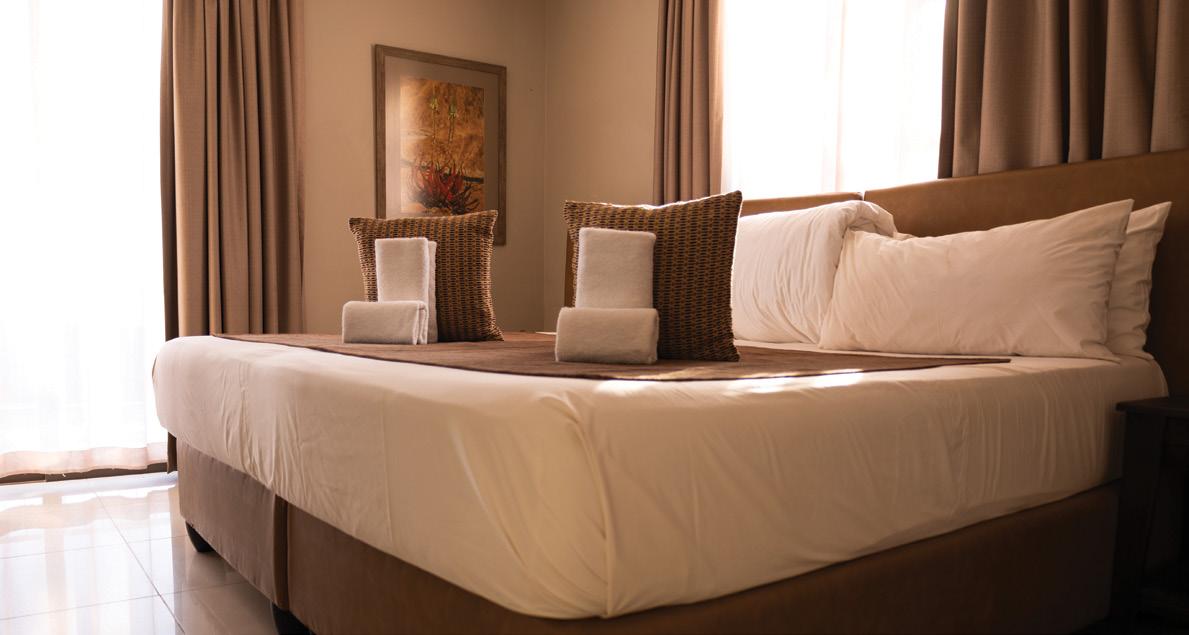
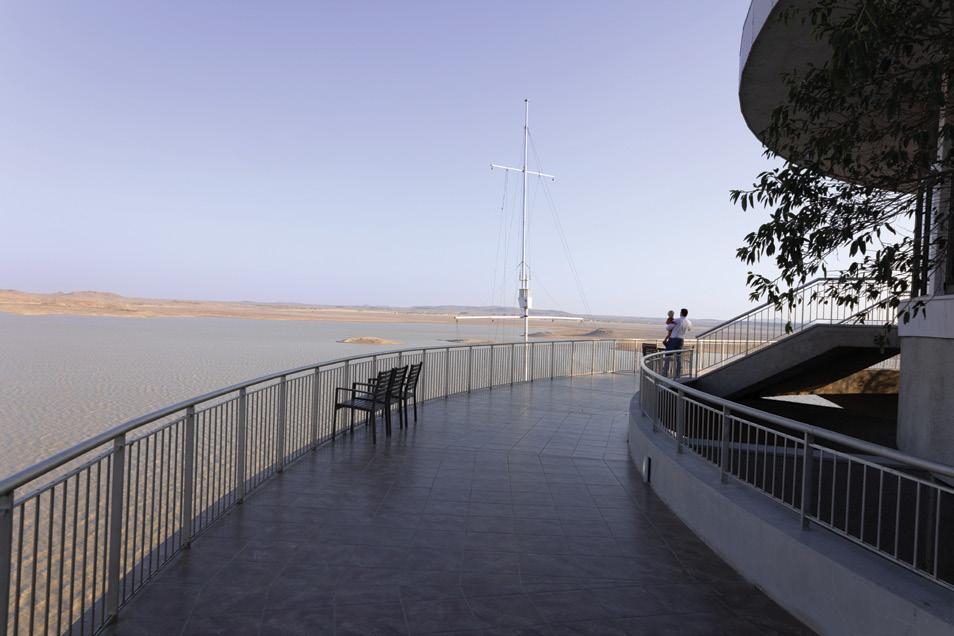


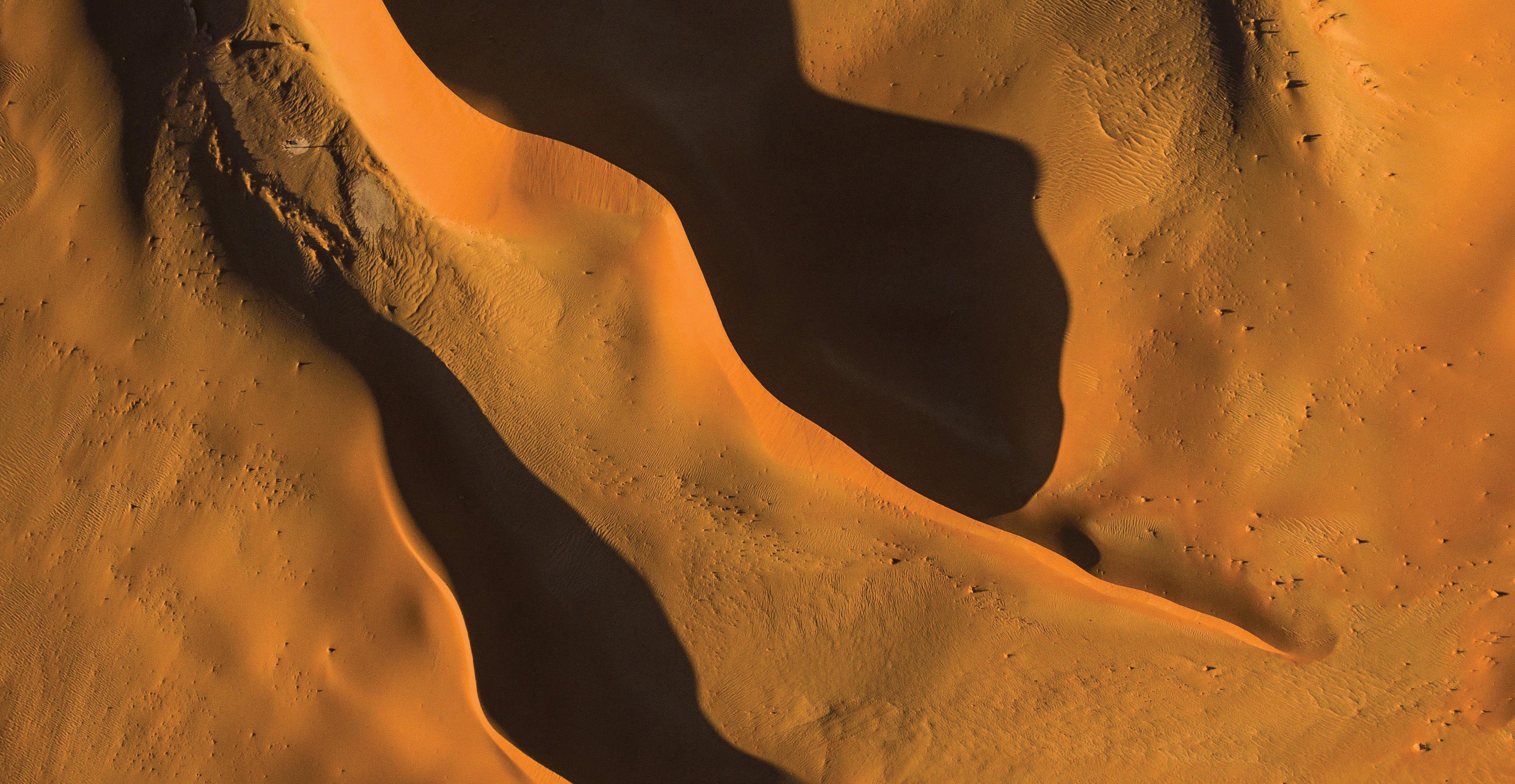

15.
16. Sesriem Campsite
17. Naukluft Camp
18. Hardap Resort
19. Duwisib Castle
20. Shark Island Resort 21. Fish River Canyon & Hobas Camp
22. /Ai-/Ais Hotsprings Spa 23. Mile 72 24. Mile 108
25. Jakkalsputz
Text Elzanne McCulloch
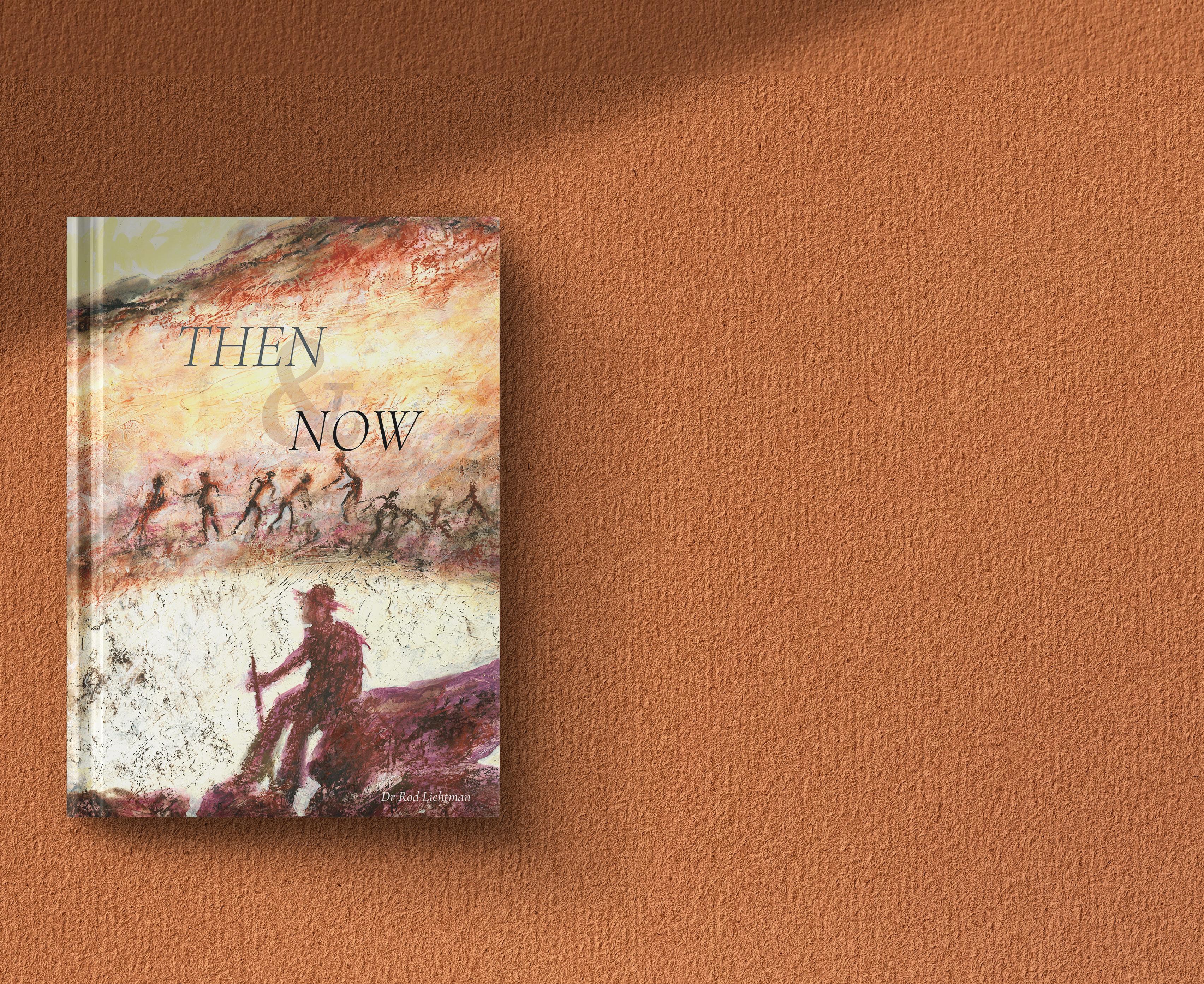
Few books manage to bridge the past and present with as much wit, depth, and irreverent charm as Then & Now by Dr. Rod Lichtman. This beautifully curated exploration of Bushman rock art juxtaposed with modern wildlife photography is not just a visual delight – it is a thoughtprovoking commentary on humanity’s evolving relationship with nature.
Lichtman’s narrative is both scholarly and playful, blending decades of field experience with an unfiltered, often humorous voice. From the sweeping plains of Namibia to the intricate carvings and paintings left behind by ancient hands, he takes readers on a journey that is part archaeology, part photography, and wholly captivating. Through each chapter, the book poses fundamental questions: Why did our ancestors depict animals in their art? What meaning did they assign to these creatures? And what do these same animals represent in our world today?
What sets Then & Now apart is its unique storytelling approach. Lichtman does not shy away from bold, provocative reflection. On conservation, on the contradictions of modern wildlife management, and even
on the absurdity of some academic interpretations of rock art. He invites readers to see these ancient paintings not as relics of a forgotten time, but as echoes of an ongoing conversation between humans and nature.
Visually stunning, Then & Now pairs breathtaking photography of wildlife – elephants, rhinos, lions, and more – with their ancient rock-art counterparts, offering a powerful contrast between past reverence and present-day realities. The book is both a love letter to the wild and a call to protect what remains.
For lovers of history, conservation, and the untamed beauty of Africa, Then & Now is an absolute must-read. Whether you are drawn to its captivating imagery, its rich historical insights, or Lichtman’s unfiltered musings, this book will leave you with a newfound appreciation for the wild creatures that have shaped our past… and continue to shape our future. TN
To order your copy, visit www.venture-events.com or email bonn@venture.com.na


Text &
Photographs
Kirsty Watermeyer
During the heat of summer, we made our way to Ondudu Safari Lodge, on the edge of the Erongo Mountains. Perched among towering granite boulders, the lodge’s cool, tented rooms each boast their own unique layout, cleverly tucked into the rocky terrain. Accessible by raised wooden walkways, the rooms invite you to simply unwind and soak in the positive energy radiating from the surrounding quartz-encrusted boulders. It is easy to see why one might be tempted to simply lounge in your room, basking in the tranquillity of the environment. But to truly connect with this extraordinary place, getting involved in the activities is where the magic happens.


The land here is arid, almost forgotten by time, yet undeniably spectacular. The rocks, rich with minerals, shift in colour as the light changes, creating a landscape that feels alive. The wildlife, though elusive, is ever-present, quietly waiting to be discovered during a sunset drive or one of the many hiking excursions that weave through this unspoilt part of the world.
Part of the Erongo Mountain Nature Conservancy and the region’s namesake, the Erongo Mountains form a roughly circular massif, created by the collapse of a volcano into its magma chamber. Over millennia, the slow-cooled igneous rock has resisted erosion, resulting in the stunning, bouldered landscape. These rocks, created by ancient underground volcanoes millions of
years ago, are like storytellers, each one bearing unique shapes and designs. Rocky outcrops offer shelter to the wildlife. While larger species like rhinos and leopards roam this land, the real thrill lies in spotting the smaller creatures – elusive and hard to find but appearing just often enough to allow our guide to share fascinating stories of their lives and their adaptations to the harsh, dry climate.
Here you will find a number of endemic Namibian species, including Hartmann’s mountain zebra, the Damara dikdik and the black-faced impala. The region is also home to nine endemic bird species, along with rare creatures like the Angolan dwarf python and the elusive black mongoose – all of which are fully protected in this conservation area. I was fortunate enough to catch a glimpse of a black mongoose during our visit. It was quick and skittish, almost like a shadow darting through the underbrush. For a moment, it was more of an illusion than a real animal.
There were other standout moments with the smaller yet equally special species living here. For example, we encountered not one, but two leopard tortoises, perfectly camouflaged amidst the rocks. The leopard tortoise, with its strikingly patterned shell, is a true survivor, a relic from a bygone era and a master of quiet resilience. We witnessed this resilience firsthand when one of the tortoises, after misjudging a rocky descent, tumbled down a boulder face more than twenty times its own height. Miraculously, it landed on its feet, stood up without missing a beat, and continued its journey as though nothing had happened.
Then there were the Damara dik-diks with their Bambi-like faces, dominated by their prominent snouts and large, dark eyes rimmed with white markings. These tiny antelopes, named after the high-pitched sound they make when startled, are skittish creatures by nature. Their distinctive alarm call comes through their highly flexible snouts, which also function as an efficient cooling system, preventing them from overheating. This clever adaptation also allows them to survive with minimal water.
Sometimes, the true essence of travel lies in the need to rest, unwind and connect with something unfamiliar and inspiring.
Birdwatchers will be delighted by the endemic species found here such as Hartlaub’s francolin, the Damara rockrunner, Whitetailed shrike and Monteiro’s hornbill. Rosy-faced lovebirds are plentiful, while other bird species like Rüppell’s parrot and Verreaux’s (black) and Booted eagles also call the area home.
The Erongo Mountains are among the oldest volcanic craters in the world, rising majestically with inaccessible gorges and towering rock formations. The best way to explore this land is on foot. We clambered over boulders on an early morning activity to reach Paula’s Cave, a national monument that houses beautiful rock paintings, believed to be over 2,000 years old. These historic artworks, displayed on the cave walls, were discovered by the archaeologist after whom the cave is named. Paula’s Cave is believed to have held significant spiritual meaning to the ancient Bushmen, who adorned its walls with many fascinating tales of life long ago.
There are many other activities to be enjoyed here, including various hikes that cater to different levels of fitness. Experienced guides are available to share insights into the region’s flora and fauna, or guests can choose from several self-guided walking trails. We also enjoyed a sunset drive around the reserve, after which we settled on top of a large boulder to watch the sun dip below the horizon. We watched the landscape transform, colours shifting dramatically across the sky. It was a moment of quiet awe, one that deepened our connection to this ancient land.
The lodge has twelve luxury tented rooms, each uniquely positioned and set against towering granite formations. Each tent is accessible via wooden walkways and stone steps, opening onto a spacious, shaded deck with breathtaking views. It is a magical place where the desert, mountains and bushveld ecosystems converge in perfect harmony.
Ondudu Safari Lodge exudes a quiet hospitality, much like what I imagine a butler in the corner would be like – almost invisible but appearing exactly then when you need something. Visiting this lodge felt like a reprieve for the soul. Beyond the healing energy of the rocks, the breathtaking beauty of the landscape and the profound silence, everything here works together as a tonic for the spirit. The unobtrusive yet always helpful nature of the staff made this visit feel like the ultimate form of relaxation –the kind we all crave during holidays and travel breaks.
Travelling calls to us for many reasons, whether to immerse ourselves in new cultures, witness the wonders of wildlife or simply escape the daily grind. Yet, sometimes, the true essence of travel lies in the need to rest, unwind and connect with something unfamiliar and inspiring. Ondudu Safari Lodge provides all of this: a sanctuary of relaxation, comfort and profound connection in a setting that evokes awe and wonder. TN


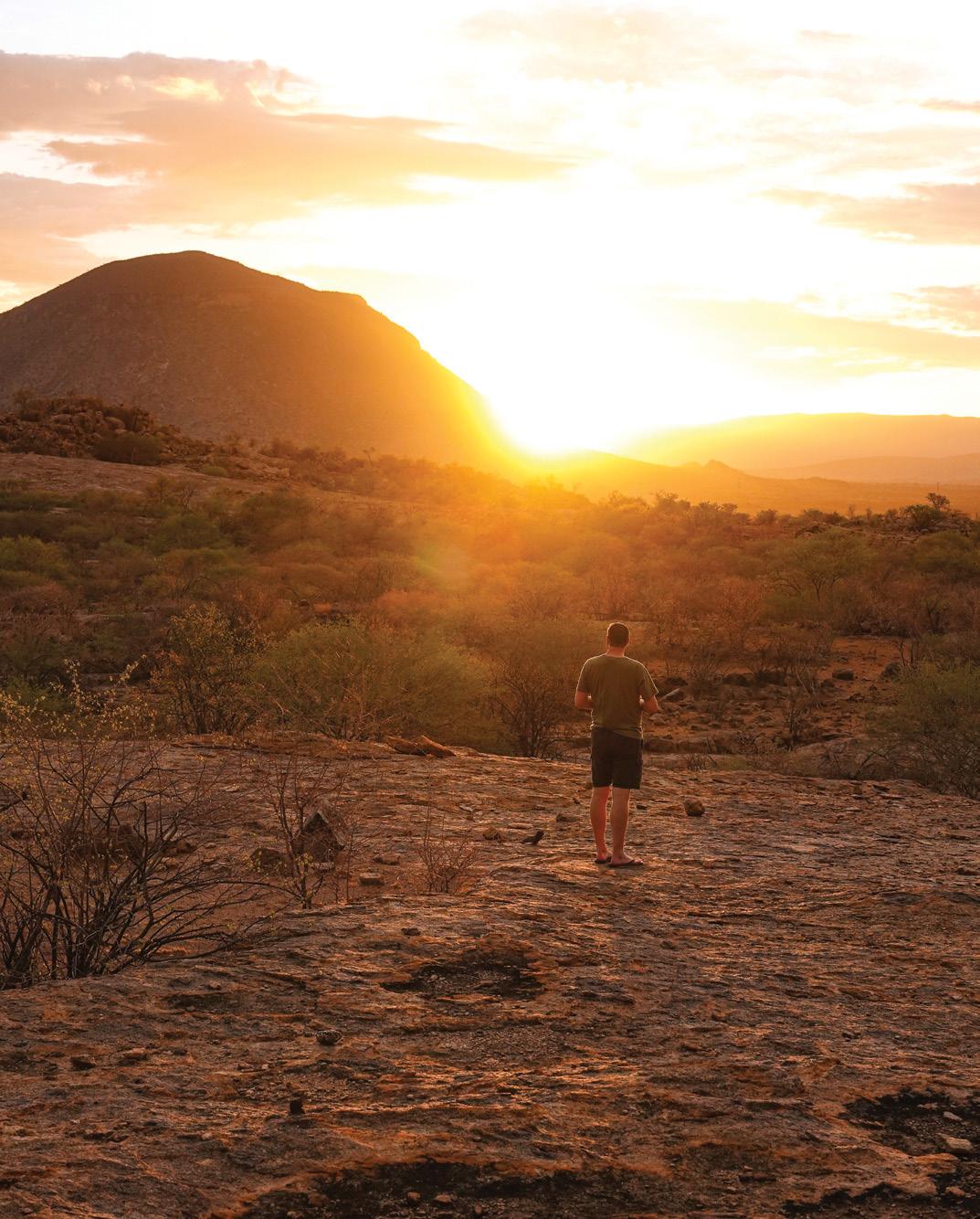
For more information about Ondudu Safari Lodge, visit: www.journeysnamibia.com


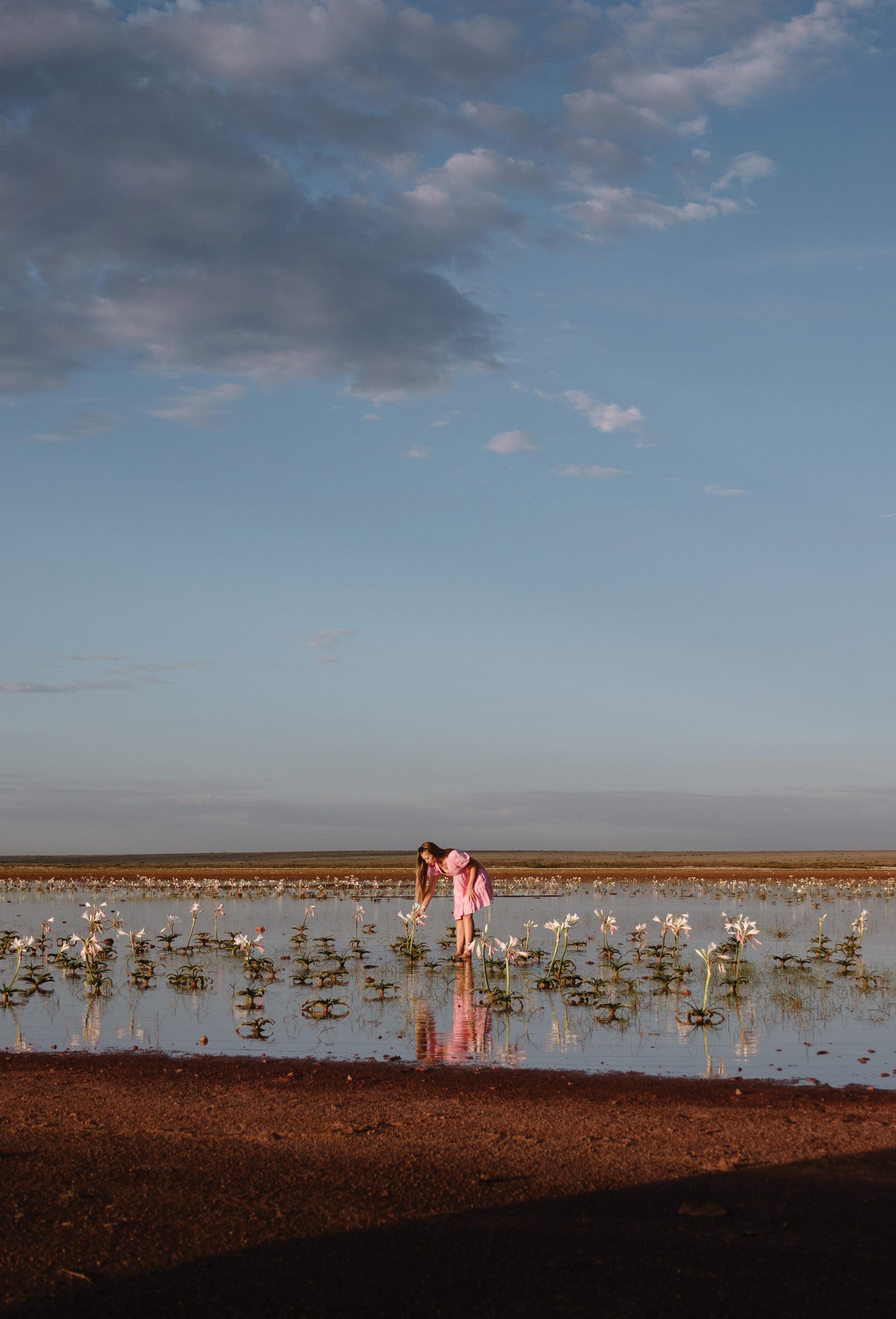
It was as if the land itself had been waiting for this moment, and now that it had arrived, it was celebrating in the only way it knew how - by blooming in full, glorious splendour.
It’s hard to put into words the kind of beauty that makes you stop, take a deep breath, and realise—right there, in that moment— you’re witnessing something rare, something fleeting, something utterly magical. But I’ll try.
I made the drive from Windhoek, chasing whispers of the Sandhof lilies. These extraordinary flowers bloom only when nature grants them the perfect gift: rain, and lots of it. They don’t follow schedules or care about convenience. One day they’re there, standing proudly in shallow pools of water, delicate yet resilient, a sea of white and pink stretching into the distance. The next, they could be gone. If you hear they’ve bloomed, you don’t think twice— you go.
Maltahöhe was my gateway. After dropping my bags at the hotel, I wasted no time. The lilies were calling. The road to Sandhof Farm was gravel, dotted with shallow pools of rainwater—silent evidence of the life-giving storms that had swept through the land. The drive was easy, peaceful even, the kind where the hum of the tyres on the gravel and the vast openness of Namibia’s landscapes make you feel like you’re heading toward something special.
Then, a sign. “Sandhof Lilies.” A simple direction, but it might as well have said, Welcome to Wonderland
About 500 metres in—maybe a kilometre—I caught my first glimpse. A flash of pink in the distance, a tease of what was to come. Then, as I rounded a bend, there they were. An entire pan, brimming with lilies, standing tall in the water. Some white, some pink, all of them reflecting the golden afternoon light. It was breathtaking.
I stepped out of the car, camera in hand, but for a moment, I didn’t even think about taking photos. I just looked
The scene was surreal. These flowers, delicate as they were, had risen from the cracked earth, floating in water that barely seemed to touch their stems. It was as if the land itself had been waiting for this moment, and now that it had arrived, it was celebrating in the only way it knew how—by blooming in full, glorious splendour.
As I drove around the massive pan, taking it all in, I stumbled upon a scene that made the experience even richer. A couple of cars were parked, camping chairs were out, and dogs ran freely through the shallow water, laughter carried across the open space. The kind of scene that makes you realise how lucky some people are to have this in their backyard.
One of those people was Hendrik, the owner of the farm.
Friendly, warm, and clearly passionate about this rare spectacle, he greeted me like an old friend. Without hesitation, he shared his insights— where to go for the best views, what paths to take, where the lilies were most concentrated. He wanted me to experience the lilies in their best light, and thanks to him, I did.



If the lilies were stunning in the afternoon, sunrise was something else entirely.
I arrived just as the world was waking up. The sky stretched out above me in soft hues of pink and orange, and the lilies, as if greeting the new day, stood fresh and dewy, their petals open wide. The still water reflected the sky, creating a seamless blend of land and air, of light and bloom.
Barefoot, I stepped into the pan, feeling the cool mud squeeze between my toes. It was messy. It was cold. And it was perfect. Hendrik appeared again, checking in, making sure I was getting the experience I’d hoped for. He answered every question I had with patience, with the kind of knowledge that only comes from truly loving a place.
And then, just like that, it was time to go.

The Sandhof lilies don’t wait for anyone. They don’t last long—maybe a week, maybe two, maybe less. They rise from the water, dance in the wind, and then fade, disappearing as suddenly as they arrived.
But for those lucky enough to witness them, even just once, they leave a mark. A reminder that some things in life are precious precisely because they are fleeting.
If you ever hear that the lilies are blooming, don’t hesitate. Pack a bag, fill up the tank, and go. Trust me—it’s worth it. TN
KOLMANSKOP: A GLIMPSE INTO NAMIBIA’S DIAMOND MINING PAST
Kolmanskop, Namibia’s most iconic ghost town, offers a captivating window into the past. Once a bustling diamond mining hub in the early 20th century, it now stands as a silent testament to a bygone era. Guided tours, either in person or via an app, lead visitors through the town’s once opulent world – a place where wealth and luxury once thrived. The eerie emptiness, enhanced by the desert sands slowly reclaiming the buildings, provides photographers with endless opportunities to capture striking, otherworldly shots. A visit to Kolmanskop is sure to linger in your memory long after you have left this hauntingly beautiful corner of Namibia.

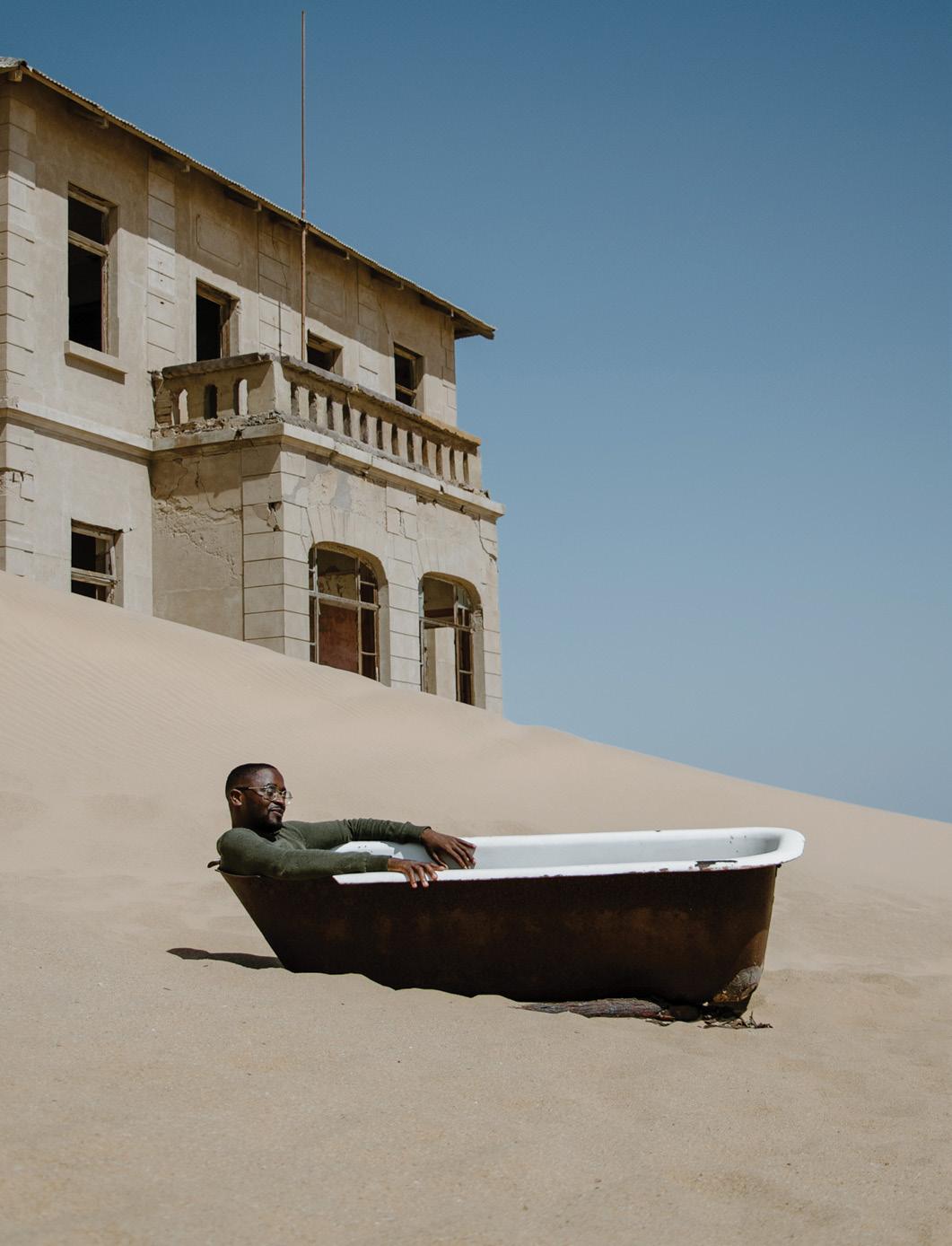
Lüderitz, a charming coastal town, was once the epicentre of Namibia’s diamond rush in the early 1900s. Today, it offers a fascinating blend of history and modern-day revival. Nestled between the desert and the ocean, Lüderitz boasts wellpreserved colonial architecture that tells the story of a place where wealth came and went in waves. Visitors can explore its heritage buildings, enjoy the tranquil atmosphere and take in the stunning coastal views.
For a deeper dive into the region’s history, make your way to Dias Point. In 1488, Portuguese explorer Bartolomeu Dias sailed into what we now know as Lüderitz Bay during his momentous voyage around the Cape of Good Hope. To mark his visit, Dias placed an engraved stone and a cross on a rocky outcrop that still stands today, defying the gale-force winds and crashing surf.
Make sure to stop in at Namibia’s first Maritime Museum, housed in the historic Lüderitz Old Power Station on Dias Street. This world-class museum spans five floors and brings the town’s deep maritime history to life, from tales of adventure and survival to the pressing challenges of modern marine conservation. It is a captivating journey through time, shedding light on the seafaring heritage that shaped Lüderitz’s past.
For a different perspective on Lüderitz’s stunning coastal landscape, why not embark on a catamaran cruise? Glide along the waters to see dramatic bays and islands, home to abundant wildlife, including the Heaviside’s dolphin and the African penguin. This serene boat ride offers an entirely fresh view of the untouched beauty of Lüderitz’s coastline and is the perfect way to take in the area’s natural splendour.
The Fish River Canyon is a must-see for any traveller to southern Namibia. Its sheer size and the interplay of light and shadow on the rugged rocks create a breathtaking visual spectacle. Stretching over 160 km long, 27 km wide, and reaching depths of up to 550 metres, it is the second-largest canyon in the world.
Formed millions of years ago, the canyon offers stunning views and a variety of hiking opportunities. Whether you opt for a day hike or a multi-day trek, you are bound to explore deep gorges and striking rock formations.
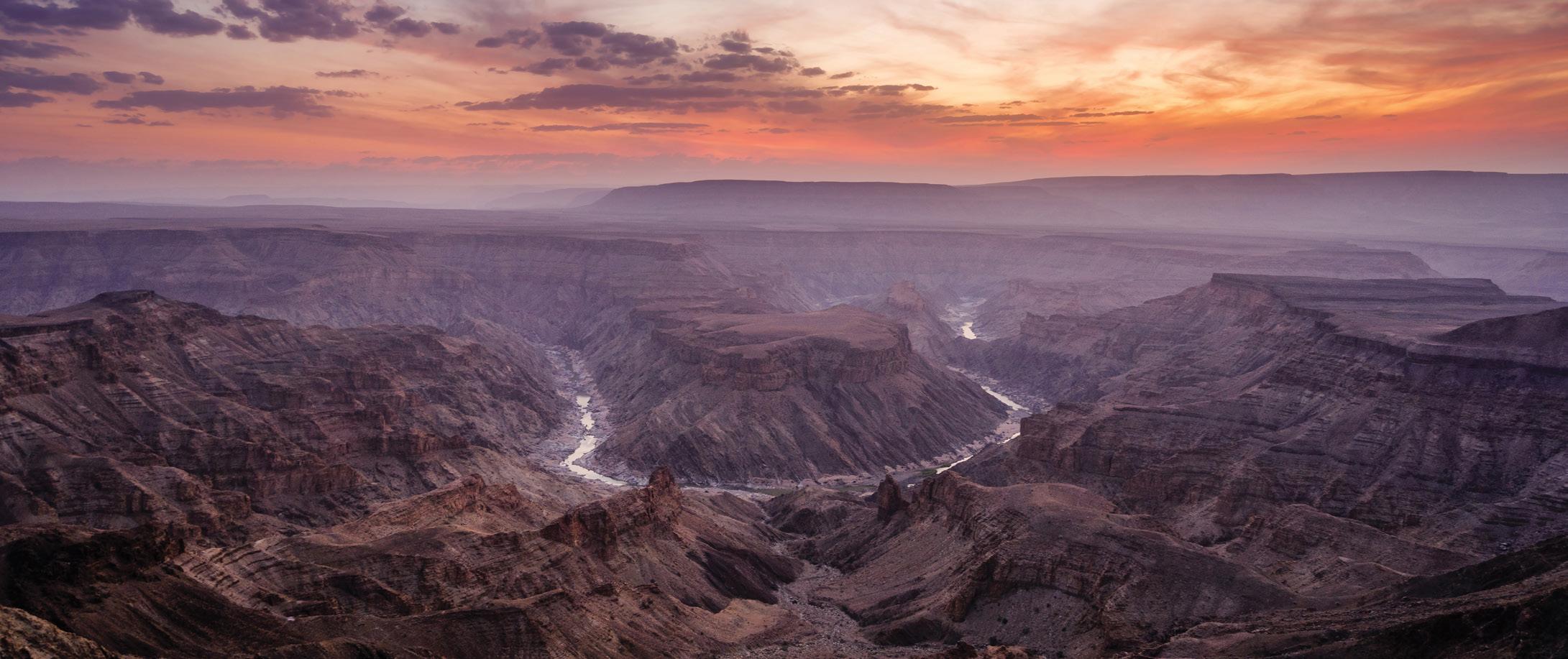

Tsau //Khaeb National Park (formerly known as Sperrgebiet National Park) was proclaimed in 2008 and covers 26,000 km² of semi-desert terrain, making it one of the world’s top 35 biodiversity hotspots. Part of the Succulent Karoo biome, which stretches into South Africa, this area is rich in endemic succulent species – many of which are found nowhere else on the planet. Despite being largely undeveloped, sections of the park can be explored with registered concession holders.
The Sperrgebiet, or “forbidden territory”, has been off-limits to the public for nearly a century due to its diamond wealth, preserving its unique and pristine landscape. The park now protects 90% of the remaining Succulent Karoo habitat, home to over 2,400 endemic plant species.
Visitors can experience this untouched wilderness through guided tours, which include the ghost towns of Elizabeth Bay and Pomona, the Bogenfels Rock Arch, and Märchental, the “Fairy Tale Valley” where diamonds were once so abundant they could be picked up by the handful.
Other highlights include day and overnight trips to Dagger Rocks, Douglas Bay and the meteorite impact crater at Roter Kamm, as well as 4x4 dune driving, sandboarding and kayaking in the adventure zone of Oranjemund. Lüderitz serves as the starting point for guided 4x4 excursions into the Namib-Naukluft National Park, with options to visit Saddle Hill, Conception Bay and other historic sites.




No journey to southern Namibia is complete without experiencing the awe-inspiring beauty of Sossusvlei and the Namib-Naukluft Park. Renowned for its towering dunes and stark desert vistas, this region offers a glimpse into one of the planet’s most ancient and pristine landscapes. The dunes at Sossusvlei, some of which reach heights of over 300 metres, are among the tallest in the world. Climbing them at sunrise rewards visitors with breathtaking views as the golden light dances across the rippling sands.
The Namib-Naukluft Park, which encompasses Sossusvlei, is a haven for diverse wildlife adapted to the desert’s harsh conditions. From gemsbok and springbok to the elusive desertadapted brown hyena, life here is a testament to resilience. Whether hiking the Sesriem Canyon, exploring the shimmering salt pans, or marvelling at the vastness of the Namib Desert, this region embodies the raw beauty and grandeur of the south. TN


Stretching across vast swathes of the Namib Desert, the Namib Sand Sea is a UNESCO World Heritage Site and a truly unique natural phenomenon. It is one of the only places on Earth where fog sustains a thriving desert ecosystem, supporting life in an otherwise arid environment.
This incredible expanse of ever-shifting dunes, sculpted over millions of years, is a geological masterpiece. The interplay of light and shadow on the dunes creates mesmerising patterns, captivating photographers and nature lovers alike. Visitors can explore the Namib Sand Sea through guided 4x4 excursions or scenic flights that reveal its vast scale and intricate beauty from above.
The Namib Sand Sea is not only a visual spectacle but also a reminder of the delicate balance of life in the desert, making it a must-see for anyone exploring the wonders of southern Namibia.
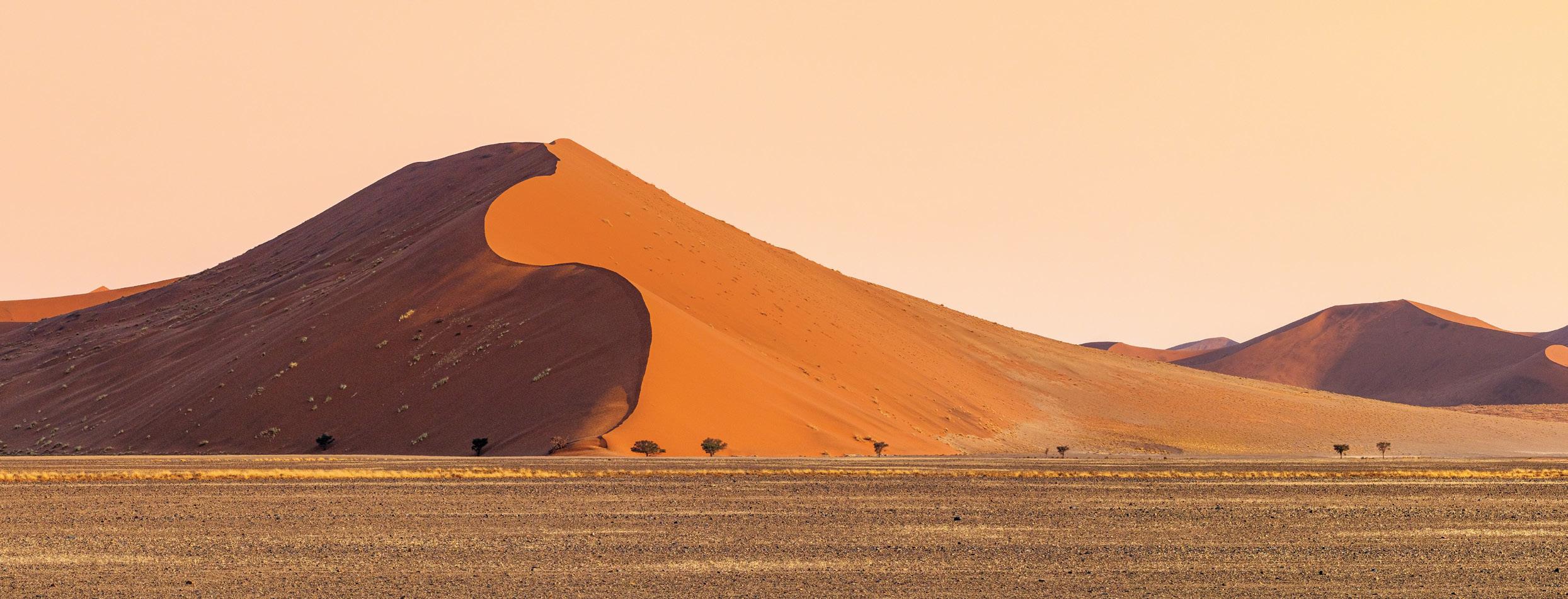

Text & Photographs Pompie Burger
One of the most common questions visitors to Namibia ask is: Where should they go for birding? As one of the most knowledgeable birders in Namibia and Southern Africa (self-proclaimed), I can confidently provide expert advice on where, when, and why to go birding in this incredible region.
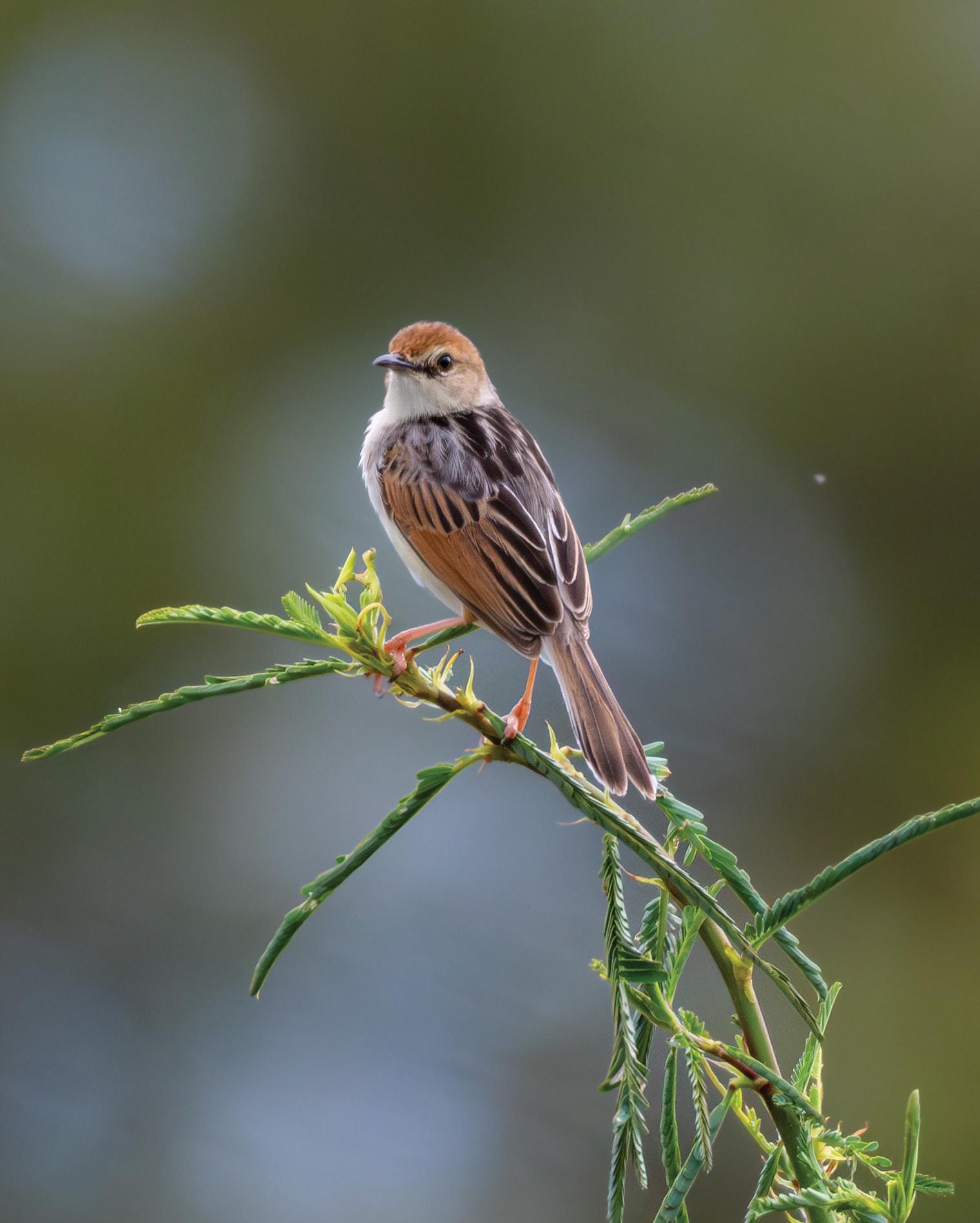
The Zambezi Region is undoubtedly Namibia’s most prolific birding area, boasting an impressive diversity of species. Of a possible 700+ bird species recorded in Namibia, over 450 can be found here, making it an essential destination for any birder.
Timing is crucial in birding, though the best time is always "as soon as possible!" However, the prime birding season is during the summer months when migratory species arrive, adding excitement and new ticks to your list. The ideal period to visit is from October to early January. Though these are the hottest months of the year, the rewards far outweigh the discomfort. Most migrants arrive in October, with some earlier and some later. Their arrival coincides with a period when vegetation is still manageable, making bird spotting significantly easier. If the rainy season starts early, it is best to adjust your travel dates to accommodate the arrival of "rain birds."
Certain species, such as the Southern Carmine Bee-eaters and African Skimmers, begin their breeding season by late August. If they are on your must-see list, it’s best to visit early to witness their spectacular colonies.
It is often better to concentrate on one area over consecutive days rather than covering too much ground. This focused approach allows for a deeper understanding of the region, better birding opportunities, and the flexibility to adjust your itinerary as needed.
Early morning and late afternoon are the prime birding hours due to cooler temperatures and increased bird activity. Midday is best spent under a large tree at your campsite, where you’ll likely spot numerous species resting in the shade. Raptors take advantage of thermals generated by midday heat, making this a good time for spotting them soaring overhead.

Bwabwata National Park along the Kwando River is one of the richest birding spots due to its diverse habitats, including riverine forests, floodplains, and savannah woodlands. The broadleaf forests are an excellent place to find Racquet-tailed Rollers, Black-headed Orioles, White-crested Helmet-Shrikes, Green Pigeons, and Meyer’s Parrots. Keep an eye out for the elusive Narina Trogon—though I won't make any promises! Along the river and floodplains, you can expect to see African Marsh Harriers, Lesser Jacanas, Half-collared Kingfishers, Wattled Cranes, Bat Hawks, Slaty Herons, and Rufousbellied Herons. A stop at a seasonal pan may reward you with sightings of Little Bitterns or, if you're lucky, a Western Yellow Wagtail. Raptors such as the Western Banded Snake Eagle, Ayres’s Hawk-Eagle, and European Honey Buzzard are also frequently spotted in the area.
Mudumu and Nkasa Rupara National Parks, located further south, provide excellent birding opportunities with various lodges offering ideal conditions for spotting a range of specials. Among the birds to look out for here are the Copper Sunbird, Bradfield’s Hornbill, Black Cuckoo, Klaas’s Cuckoo, and African Emerald Cuckoo. These parks also offer a good chance of spotting Arnot’s Chat, Denham’s Bustard, Dickinson’s Kestrel, Lizard Buzzard, and Dark Chanting Goshawk.
East of Katima Mulilo, lodges such as Caprivi Houseboat Safari Lodge and Caprivi River Lodge provide birding opportunities along the river. Their expert guides can help you find the African Finfoot, Yellow-fronted Tinkerbird, Schalow’s Turaco, Trumpeter Hornbill, Yellow-throated Leaflove, and Eastern Nicator, all of which are possible lifers in this area.
Birding along the Zambezi River, particularly along the D3509, is an unforgettable experience. Among the highlights are the elusive Shelley’s Sunbird (which some claim to be extinct as
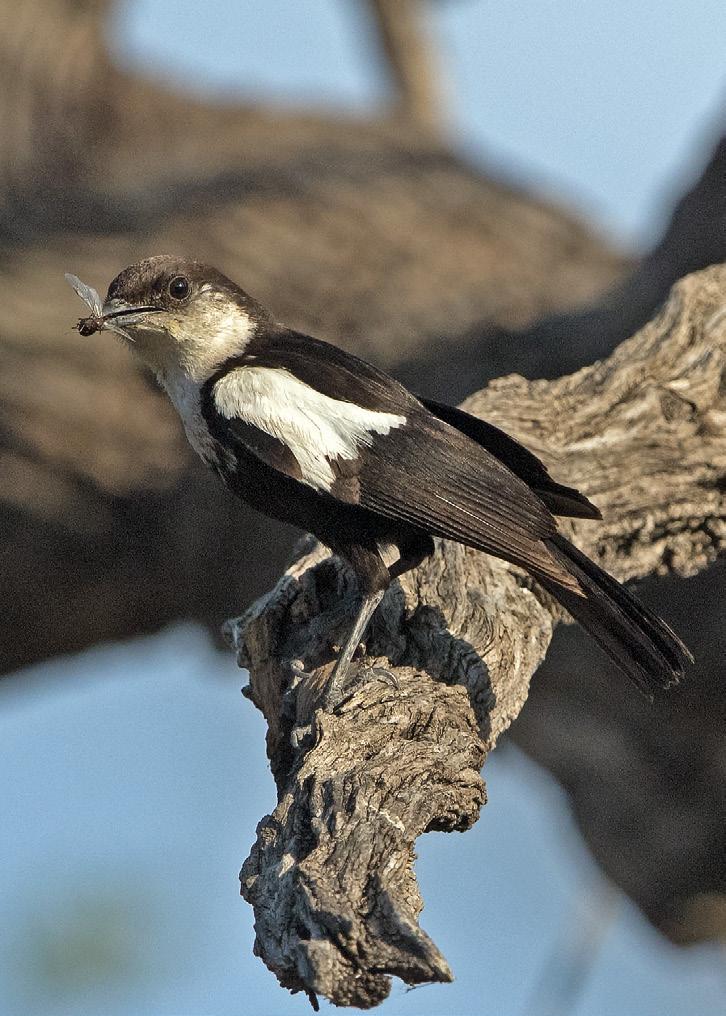

TICK THEM OFF!
Racquet-tailed Roller
Black-headed Oriole
White-crested HelmetShrike
Green Pigeon
Meyer’s Parrot
Narina Trogon
African Marsh Harrier
Lesser Jacana
Half-collared Kingfisher
Wattled Crane
Bat Hawk
Slaty Heron
Rufous-bellied Heron
Little Bittern
Western Yellow Wagtail
Western Banded Snake Eagle
Ayres’s Hawk-Eagle
European Honey Buzzard
Dickinson’s Kestrel
Lizard Buzzard
Dark Chanting Goshawk
Copper Sunbird
Bradfield’s Hornbill
Black Cuckoo
Klaas’s Cuckoo
African Emerald Cuckoo
Arnot’s Chat
Denham’s Bustard
African Finfoot
Yellow-fronted Tinkerbird
Schalow’s Turaco
Trumpeter Hornbill
Yellow-throated Leaflove
Eastern Nicator
Shelley’s Sunbird
African Rail
Rock Pratincole
Collared Pratincole
Black-winged Pratincole
Luapula Cisticola
Black-crowned Tchagra
Black Coucal
White-crowned Lapwing
Black-bellied Bustard
Southern Weaver
Brown-throated Weaver
Pel’s Fishing Owl
White-backed Night Heron
African Skimmer
Rosy-throated Longclaw
Purple-banded Sunbird
Collared Palm-Thrush

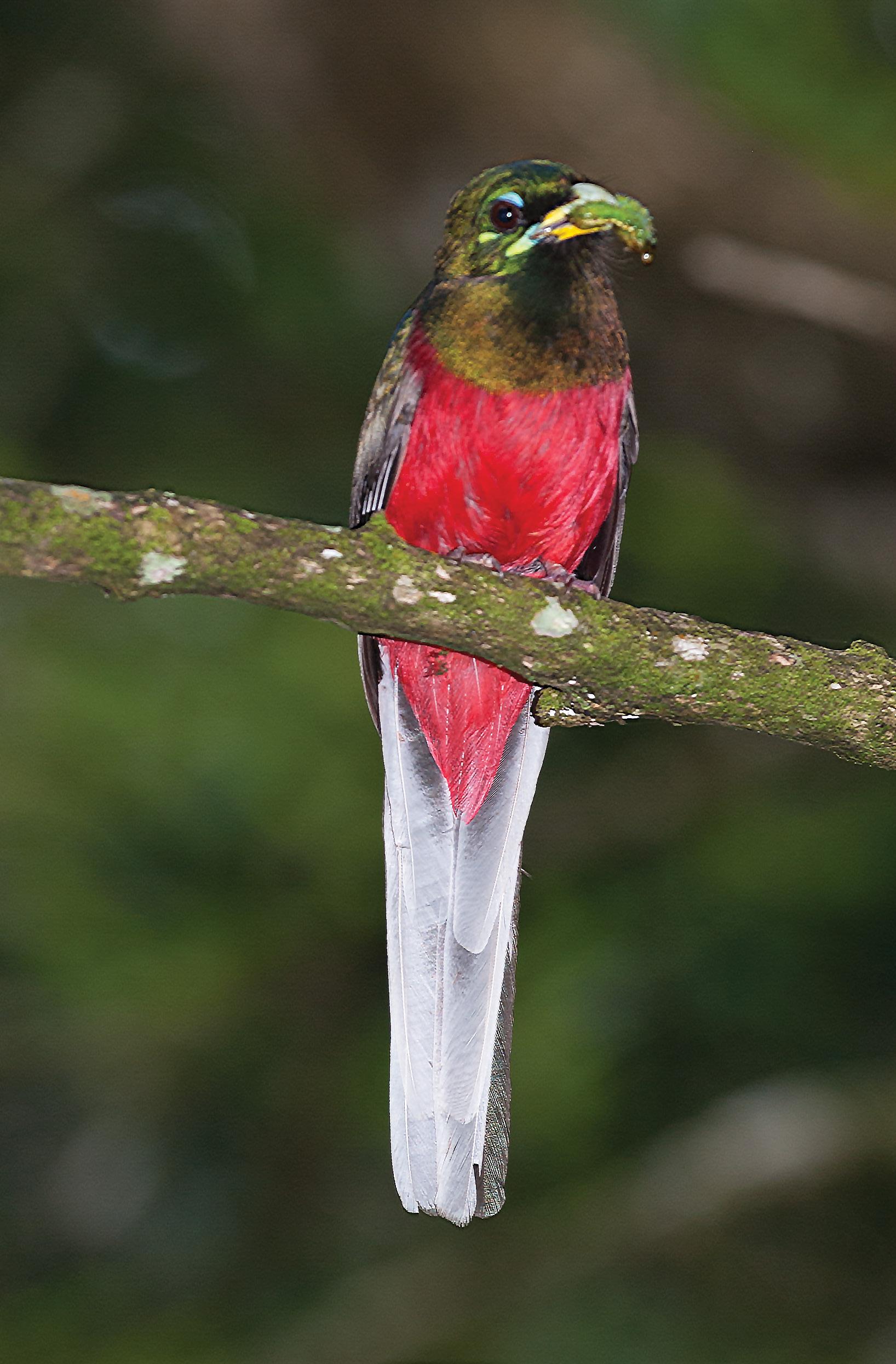


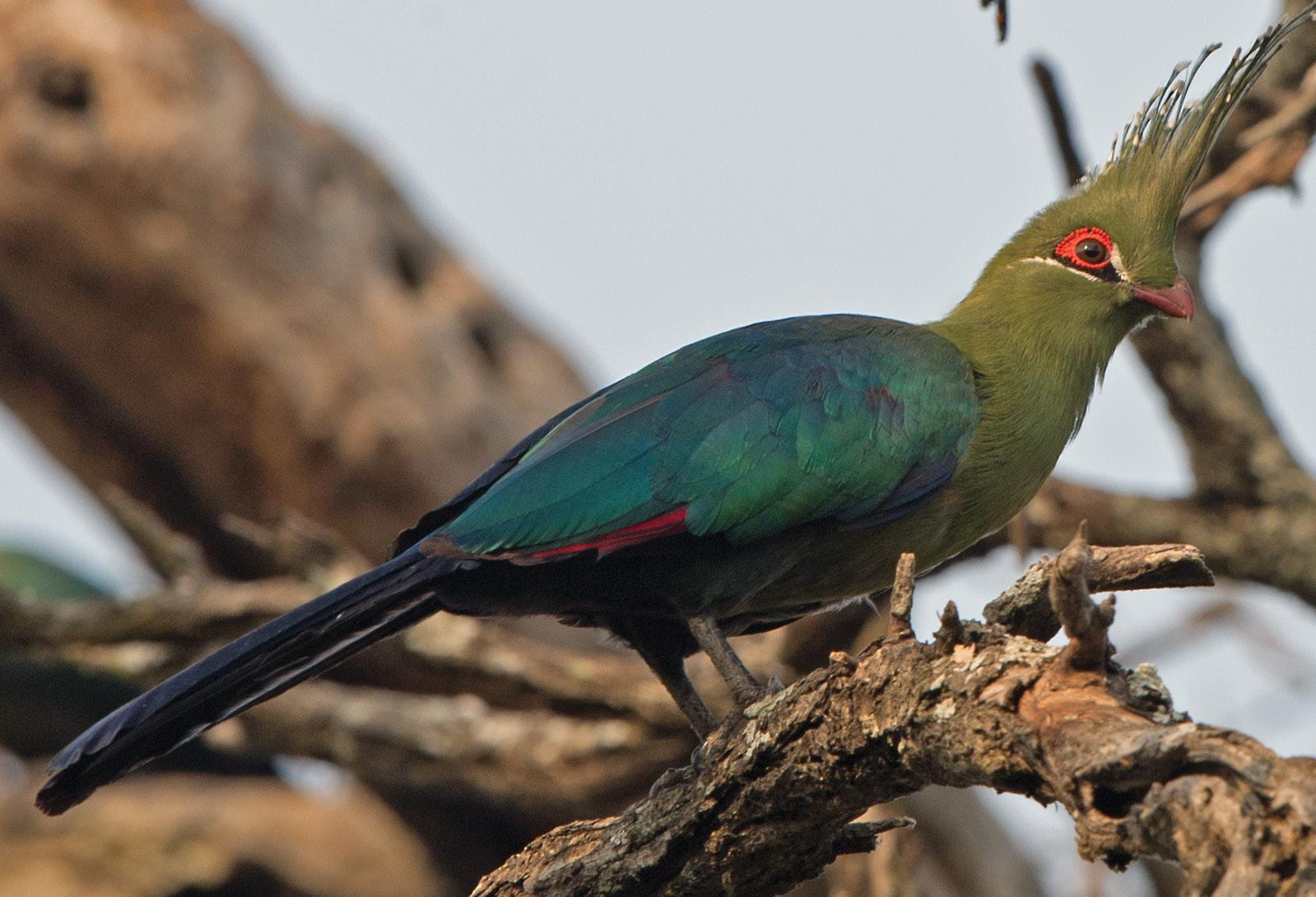

it remains unseen by mere mortals like myself), African Rail, seasonal pans filled with Rock, Collared, and Blackwinged Pratincoles, Luapula Cisticola, Black-crowned Tchagra, Black Coucal, White-crowned Lapwing, and Black-bellied Bustard. A boat trip might reward you with the rare Pel’s Fishing Owl or White-backed Night Heron. The African Skimmer breeding colonies on the river’s sandbanks are a must-see spectacle, though it requires an entire day to truly appreciate the experience.
Further east, along the Chobe River floodplains near Serondela Lodge and Chobe River Camp, birders can find some of the region’s special sightings, including the Rosy-throated Longclaw, Purple-banded Sunbird, and Collared Palm-Thrush.
Of course, this is just the tip of the hippo’s ears! Many more species could be mentioned, but these are the birds we actually saw and photographed—not just promises. I’ve chosen not to rate specific lodges or campsites because the experience varies from person to person. Instead, I encourage you to explore, take your time, and truly immerse yourself in the Zambezi’s birding paradise.
If you are a serious twitcher looking for ultra-rare species, I highly recommend booking a specialised birding safari with an expert guide who can help you track down your lifers—including birds that may not even exist!
Happy birding! TN

Timing is crucial in birding, though the best time is always "as soon as possible!"
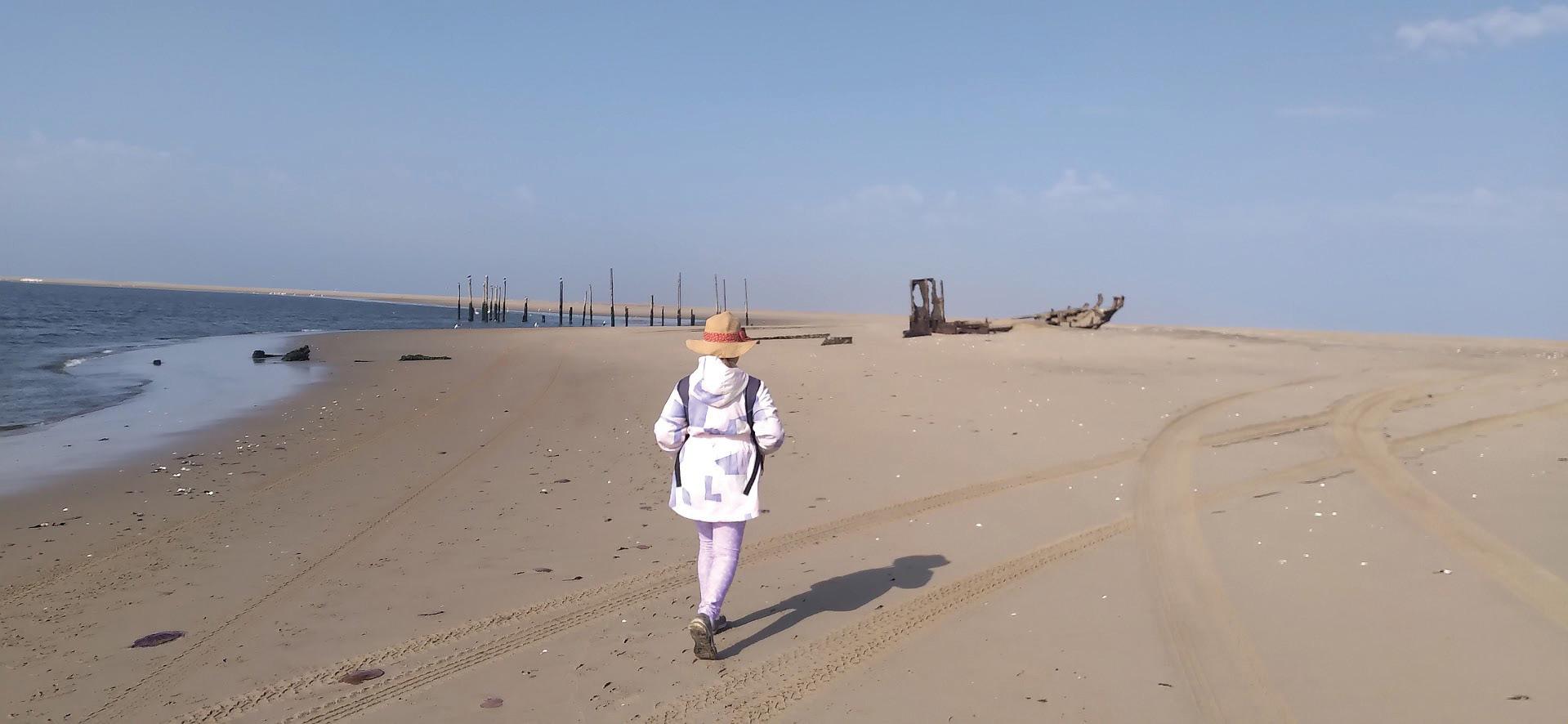
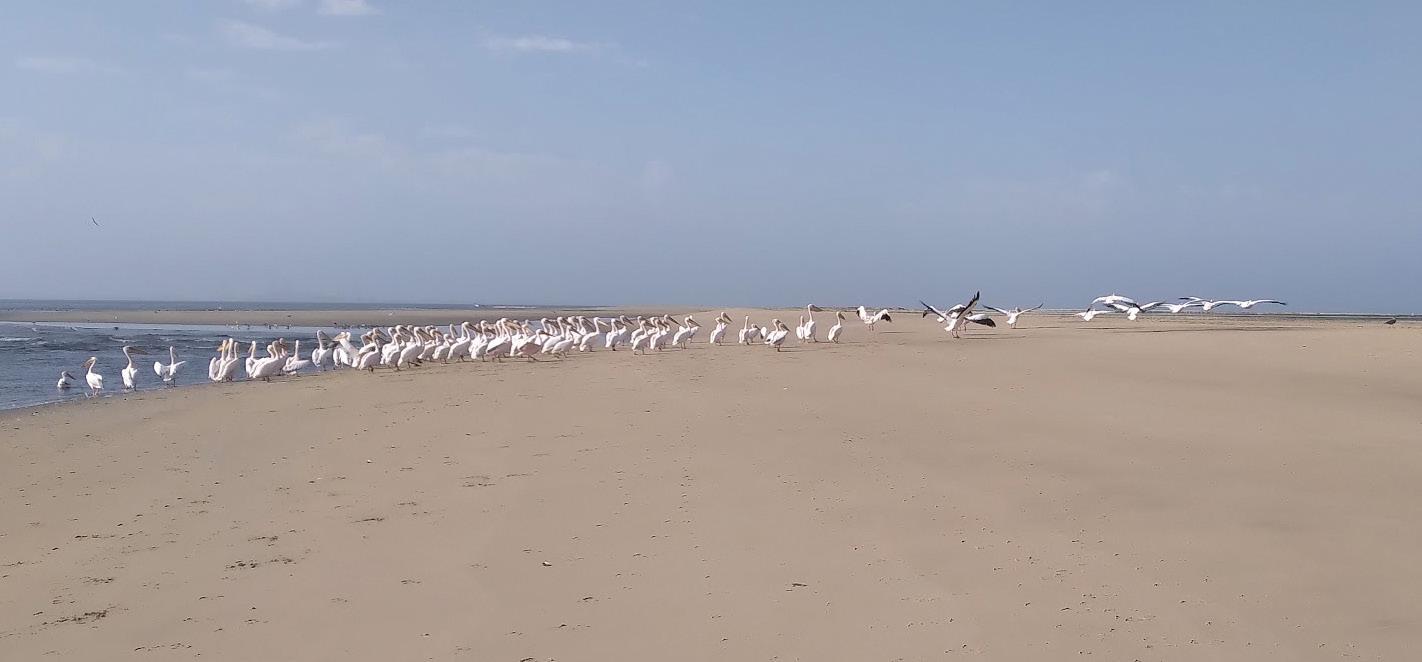
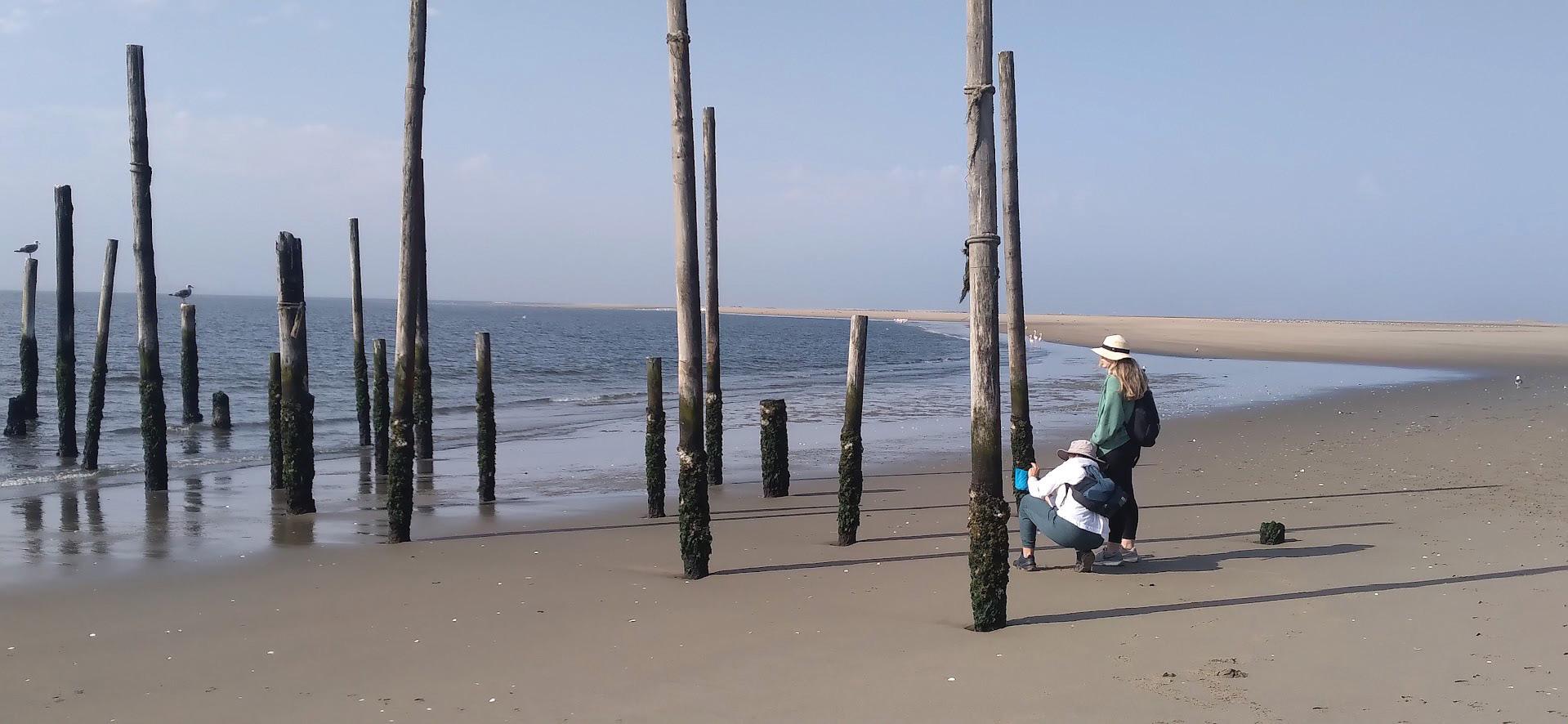
The Pelican Point Guided Hike is a new initiative, offering adventurers a unique way to explore the beauty of Walvis Bay’s lagoon and RAMSAR site. Founded by Kelly Beukes, an avid hiker and nature enthusiast, this trek takes participants along the western edge of the lagoon. What sets this experience apart is the opportunity to witness marine and birdlife up close, away from the noise and distractions of the modern world. From playful seals and elegant flamingos to the dramatic shipwreck resting on the shore, every step of the journey reveals something remarkable.
It’s a crisp, clear morning on the Atlantic coast as we start our hike along the western edge of the Walvis Bay Lagoon. The port town, with its towering dock cranes, can be seen to the east across the mirror-like surface of the lagoon. The drive here took us past the evaporation ponds of the Walvis Bay Salt Works, where the pink water reflected brightly in the early morning sun –a scenic start to the exciting adventure that lies ahead.
The scent of the ocean is the perfect companion as we begin our trek along the soft sand of the beach. Our first wildlife sighting is Klaus, the name given to an obese seal that has realised the best buffet can be found at the salt works' pump station. Klaus’ personality is almost as big as his body; he is a regular here and entertains guests with his playful dances in the water as he fills his tummy.
From here, the hike takes us through marshy areas, where the group has to wade through some ankle-deep water – one of the reasons why these hikes are only done at low tide. Otherwise, the water is too high. The cool water is a refreshing sensation and adds to the experience of walking on the beach, as common terns fly overhead.
The hike takes us past an oyster farm, where we spot solitary jackals patrolling up and down the beach, searching for eggs and easy prey. We also see some oystercatchers, which are quite common along this stretch of the lagoon – an excellent opportunity to observe them up close.
Further down the beach, we pass the old oyster farm. The wooden infrastructure and debris from buildings that were blown over in the last storm are still visible, making for a great photo opportunity.
In the distance, a flamboyance of flamingos awaits. As we get closer, we watch their slender legs half-submerged as they rhythmically dip their curved beaks into the water, searching for food. Their vibrant pink hues stand out against the deep blue of the lagoon, and every so often, they take off in a graceful, synchronised dance, their wings flashing black and crimson as they lift into the sky.
After wading through the deepest water yet – just below our knees – we reach the wreck of a Norwegian shipping vessel. Apparently, it caught fire and was beached here.
As the hike progresses, a seal's head occasionally breaks the water’s surface, its curious eyes peering at us before vanishing beneath the waves. Flocks of cormorants line the sandbanks, drying their wings in the sun, while pelicans glide effortlessly above, their large beaks poised to scoop up fish.
Approaching Pelican Point, the sound of barking grows louder. The massive seal colony comes into view – a bustling, chaotic mass of movement and noise. Hundreds of Cape fur seals lounge on the sand or play in the shallow waters, their sleek bodies glistening in the sunlight. Some tumble over each other in playful wrestling matches, while others rest in the warmth of the morning sun. The scent of salt and fish hangs thick in the air, mingling with the earthy aroma of damp sand.
Beyond the seals, the lighthouse stands tall at Pelican Point – a historical remnant of the region’s shipping past. These days, it operates as accommodation. Pelican Point marks the end of the hike, where a well-deserved picnic awaits. A spread of cheeses, cold meats, quesadillas, fruits, drinks, and something sweet to round off the meal. Chairs to rest our weary legs are a welcome sight as we sit and reflect on the wonderful experience.
Hiking is part of my journey, something that I love. It’s a way to experience a new landscape in a different and much more intimate way. Walking gives you time to see everything from a slower, more immersive perspective.”
“I started organising this hike when I realised no guided hikes were available in the area. This stretch of beach is so isolated and teeming with marine life – pelicans, flamingos, and more. The best part is that you can see them up close, without the noise of cars or crowds, just our small group of hikers. It’s a completely different experience from what’s typically on offer, and I wanted to share that with others,” explains Kelly, the hike’s founder.
The Pelican Point Guided Hike is roughly 12 km long. Along the way, guests can expect to see flamingos, pelicans, oystercatchers, plovers, terns, seagulls, cormorants, pied avocets, little egrets, greater egrets, and more. Although this regular hike is not specifically aimed at birders, those with a keen interest in birdwatching can request to have local bird expert Kobus Bekker lead the tour with prior arrangements.
The Pelican Point Guided Hike takes 2.5 – 3 hours. Guests are picked up from the marina at 08:00 and can expect to be dropped off around noon. There is also an option to combine the hike with a Sandwich Harbour tour with Photo Ventures, in which case hikers will be picked up from Pelican Point. TN
Pelican Point Guided Hike: N$1,250 per person (includes transport to and from Walvis Bay).
Optional Sandwich Harbour Tour: N$2,550 per person.
• A small backpack (If you don’t have one, Kelly can provide one).
• Snacks for the walk.
• A sunhat and sunscreen.
• Water shoes (if you prefer not to walk barefoot).
• Water will be provided on the hike.
To book the Pelican Point Guided Hike, contact Kelly at +264 81 423 1961 or bookings@kellyinthewild.net
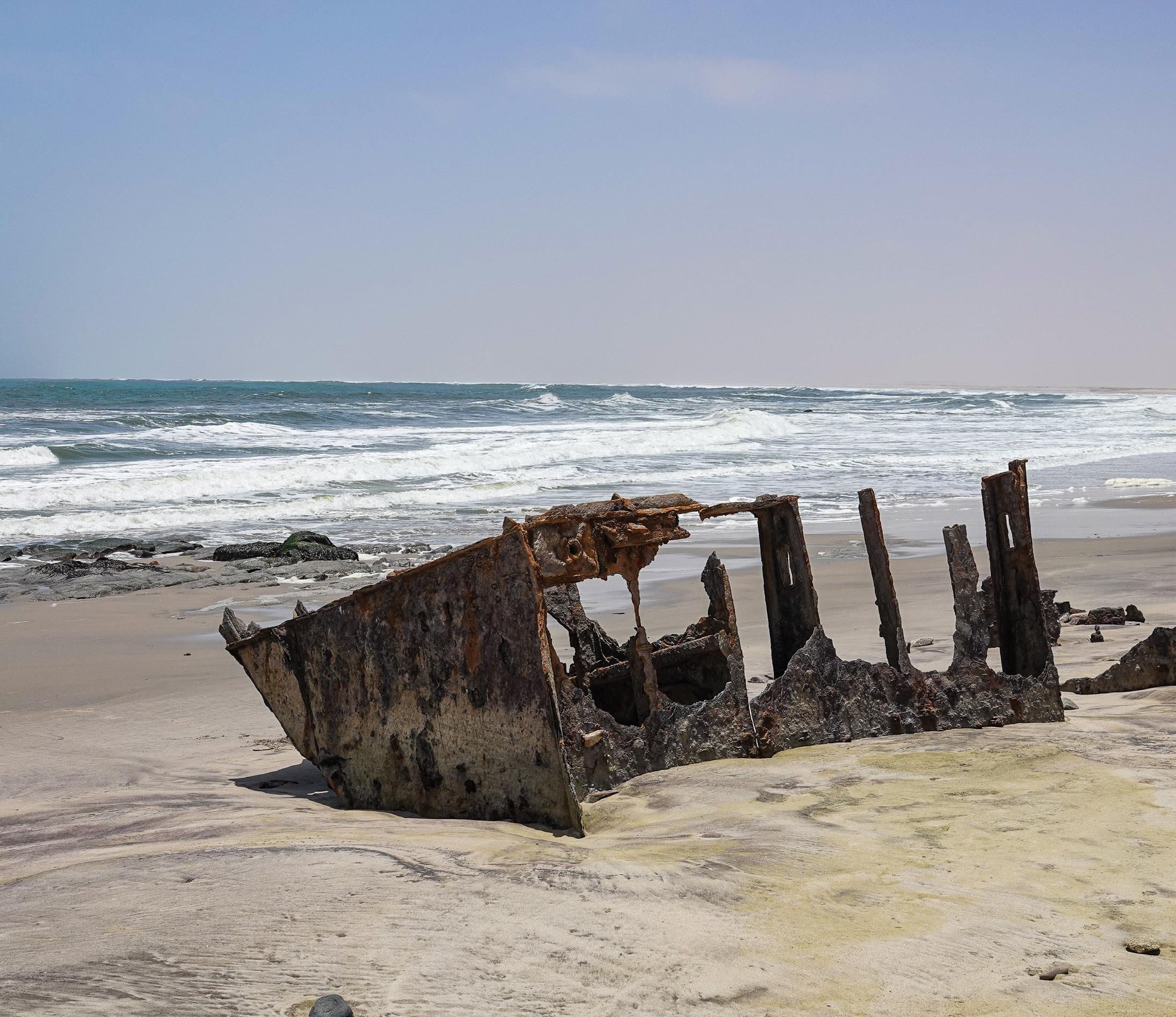
Text &
Photographs
Kirsty Watermeyer
In the land where time appears to slow down, where the sea meets the sandy touch of desert dunes, lies the Skeleton Coast. It is a place both feared and revered, whose name conjures images of ancient mysteries, dramatic shipwrecks and the eerie howling of the wind. Ever since my first visit, I have been captivated by its haunting beauty. As I explored the land, a deep curiosity grew within me – a love I was surprised to discover.
Throughout history, this land has been known by many names. Sailors, who cursed its shores, dubbed it “The Gates of Hell”, for the sea was as treacherous as the land was unforgiving. Imagine, if you will, rough seas and tumbling waves, desert sands stretching as far as the eye can see along the shoreline, and a fog that swallows everything in its wake.
But do not be fooled into thinking that is all there is here. Beyond the horizon, brace yourself for the impact of beauty as it reveals itself up close.
The Skeleton Coast, named after the remains of those who met their doom here, is a place of myth and legend. Over 1,000 vessels have become entombed in the sands, their timbers now bleached and crumbled under the weight of this harsh environment. Yet beneath the surface of this grim history lies a land of astonishing beauty and resilience.
Stretching over 500 kilometres from the Ugab River in the south to the Kunene River in the north, the Skeleton Coast is a land of extremes. Salty sea waves crash to the west, while dry, sandy dunes interspersed with rocky outcrops stretch to the east. This stark landscape provides the perfect setting for fog that rises from the sea, bringing moisture to the fauna and flora that call this land home.
A herd of springbok, their bellies full with the knowledge of hidden food, moves cautiously through the dry Uniab riverbed. Ever watchful, they tread lightly, for they too know the ancient stories of the desert-adapted lions that roam these sands.
The Skeleton Coast is not merely a land of desolation; it is a realm of strange, tenacious life. Lions, brown hyenas, seals and gemsbok carve out their existence in this unforgiving place, each creature finding sustenance where few others could. If you are fortunate enough, you might catch a glimpse of these survivors, but even if you do not, their stories are written in the countless footprints they leave behind in the sand.
At the Skeleton Coast National Park, nature rules in its purest form. Though the land is sparse, it is vast (16,845 square kilometres of coastal wilderness and desert) – a realm teeming with hidden wonders. From the rare ephemeral rivers that snake through the valleys to the lichen fields that bloom in the harshest environments, this is where life defies the odds.
In this vast wilderness lies the world’s largest ship cemetery, where the bones of wrecked vessels whisper nautical tales of days gone by. One day, we set off in search of these elusive remnants, armed with nothing but maps and a sense of eager anticipation. The journey is harder than expected, for many of
the shipwrecks have been swallowed by shifting sands or torn apart by relentless crashing waves. Sometimes all you find are fragments of the same vessel scattered far apart, testifying to the violent forces these ships endured when they ran aground.
It is a modern-day treasure hunt, where the thrill of discovery lies in the search itself. If you happen to pass another vehicle along the beach road, you can be sure that you will both come to a stop. With a nod and a quick exchange, you ask what treasures have been spotted along the way. Often the only way to confirm a shipwreck sighting is through the knowledge of someone who has already uncovered one. And so, with renewed enthusiasm, each vehicle drives off in different directions, eager to lay eyes on the bones of ships that have yet to be discovered.
For this adventure, we enter the Skeleton Coast National Park through Springbokwasser Gate, located to the east of the park. From there, we travel past Torra Bay and the Uniab River mouth, staying at Terrace Bay before heading back down the shore to exit the park through the southern Ugab Gate.
As we journey along, the scenery is striking in its desolation. At times, the road opens to sweeping views of the cold Atlantic Ocean waters crashing against the shore. During other moments, we are confronted by a landscape that speaks of ancient origins, formed millions of years ago yet still evolving today.
The Skeleton Coast is a place of contrasts, where nothing is quite as one would expect. The dunes here differ from those of the Namib, containing fewer volcanic rock fragments and more minerals like garnet and tourmaline. Along with the region’s arid climate and the weathering-resistant volcanic rocks from the Etendeka Plateau, these factors give the landscape its unique character. Another interesting fact is that the beach sand here contains up to 80% quartz.
At Torra Bay, desert dunes stretch all the way down to the shore, where soft sands provide a perfect vantage point to watch the waves roll in rhythmically.
For millions of years, currents have carried sand, gravel and larger rocks northward from the mouths of rivers. Over time, this material evolved into gravel and pebble beaches. Some of these have been left high above the current tide line, forming raised beaches (also known as marine terraces) due to shifting sea levels. As we travel further north past Torra Bay, we see these raised gravel and pebble beaches, mostly composed of the predominant basalt rock from the eroded Etendeka Plateau. In fact, Terrace Bay takes its name from a three-metre-high marine terrace in the area.
Our home during our visit to the Skeleton Coast was Terrace Bay, a surprising gem along this wild coastline. While many people assume this place is purely an angler’s paradise, thanks to the abundant fish life that thrives here in one of the most productive oceanic areas in the world, we did not see a single fisherman
during our stay. Instead, most visitors, like us, were drawn by the allure of this untamed land, eager to explore a corner of the world where the rhythms of nature remain unbroken. Though we came from all corners of the globe, we shared a common fascination with the Skeleton Coast – a place that stirs something deep inside all who venture here.
Terrace Bay is a fascinating little outpost, full of mystery and steeped in the remnants of its past. Once a diamond mining settlement with a checkered history, its story has evolved over time, and what really happened here is now more myth and folklore – much like many of the tales of this land. Perhaps the full story of its past is best left to the imagination. The old mine buildings, now weathered and worn, serve as a sanctuary for birds that shelter in the rusty remains of human endeavour.
This is the northernmost point for self-drive adventurers visiting the park, and here you will find beaches made up of beautiful, well-developed pebbles (also known as cobble beaches), some of which date back around 5,500 years. The Paraná-Etendeka Volcanic Province contributed significantly to the pebbles and gravel found on beaches north of the Uniab River mouth, including those at Terrace Bay. An interesting feature of these pebbles, so perfectly rounded, is that they are a clear indicator of strong wave action.
Operated by Namibia Wildlife Resorts, Terrace Bay offers simple yet cozy accommodation that captures the essence of this rugged place. You can choose from twenty en-suite double rooms or opt for the self-catering beach chalets, perfect for larger groups looking for a more private retreat.
Here, you will also find a fuel station and a small shop stocked with necessities and mementos to remember your stay. The restaurant at Terrace Bay serves up delicious meals, and the quaint, well-visited bar is a true talking point, with every inch of its walls covered in signatures and stories from visitors who have passed through over the years.
The charm of Terrace Bay lies in its understated beauty. Modest yet endearing, it is a place where the land’s stark beauty is matched by the warm hospitality that invites you to rest before continuing your journey through this extraordinary corner of the world.
As we leave the Skeleton Coast behind, we carry its stories with us – tales of survival against impossible odds, of the slow decay of shipwrecks and the resilience of life. My thoughts return to one of the many names this land has been given: “the land God made in anger”. But I must strongly disagree.
Those fortunate enough to witness its beauty are granted a glimpse into a forgotten world. This land is one of ancient bones and shifting sands, its stories shrouded in mystery and lost to the sands of time. It is alive with raw nature. For those who venture into its depths, the allure of the unknown calls, whispering of a world both mystical and real – a place where nature reigns supreme. TN


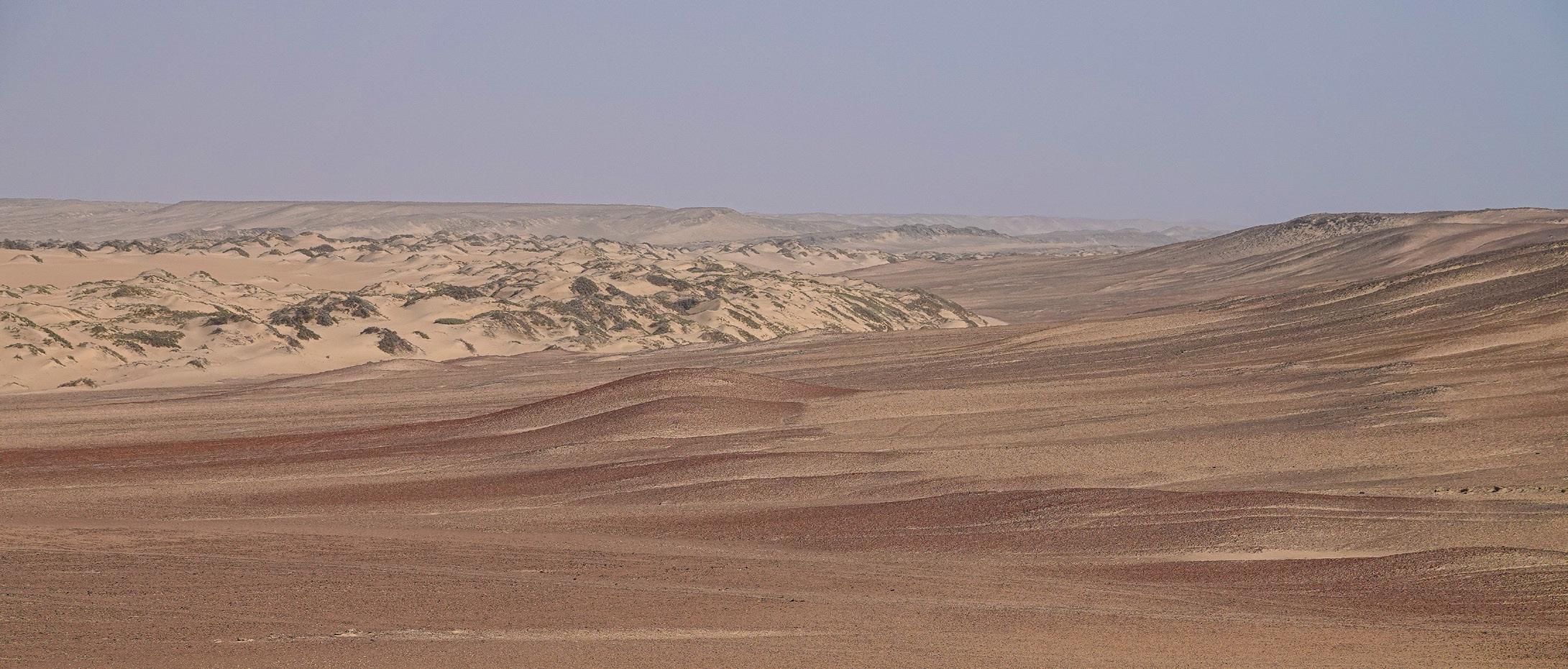









Text Madeleen Duvenhage | Photographs Kilian Brues/Hooves & Gardens
“Here, have some more!” Another batch of yellow baby tomatoes is generously stuffed into my hand, as we step between rambling rows of trellised tomatoes teeming inside a greenhouse. I am back at Hooves and Gardens, nearly a year after my own wedding reception was held on this spacious family farmhouse-style property. In between reminiscing about my wedding day, I am treated to a personal tour of the grounds and the most recent developments. Trailing behind Christiane Reé-Ahlenstorf, co-founder of Hooves and Gardens, I happily munch away. Sweet tomatoes burst with flavour inside my mouth. It is a beautiful, sunny Sunday morning.
Situated 25 kilometres south of Windhoek (towards Rehoboth), Hooves and Gardens sits right on the busy B1 highway. This location is somewhat ironic and incongruous, since there is an unexpected quiet which envelops me once I walk up the steps of the farmhouse, drenched in morning light.
“SO
Formerly known as the Aris Hotel, the property stood vacant and abandoned for years. Selling for N$8 million, each prospective buyer balked at the amount of work (and capital no less) that would need to be sourced towards its renovation and development. “The building was just a heap of rubbish. It was basically falling apart,” Christiane recalls. Yet her children, seeing the property for the first time, responded with unlikely optimism. “Here is so much potential!” her daughter exclaimed as she spotted the premises from the road while driving by. Her son, Leo, who now manages Hooves and Gardens, instantly agreed.
As it turned out, that optimism proved to be contagious. “We came with shining eyes, lots of enthusiasm … and not much money!” Christiane lets out a deep belly laugh and shakes her head as she recounts those first audacious months spent dreaming up something new.
Christiane has a long-standing connection with the Farm Krumhuk Project – Namibia’s established sustainable farm and business – and alongside various partners with a similar vision, she and her team hunkered down on transforming an unremarkable, crumbling pile into an enterprise that is noticeably different, or as she calls it, “a space outside of our normal, busy lives”.
The saying “hard work pays off” is sometimes a stale cliché in how often we breezily use it, but it still rings true. Walking
around the place, from the neatly constructed wooden jungle gym (the biggest in Namibia!) to the lively chatter of families enjoying breakfast, I am stunned by all the growth that has seemingly sprung up in the space of just a year.
Children weave in and out of our conversation. A small boy bolts out in front of me, boisterous, his pockets bulging with glossy green peppers. Christiane explains, laughing: “Ah yes, that boy is probably on a Farm Round!”
One of the must-do activities at Hooves and Gardens is the Farm Round, a family-friendly outing where children of all ages are guided through the grounds and introduced to its furry and feathery inhabitants: a tame oryx, donkeys, horses, ducks, chickens, turkeys, bunnies, pigs … and even a few Dexter cows (a smaller, slightly more endearing cattle breed). The Farm Round also explores Hooves and Gardens’ own small-scale organic vegetable production, providing wholesome and healthy food directly to the restaurant. “Children need to know where their food comes from and experience the joy of being able to harvest and eat their veggies on the spot.” During these excursions, they are free to pick vegetables from the greenhouse and take it back home as a scrumptious souvenir.
Remembering her own upbringing in rural Germany, Christiane wanted to implement fun, interactive activities where children can discover and appreciate their own inexorable connection to nature, animals and food production. Booking a Farm Round in advance is not compulsory, which makes it conveniently flexible for those prone to undertaking spontaneous day trips!
“Nature enriches us; it doesn’t isolate like our screens tend to do. Nature, in my opinion, provides more substance compared to social media. This is true for both children and adults.”
Experience the ultimate in luxury with Westair’s Private Charter flightsseamlessly taking you to any destination in Namibia and beyond.





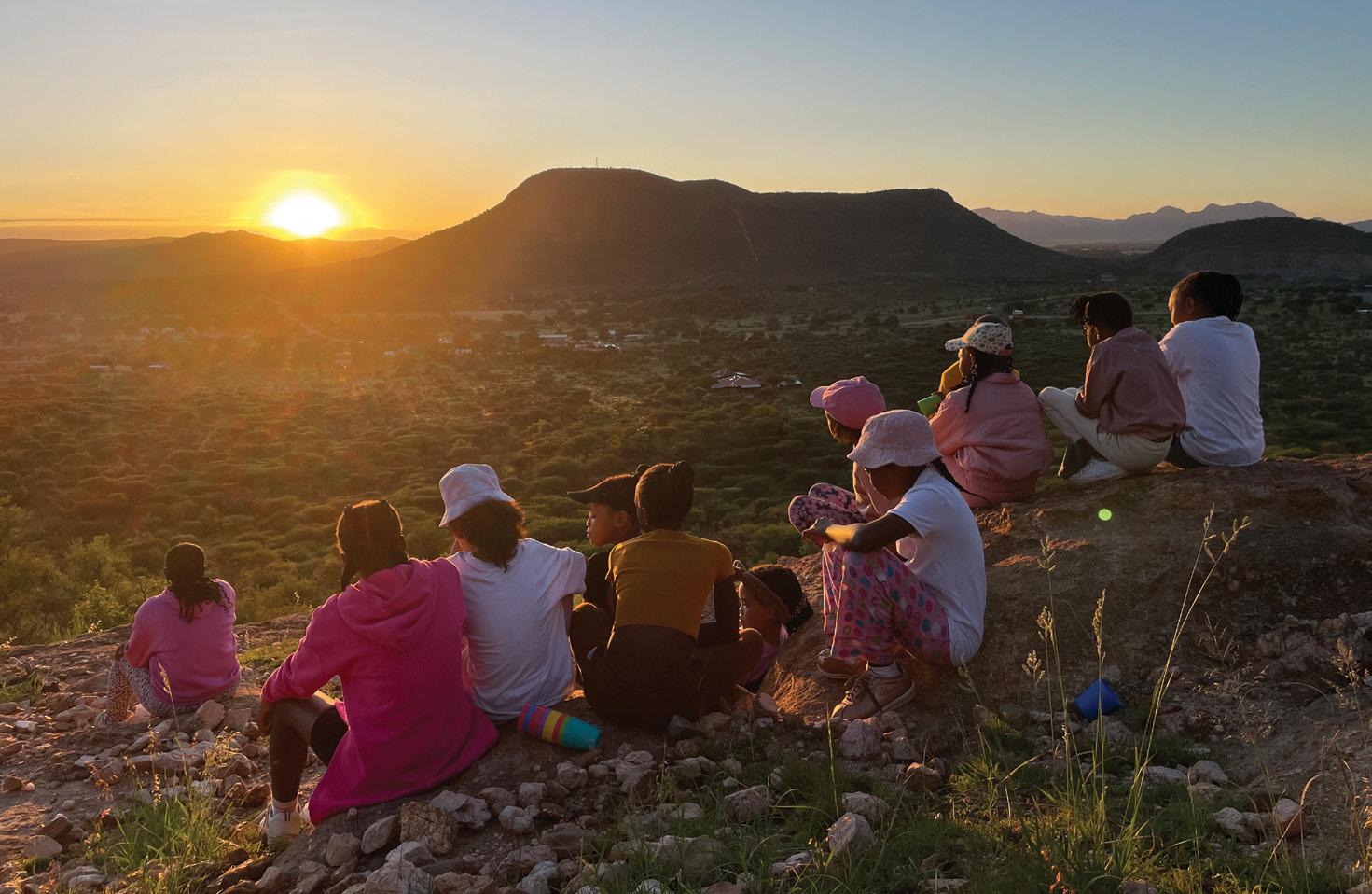
During my “tour”, I peek into the kitchen where I am greeted by friendly smiles while the head chef, Queen, presents a plate of opulently stacked pancakes drizzled with chocolate sauce. A large jug of minty and lemon iced tea is placed next to a tray of cups. Queen tells me that this sweet, refreshing snack is all set to be taken outside to the group of children relaxing beneath the shade. Each Farm Round is topped off with this enjoyable finale.
“I never wanted Hooves and Gardens to be exclusively profitdriven with a sterile-like atmosphere. Rather, I wanted a place reminding us of our shared human values. I want people to feel noticed,” says Christiane. This personal philosophy translates to the pragmatic as staff affectionately call her “Ouma” (grandmother). Since its inception, Hooves and Gardens continues to prioritise training and equipping of its staff members. “We are passionate about empowering our staff so that they can develop professionally and maybe even go on to build their own sustainable endeavours!”
As we sit down for breakfast inside the restaurant, Daniel, our waiter, serves me a complimentary sampler: homemade tomato and eggplant sauce dipped in freshly baked mini buns. I gobble it all down even before my cappuccino arrives. These sauces are the latest culinary creations from the kitchen, where the chef is always at play and has free pickings from the poultry, piggery and home-grown vegetables.
This intentional “food-to-table approach” reaches beyond simply the menu. A holistic, sustainable ethos is what undergirds the whole business. Christiane and her team of staff and volunteers hope that this will continue for many years to come. With her sprightly sense of humour and characteristic German candour, she is always buzzing with ideas!
The arts are also looked after here: Hooves and Gardens aims to create regular platforms for emerging artists and local stories. At present, the Goethe-Institut is exhibiting a collection
• Pottery and wine date nights for couples.
• Book your next event at the coffee shop & restaurant and relish their organic culinary dishes.
• Are you an artist and want to showcase your work? Get in touch!
• Horseback and pony rides.
• Dog owners are welcome to bring their pet on a leash and explore the premises.
• A cycling trail for kids
• Moderate to more challenging hiking trails around the farm.
• Perfect setting for picnics or family day trips.
• Hooves and Gardens hosts plenty of diverse activities for children and families. Find out more on social media.
of thought-provoking photographs in a beautifully curated room especially designed for this purpose. Christiane hopes more artists and authors will be showcased in the future. As with organically sourced meals, art and imagination plays an equally crucial role in cultivating our wellbeing.
Once Christiane left an empty bowl right at the entrance and explained to visitors that once they enter Hooves and Gardens, they need to leave all their stress in that bowl. They were (she says with a smile) at first bemused by this beaming matronly figure telling them to toss, metaphorically at least, all their weekly worries into a mere bowl! However, perhaps enchanted by the weaver birds building nests overhead or enticed by the aroma of coffee, they meekly submit. Even grown-ups (gasp!) can unwind here from the world’s frantic hamster wheel and as Christiane puts it, experience “a little rest for your soul”.
We are forever overstimulated; devoted to our screen-saturated lifestyles. Could the perfect antidote be Hooves and Gardens? Come on, cast those worries into the bowl and see what adventure might unfold once you enter through the door! TN
• Please note that Hooves and Gardens is closed on Mondays and Tuesdays.
• Wednesday and Thursday opening hours are from 11:0017:00.
• Hooves and Gardens will now also be open on Friday evenings, launching special themed nights such as Soft Jazz Night, Spoken Word & Poetry, Quizzes etc. Do check it out! Doors will open from 18:00-21:30.
• Saturday and Sunday opening hours are from 09:0017:00.
• Stay in the loop for upcoming events and announcements on the social media platforms: @Hooves & Gardens @hoovesandgardensnam
The place where the bones of the earth stretch across the land
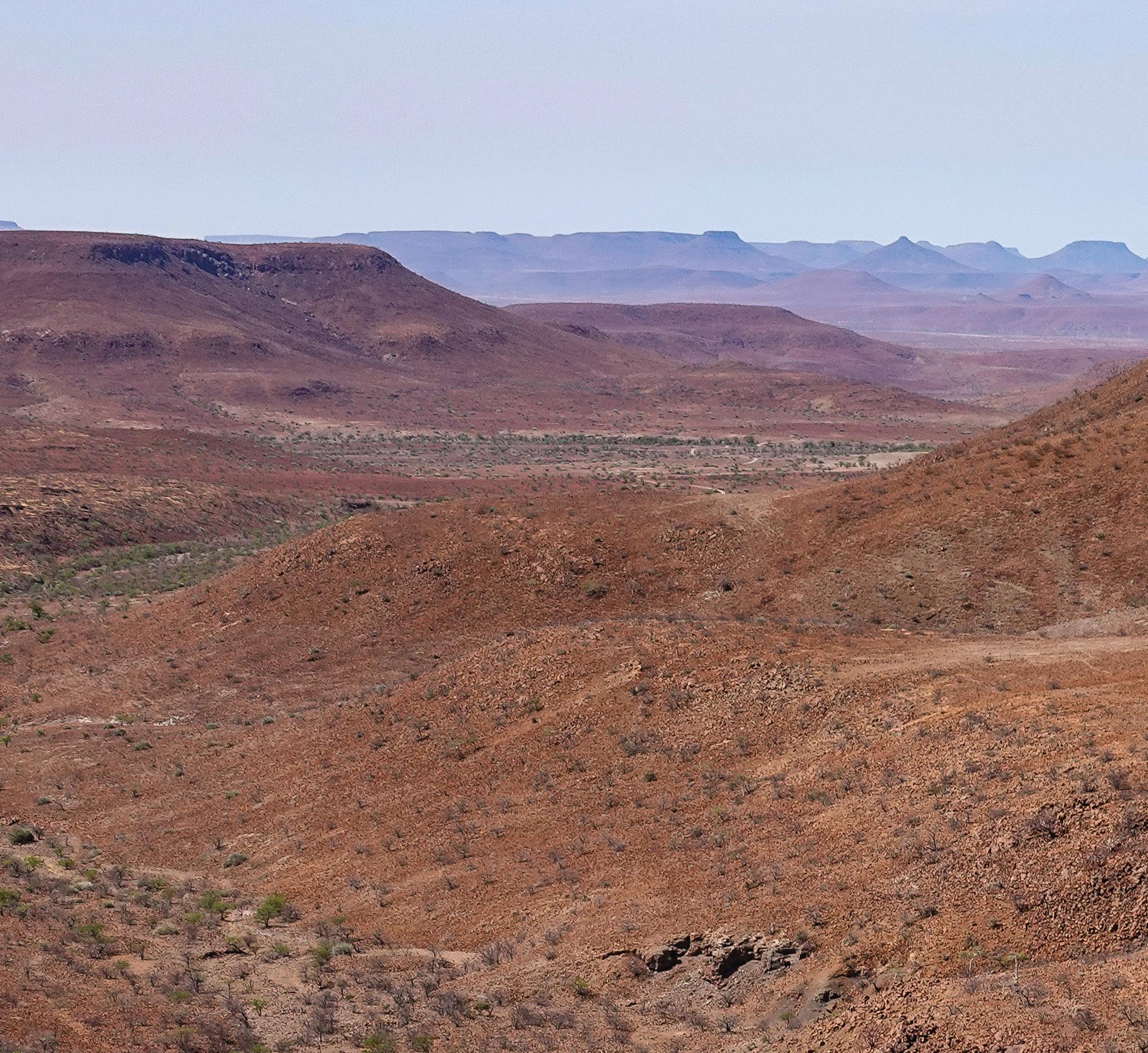
Rocks are silent keepers of ancient secrets, bearing witness to Earth’s movements, the collisions that shaped landscapes and the forces that continue to sculpt the world we marvel at today. Among the most captivating of these landscapes is the northwest of Namibia, where the rocks do more than just catch the eye with their striking hues and dramatic formations. These rocks, positioned with such eloquence to form mountains and valleys, are also some of the oldest on the planet. If these rocks could speak, they would have many stories to tell.
Kirsty Watermeyer discovers the ancient tales of rugged places while travelling through Damaraland.

Stretching over 78,000 square kilometres, the Etendeka Plateau lies like an open book, its pages written in volcanic rock.

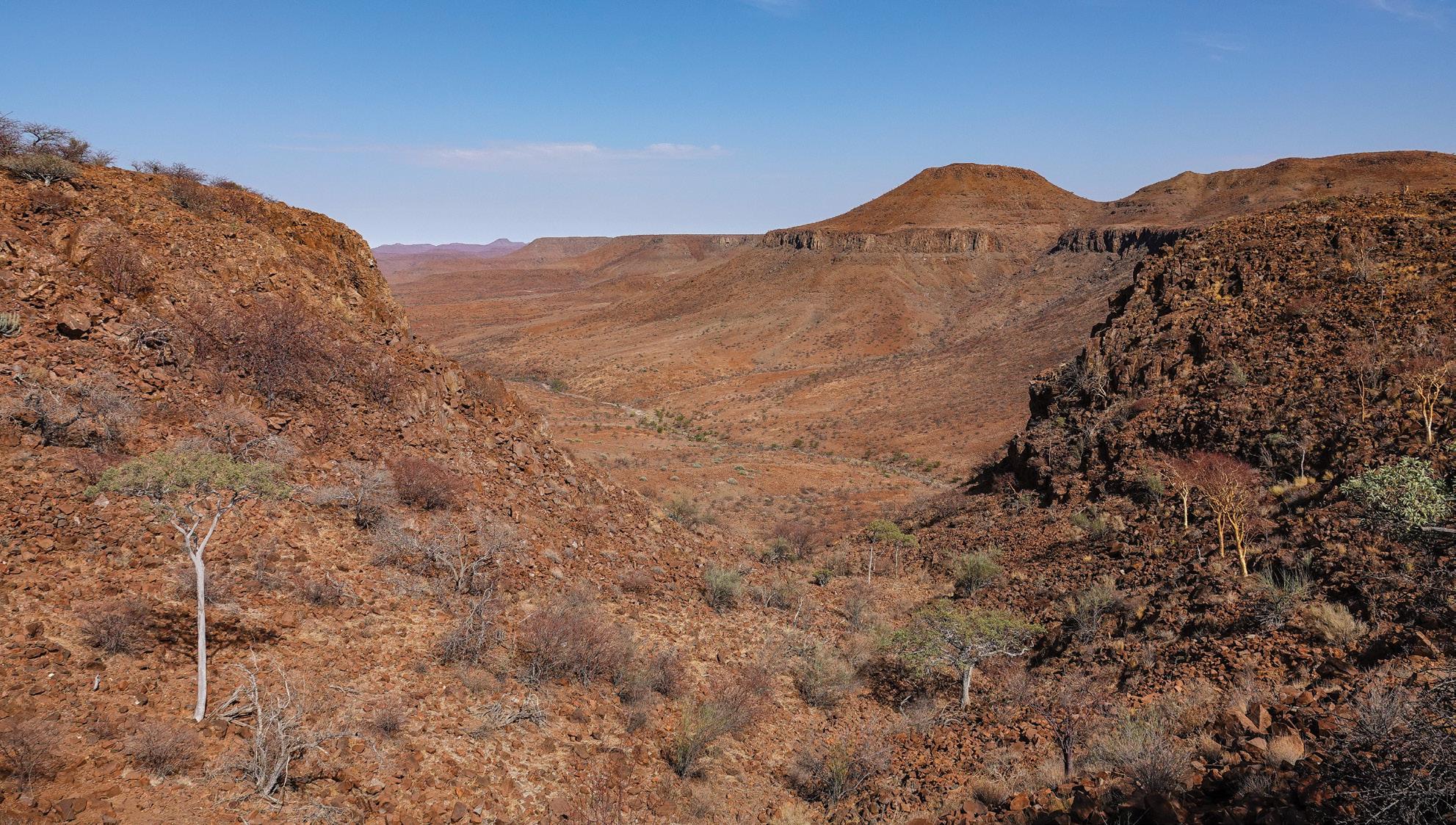
As we journeyed deeper into Damaraland, the terrain grew more rugged. The tar roads gave way to gravel, and the flat landscape transformed into dramatic mountains. This is a land that has been sculpted by time itself, where Earth’s bones stretch across the horizon in rugged beauty.
Over billions of years, this land has been shaped by dramatic geological forces which laid the foundation for Namibia’s rugged landscapes. Around 550 million years ago, the clash of tectonic plates led to the formation of the towering Damara Mountains. Later, vast lava flows from the Etendeka volcanic activity spread across the land, leaving behind thick layers of rock. This volcanic eruption was part of the slow, gradual breakup of Gondwana, the ancient supercontinent that once connected much of southern Africa, South America and other regions of the southern hemisphere.
The region has witnessed tectonic shifts, volcanic eruptions and the slow, relentless passage of time. As the supercontinent Gondwana slowly began to split, new forces shaped the land, with volcanic eruptions sending vast rivers of molten rock cascading across the terrain. The Etendeka volcanic activity, some 132 million years ago, was one such eruption. Lava flowed freely, spreading over vast stretches of land, leaving behind the rugged, flat-topped mountains we see today.
The Etendeka Plateau, with its expansive volcanic rocks, is striking. Here, the table-topped mountains are the defining feature of this awe-inspiring region. The word “Etendeka” is derived from the Himba people and translates to “place of flat-topped mountains”, while the Herero people use a similar word to describe when things are layered on top of each other –another appropriate description for this land.
This is the region where these ancient forces are on full display. Stretching over 78,000 square kilometres, the Etendeka Plateau lies like an open book, its pages written in volcanic rock. The landscape here is as haunting as it is beautiful. Table-topped mountains rise from the desert like sentinels, their jagged edges softened by the passage of time. Between them, valleys and plains stretch out, holding secrets from deep within Earth’s crust.
The rocks of Etendeka are not just ancient; they are timeless. Formed from volcanic eruptions, the basalts here contain minerals that shimmer with age. Amethyst geodes, rich in colour and history, lie hidden in the dark rock, waiting to be discovered. The vast, basaltic lava flows, which make up 80% of the plateau’s geological composition, are interrupted only by layers of quartz formed over countless millennia.
I found myself hanging over the side of the open-air game viewing vehicle to have a closer look at this artwork of rocks –each one unique and intriguing. This patchwork of geological wonder is nothing short of spectacular.
Driving or walking here is punctuated with countless stops to bend over and take a closer look at something magical, made even more spectacular with how the colours shift constantly during the day (these are colour-changing rocks, I am sure of it!). What is more, as you walk across this land, you feel as if suspended in time – a moment where the past and present seem to merge, and where you become a witness to the passage of time. This deeply soulful moment, where the land seems to whisper the secrets of its origins, is a rare glimpse into the ancient soul of Earth itself.
Experience unmatched comfort in nature. Bushtec luxury tents blend seamlessly into their surroundings with minimal environmental impact. Choose a customizable design or let us create something unique for you. From exclusive guest suites to efficient back-of-house solutions, we redefine safari luxury because in Namibia, only the extraordinary belongs.





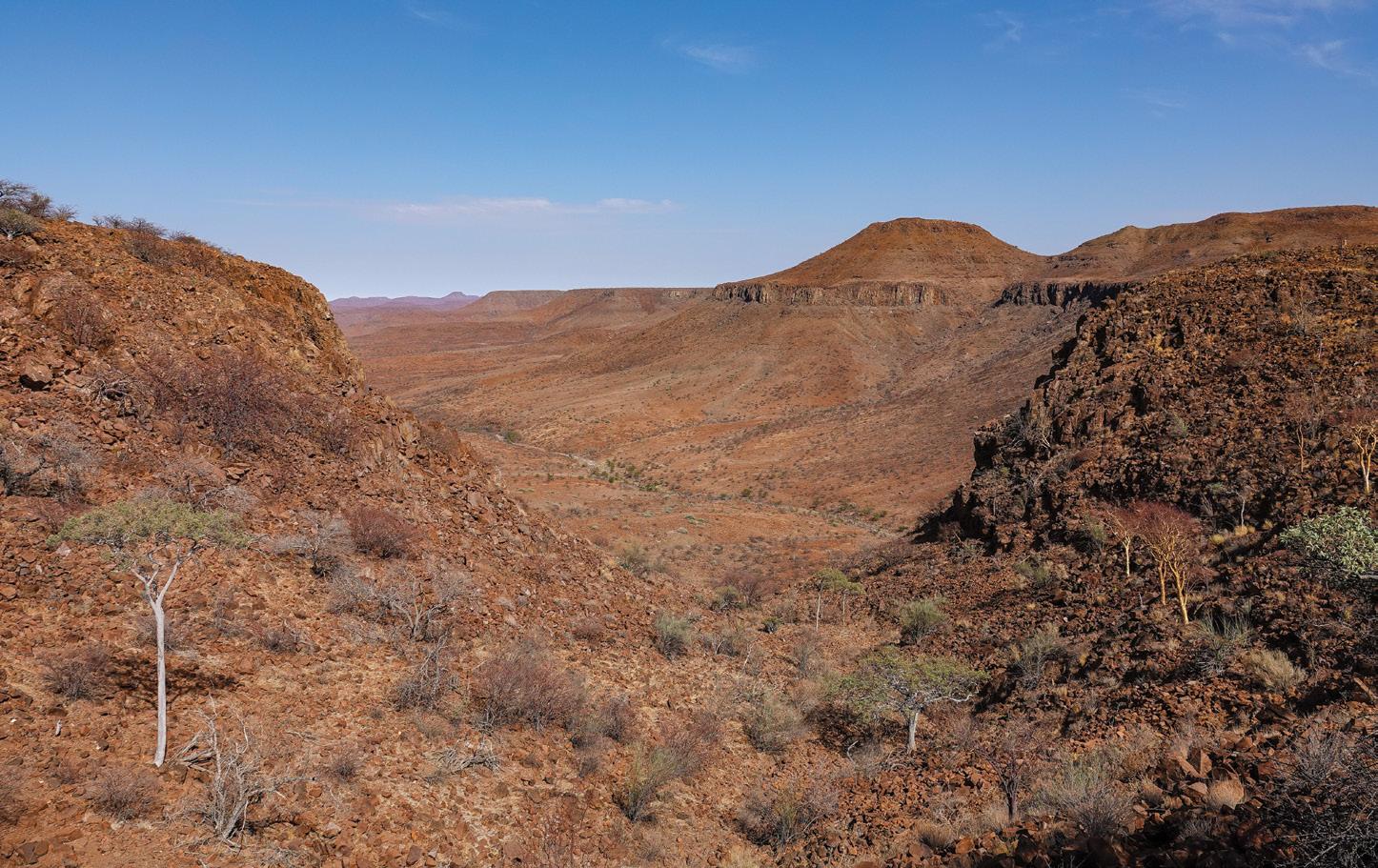
Our destination was Etendeka Mountain Camp, a true wilderness haven for those seeking an authentic, raw experience. One of the main attractions here is their hiking experiences, set against the dramatic backdrop of the Grootberg Massif. The trails offer a thrilling, unique adventure through one of Namibia’s most remote and untouched landscapes. Led by a knowledgeable and passionate guide, you will gain a deeper understanding of the area’s geological richness and vibrant natural history as they share fascinating anecdotes and insights. After exploring this stunning terrain, you return to find your bed dressed in linen awaiting you and, better yet, a chef ready to serve a hot, hearty meal. As night falls, you sleep beneath a blanket of stars in openair structures designed to maximise the breathtaking views. Surrounded only by the sights and sounds of nature, you will experience a form of luxury finely tuned to the rhythm of the wild.
We also embarked on the guided morning nature walk with walking sticks in hand, setting off from the main lodge after breakfast. The area’s geology is nothing short of remarkable, the plains scattered with ancient, exquisite crystals and agate, each telling its own story from past millennia.
This is a land of timeless beauty, where horizons are works of art, where stones move you and where you find yourself taking a deep breath, because here, there truly is room to breathe. TN


The Skeleton Coast, known for its harsh landscapes, holds many unexpected surprises – none more delightful than the sight of thousands of terns flying in a seemingly synchronised dance above sandy beaches.
As I drove down the coast, I stumbled upon a spectacle that felt like nature’s own aerial ballet. A huge group of terns, consisting mostly of Common Terns, their sharp black caps contrasting against the clear blue sky, flitted and dived in synchrony over the sand and surf. With their slender bodies, long, angular wings and graceful flight patterns, watching them was an absolute display of harmony.
The Common Tern (Sterna hirundo), often called the “sea swallow” for its long tail and delicate flight, is a common sight along Namibia’s coastline. These terns breed in temperate regions of Europe, Asia and North America, and while they are not native to Namibia, they can be spotted during migration, often following the fish stocks along the coast. What makes the Common Tern particularly special is its social nature. Unlike many seabirds that prefer solitary lives, Common Terns thrive in noisy colonies, often in their thousands, especially during the breeding season. While the colonies typically number around 2,000 birds, some can swell to as many as 20,000. Interestingly, they often include other tern species, such as the Arctic Tern and the Swift Tern, both of which I saw joining in the dance of flight that morning. Arctic Terns are often confused with Common Terns because they look very similar, while the Swift Tern is much larger, with some individuals having a wingspan of up to 1.2 metres. The Swift Tern also has a distinctive crest, which is why it was renamed to the Greater Crested Tern.
Incredibly migratory, Common Terns follow the ebb and flow of fish stocks. Their populations fluctuate depending on the availability of food, particularly sardines and anchovies. These terns often breed in northern latitudes, but during the southern hemisphere’s winter, they migrate down the western coast of Africa, reaching as far south as Namibia. Common Terns have one of the longest migrations of all birds, with an average round trip of 35,000 kilometres each year. Their migration routes can take them across vast distances, from their breeding grounds in the Baltic Sea and Scandinavia to the warmer shores of Southern Africa.
Their presence along the Skeleton Coast is a reminder that this seemingly barren stretch of land harbours a rich and vibrant ecosystem beneath the surface. The Common Tern, with its long, graceful flight and strong community bonds, is a symbol of nature’s interconnectedness – a migratory traveller that links the distant corners of the Earth, united by the same skies and oceans.
These terns are a living testament to the dynamic life that thrives along Namibia’s shores, where the ocean’s rhythm connects all living things. As I sat along the shoreline, watching their incredible display while their vast numbers turned the sky from blue to grey and white, I could not help but marvel at their grace as they swooped low over the waves in perfect unison. In that moment, it felt as if the very spirit of the Skeleton Coast – wild, untamed and full of vigour – was embodied in their flight. TN

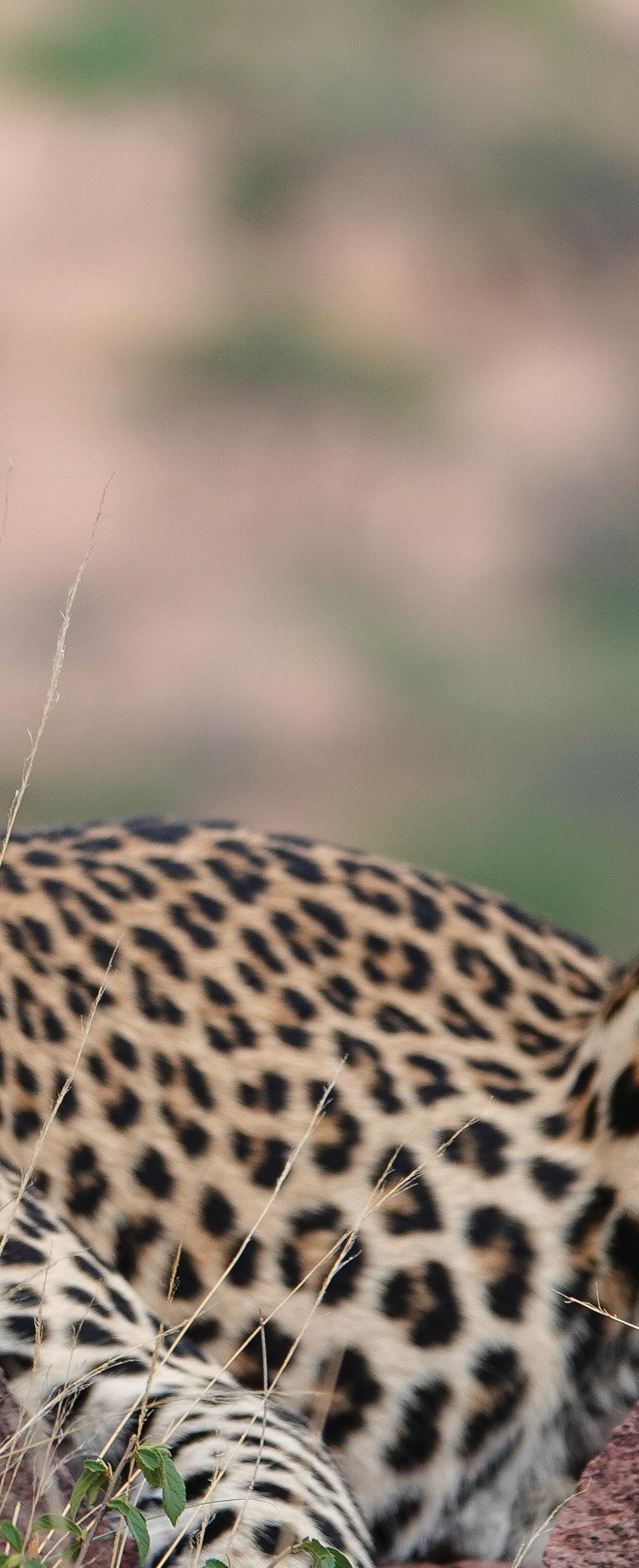
In Namibia’s central highlands lies the Okonjima Nature Reserve, a haven of untouched beauty. Spanning 22,000 hectares of pristine bushveld, this extraordinary reserve offers an immersive escape into nature. Just a short drive from Windhoek, Okonjima is celebrated not only for its breathtaking landscapes but also for its pioneering work in leopard conservation, an endeavour that draws wildlife enthusiasts from around the world.
Among Okonjima’s collection of lodges, we stayed at Plains Camp, an exclusive yet expansive retreat. With its spacious rooms and generous facilities, the camp comfortably accommodates a good number of guests without ever feeling crowded. The welcoming staff and exceptional cuisine added to the sense of comfort, creating an atmosphere of understated luxury. What we were about to uncover was a truly one-of-a-kind experience, set within one of Namibia’s most remarkable wildlife sanctuaries.
FROM CATTLE TO COMFORT, CUISINE AND WILDLIFE Okonjima’s story began in 1986, when the Hanssen family, once passionate cattle farmers, found themselves grappling with rising livestock losses to predators. As Namibia’s growing appeal as a tourism destination took hold, the Hanssens made a transformative decision to turn their farm into a game reserve. This led to the creation of the now world-renowned AfriCat Foundation, a pioneering initiative that marked the beginning of a conservation legacy that continues to flourish today.
Plains Camp, an integral part of this legacy, draws deep inspiration from the Hanssens’ cattle-farming roots. The design of the camp seamlessly blends elements of history and heritage, reflecting the spirit of Okonjima’s origins while offering the luxury and comfort of a modern safari experience. The spacious rooms are thoughtfully appointed, each featuring a private veranda that invites guests to watch wildlife meander by. Inside, the rooms are equipped with contemporary amenities, including a truly indulgent shower and a dedicated vanity area with a mirror, seat and plugs, perfect for glamming up after a day in the wild.
The true heart of Plains Camp, however, is The Barn, the camp’s central gathering place where all meals are served. It is a cosy yet vibrant hub of activity, offering a variety of seating areas spread across different levels. Whether you are curling up with a good book in a quiet corner, mingling with fellow travellers around a crackling bonfire under the stars, or helping yourself to excellent coffee throughout the day, The Barn is the perfect spot to unwind and connect. After a day of exploration, the sparkling swimming pool offers a refreshing respite, with breathtaking views of the surrounding bush.

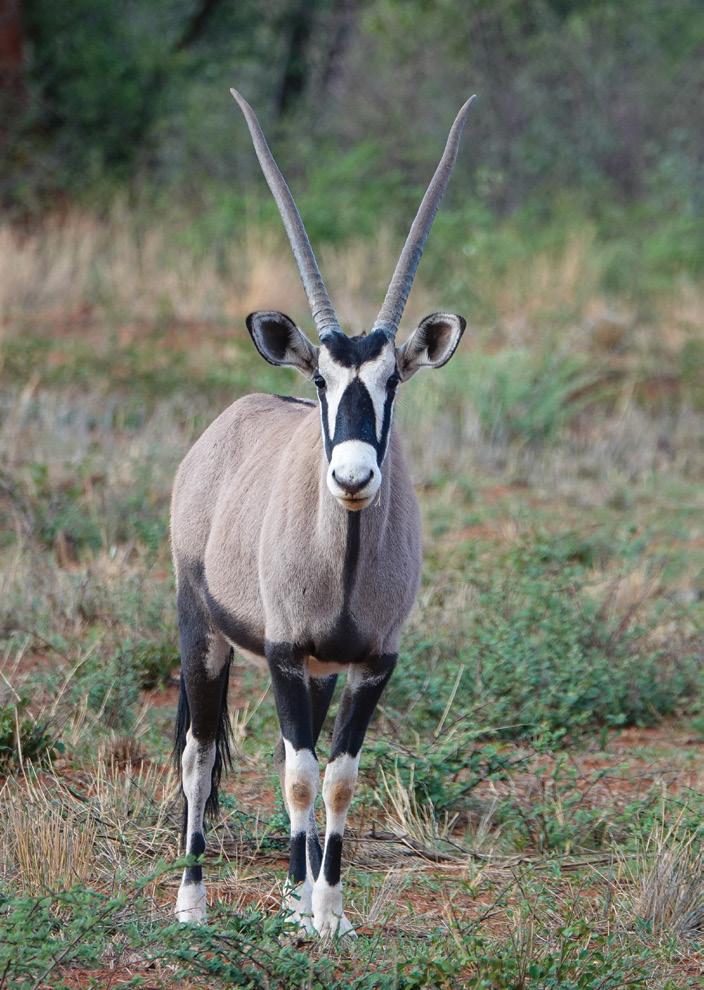

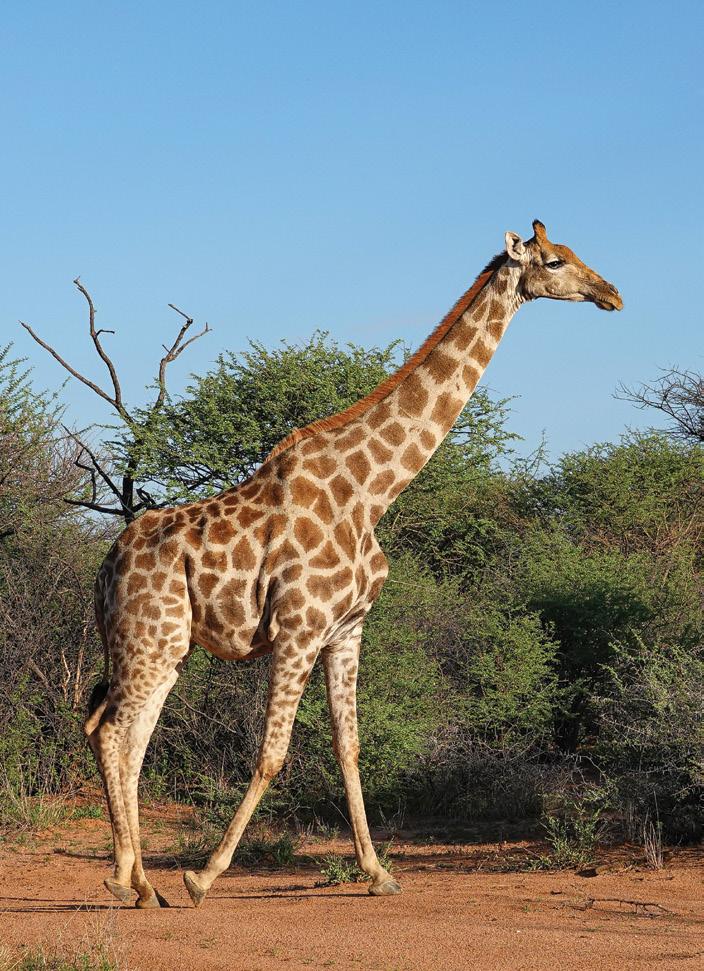

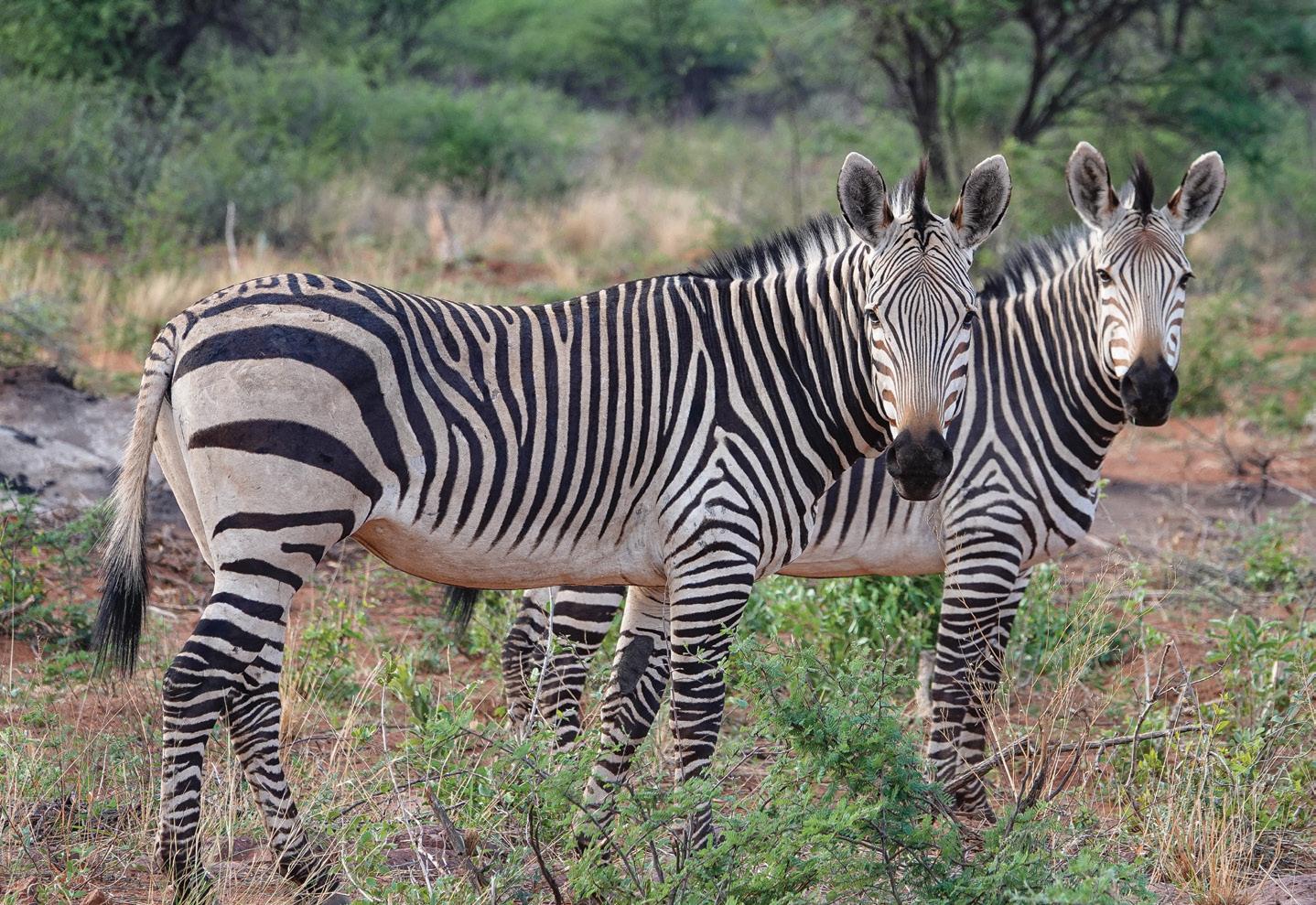
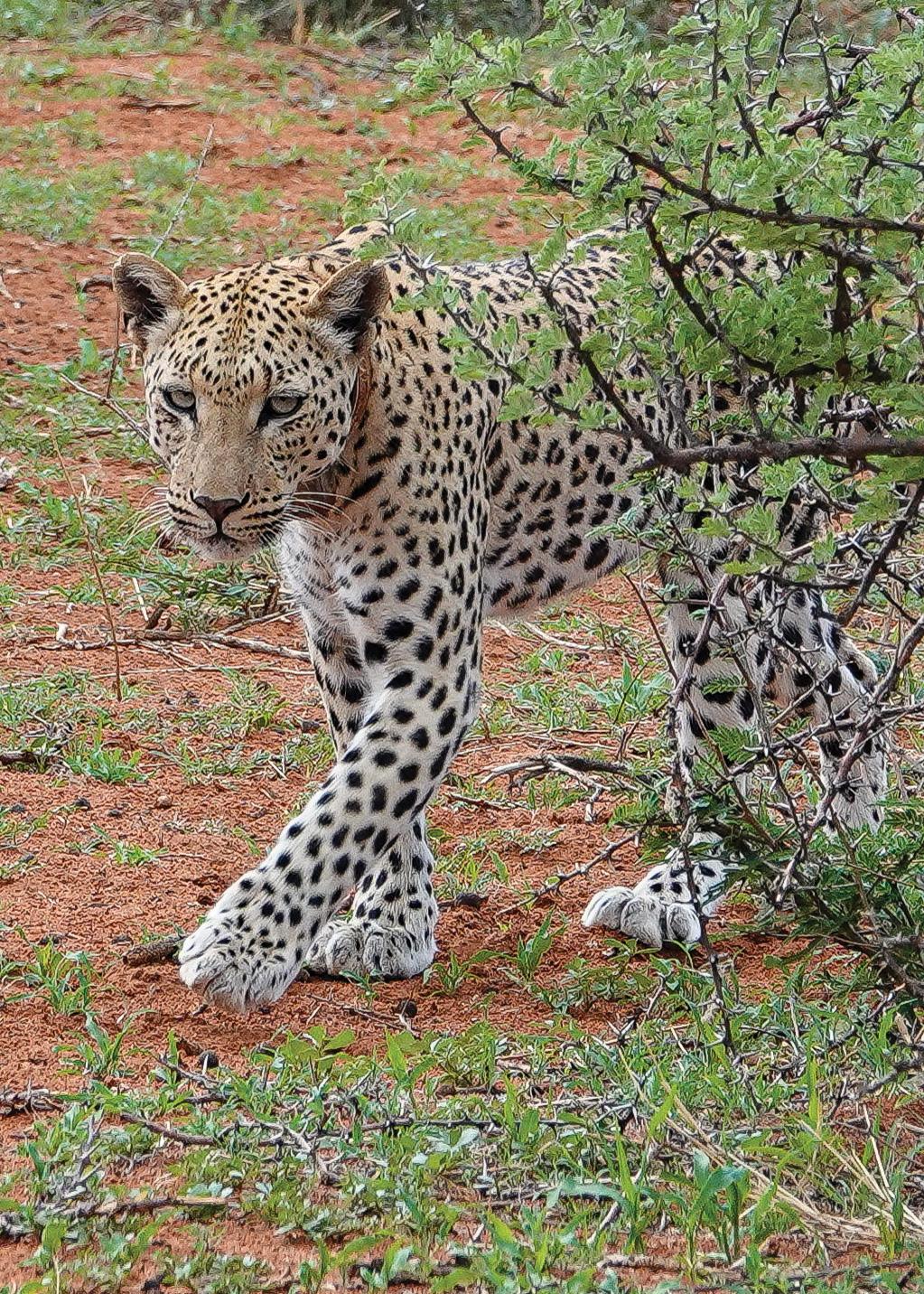

The culinary experience at The Barn is nothing short of exceptional. Each meal is a celebration of local ingredients, expertly crafted into unforgettable dishes. From the tangy beetroot with ginger and feta truffles to the indulgent, velvety homemade chocolate ice cream (which may just be the best you’ve ever tasted), dining here becomes an experience all its own. The food is a beautiful reflection of the land – fresh, flavourful and deeply connected to the spirit of Namibia.
Another highlight of dining at The Barn is the ever-changing wildlife backdrop. Whether it is a family of warthogs lounging in the mud, jackals traversing the landscape or masked weavers busily crafting their nests, there is always something to look out for. And then, there is the sunset, an awe-inspiring spectacle that turns the sky into a canvas of vibrant oranges, pinks and dusky purples, creating the perfect ending to an unforgettable meal.
One evening as we dined and watched an unforgettable sunset, a group of avid travellers, who had journeyed to every corner of the globe, proclaimed that Japan had been their favourite destination for years. But now, after visiting Namibia and Okonjima, this has become their new top spot. The beauty, tranquillity and profound connection to nature were so palpable that it was impossible not to feel the same.
At the heart of Okonjima Nature Reserve lies its world-renowned leopard conservation programme. For over two decades, the reserve has been home to one of Africa’s longest-running leopard monitoring projects. This is a place where visitors are invited to witness the mystery and majesty of one of the world’s most elusive and powerful predators, thanks to the reserve’s innovative research and the ongoing efforts of the AfriCat Foundation.
Not all of Okonjima’s leopards are collared, but those that are wear satellite collars, which give the guides a general idea of the vicinity the leopards might be in, though not their exact location. Tracking these elusive creatures requires a combination of the guides’ expert knowledge of the land, insights into the leopards’ movements and, of course, a bit of luck.
A unique feature of Okonjima is that, over the years, the leopards have become somewhat accustomed to the presence of vehicles, allowing for rare opportunities to observe them in their natural habitat up close. If, like me, you choose to do leopard tracking as your activity of choice, you are likely to come away with an unforgettable experience and an intimate understanding of these stunning and stealthy creatures. You might even find yourself being able to identify them by their name, size or markings.
The guides at Okonjima are exceptional, sharing their profound knowledge of the land and its wildlife at every turn. Whether you are tracking a leopard, watching a chameleon elegantly cross your path or observing a Swallow-tailed Bee-eater revelling in the abundance of butterflies after the rains, each moment offers a unique opportunity to connect with the natural world in a meaningful way. Nature here unfolds with ease, and you cannot help but feel deeply immersed in it.
The land itself is spectacular, made even more striking by the red rocks that lie beneath the green shrubbery, creating a dramatic contrast. The reserve, with its mixture of tree-and-shrub savannah, riverbeds and the iconic Omboroko Mountains in the distance, is a haven for wildlife. Here you can spot anything from the rare and elusive pangolin, brown hyena and both the plains and mountain zebra to rhinos and a vibrant birdlife.
Okonjima is not just a destination; it is an experience that connects you to the very soul of Namibia’s wilderness, leaving a lasting imprint long after you have left. At Okonjima, conservation, heritage and luxury converge in perfect harmony. It is a place where the extraordinary becomes the ordinary, filled with too many unforgettable moments to name. Here, time slows down, and the spirit of Namibia, with its wild beauty and conservation legacy, becomes a part of you. I, for one, cannot wait to return and would wholeheartedly recommend a visit to Okonjima to my nearest and dearest. TN

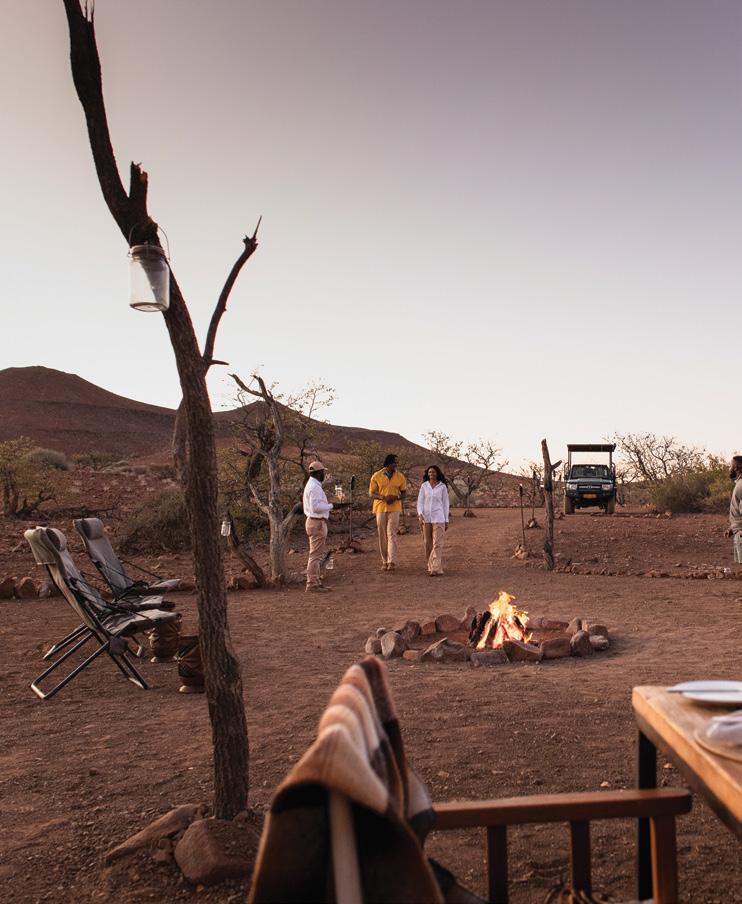


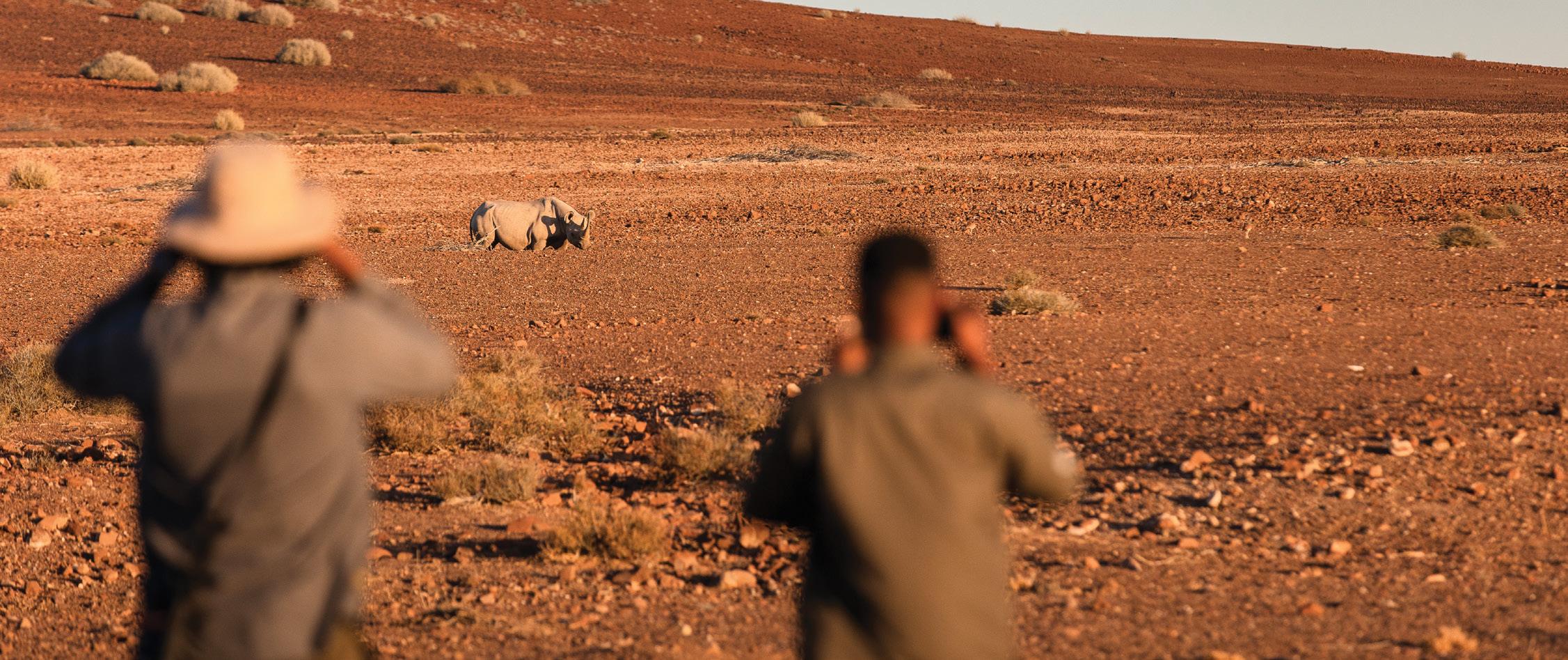
Iwill never forget my first visit to Damaraland. In a sturdy, built-up Land Rover called Kangombe, we arrived at the camp well after sunset. Dinner was a boisterous affair. The camp staff sang around a campfire, and our guide sat with all the other guests at a long family-style dinner table, sharing tales of adventures in this rugged corner of the country. That evening a spotted hyena walked across the deck of my tented suite, and I waited with anticipatory trepidation for him to knock on my door. Earlier that day, Gerhard Thirion of Wilderness had picked me up in Windhoek. The drive from the capital felt like a journey through time. The city’s bustling streets gave way to open plains, dotted with hardy acacia trees and herds of springbok grazing in the distance. As we ventured further north, the landscapes grew harsher and the vegetation sparser. Rocky outcrops rose from the ground like ancient sentinels, their rugged faces weathered by millennia of wind and sun.
I woke up on my first morning at Wilderness Desert Rhino Camp to surroundings that had transformed into a stark, otherworldly beauty. Euphorbia damarana (milkbush) dotted the rocky terrain with its grey-green stems. Toxic to humans, but a lifeline to the desert-adapted black rhino, Diceros bicornis bicornis
The largest free-roaming population of black rhinos on Earth calls this area home. They have adapted to survive here.
This truth, still unchallenged a decade after that first visit to Wilderness Desert Rhino Camp, carries the weight of a remarkable story – a species once teetering on the brink of extinction, now thriving in this unforgiving desert thanks to decades of unwavering efforts by civil society, government and local communities.
I have been back to this special camp at least once a year since then. Each visit reinstils a sense of wonder in me. Each meeting with the incredible staff that have made this camp their own. Each rumble of a guide-driven Land Rover over gravel and rock. Desert Rhino Camp holds a special place in the Namibian touristic treasure chest. Now, Wilderness has reimagined this much-loved destination, and Wilderness Desert Rhino Camp is reborn, though its heart, and its stories, remain unchanged. It is home to a collection of tales of resilience. Of how this landscape and its inhabitants were bound by an ancient pact of survival. Here in Damaraland, life persists against all odds.
Surrounded by the rocky red terrains quintessential of Namibia’s Damaraland, Wilderness Desert Rhino Camp is more than a luxurious retreat. Built on a foundation of partnership and purpose, the camp represents a unique collaboration between Wilderness, Save the Rhino Trust Namibia (SRT) and three local community conservancies. Together, they have created a model that marries luxury tourism with impactful conservation, offering guests the opportunity to not only witness but actively support the protection of Namibia’s critically endangered black rhinos.
The new camp itself is a masterpiece of understated elegance, designed to blend seamlessly into the dramatic landscape. Its six suites, crafted from canvas and stone, reflect the textures and tones of the desert. Inside, rustic charm meets modern comfort, with plush bedding, natural materials and sweeping
views that constantly draw your gaze back to the land. Powered entirely by solar energy and built using repurposed materials, the camp’s commitment to sustainability is woven into every detail.
TRACKING RHINOS: A JOURNEY OF CONNECTION
The highlight of any stay at Wilderness Desert Rhino Camp is the chance to track rhinos on foot and by vehicle. This is not a simple game drive; it is an immersive experience that requires patience, respect and a willingness to follow in the footsteps of the experts. Led by SRT trackers – local community members who know the land intimately – guests learn to read the language of the desert, deciphering tracks and signs in the sand.
It is a humbling experience to come face-to-face with these prehistoric giants. Their massive frames and weathered horns tell a story of survival against all odds. Every sighting feels like a miracle, a testament to the relentless efforts of the SRT team members who monitor and protect the rhinos from the everpresent threat of poaching.
The impact of Wilderness Desert Rhino Camp extends far beyond the lodge. By involving local communities in both its hospitality operations and conservation efforts, the camp has created a ripple effect of empowerment and opportunity. Many of the staff come from the surrounding conservancies, bringing with them a deep connection to the land and its wildlife.
Revenue generated by the camp is shared with these communities, providing essential funding for education, healthcare and development projects. In turn, the communities have become active participants in conservation, understanding that the survival of the rhinos directly impacts their own futures.
Wilderness rhino ranger and guide Bons Roman, who hails from a nearby community, sums it up perfectly: “When you visit, you’re not just staying in a camp. You’re supporting our way of life. You’re helping us protect something priceless.”
Wilderness Desert Rhino Camp, in all its iterations, has always been a call to action. In a world where wilderness is increasingly under threat, places like this remind us of what is at stake – and what is possible when people come together with a shared purpose.
Visiting Wilderness Desert Rhino Camp is more than a luxurious escape. It is an opportunity to connect with the land, contribute to conservation and be part of a story that is bigger than yourself. And in doing so, you will leave not just with memories, but with a deeper understanding of why tourism, when done right, truly matters.
On each return visit to what has cemented itself as (dare I say it) my favourite lodge in Namibia, I look out at the endless landscape, as timeless as it is fragile, and I carry with me a sense of responsibility. It is a reminder of the immense weight carried by those who dedicate themselves tirelessly to the preservation of our natural treasures, and a humbling realisation that every journey has the power to make a difference. TN

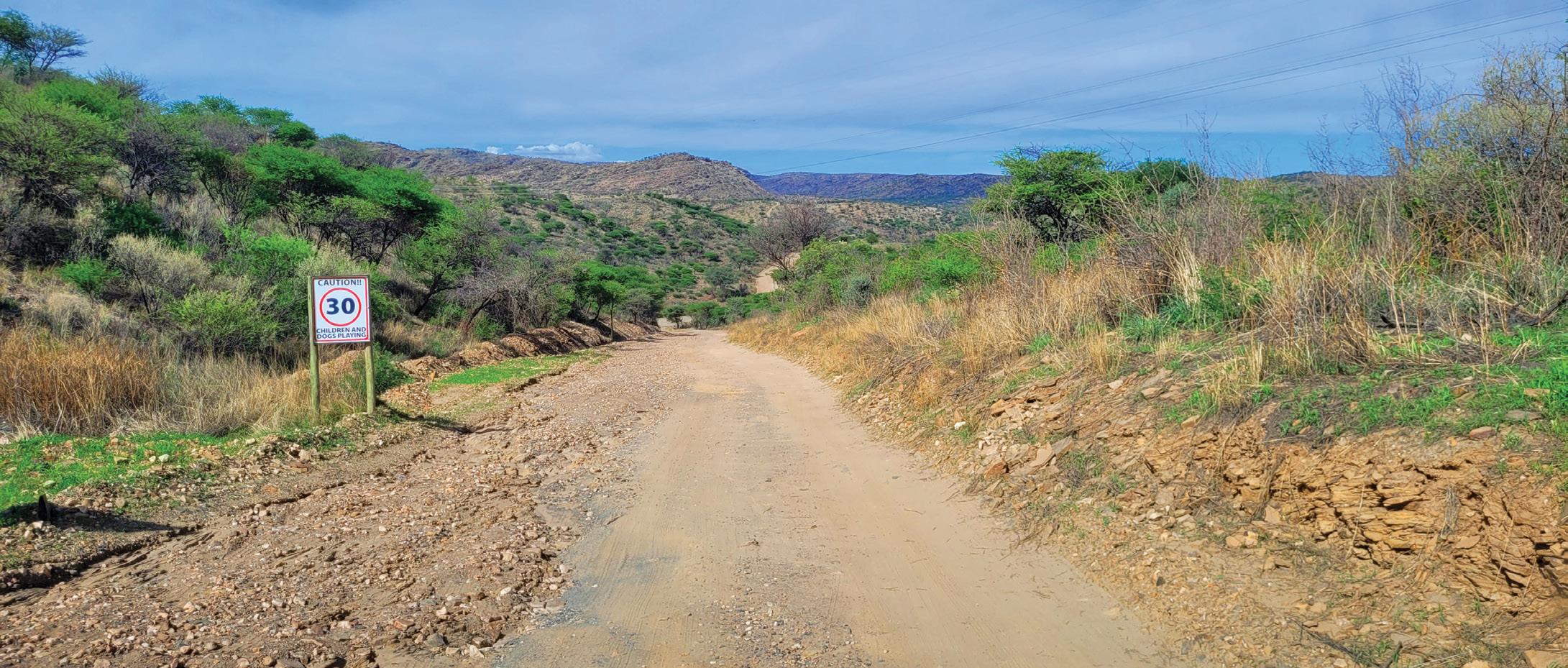
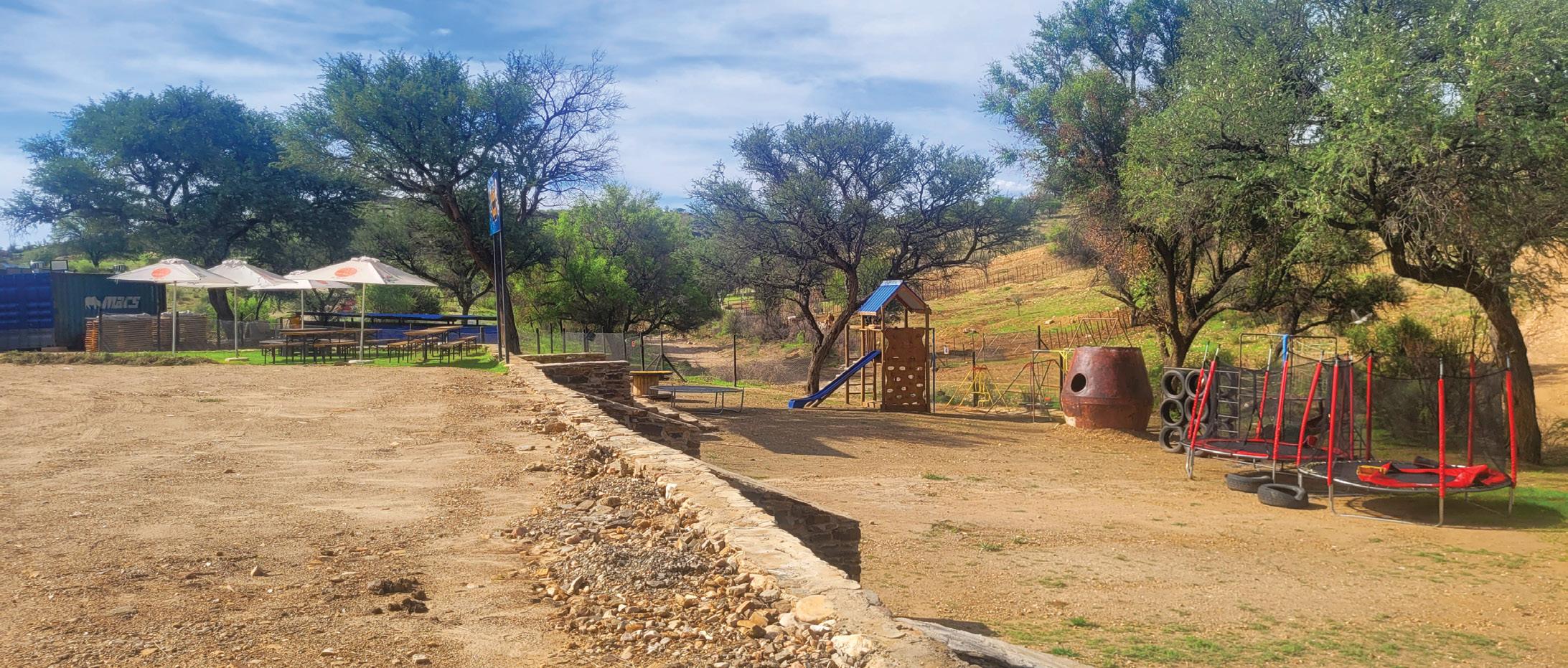

Text Madeleen Duvenhage | Photographs York Duvenhage
I grew to love mountains. Born and raised in the Omaheke Region of Namibia, I was accustomed to flat, sandy plains and thorny vegetation. Apart from family holiday trips to the coast with its frigid Atlantic depths and wind-whipped dunes, this pretty much encapsulated what I knew and understood of landscape, and, of the world.
Traveling abroad for the first time at nineteen, I was immediately introduced to scenery far more mountainous and tropical compared to the lonesome desert spaces of Namibia. Ranges, ridges; snowy summits. Sprawling cities, gardens fringed with banana and avocado trees – pedestrians spilling over into crowded streets. These impressions drew sharp contrasts compared to the measured sparseness of suburban Windhoek!
After nearly a decade dotted by frequent overseas travels, I found myself unexpectedly settling in Windhoek. It has signified a slow process of reacquaintance with a city I hardly knew before.
Naturally, I gravitate towards scouring the local topography for the existence of some, well, substantial geographical altitude. Much to my delight, Windhoek is surrounded by a ring of hills (namely the Khomas Highland, Auas and Eros mountains), which has in recent years been developed for cyclists and avid hikers eager to escape the daily grind.
Yellowstone Trails – a farm on the outskirts of Windhoek, affords the nature-loving urban dweller such an opportunity. Established in 2022, Yellowstone Trails is a family and pet friendly farm behind Avis Dam in Ludwigsdorf.
Originally a canine training and tracking unit, the farm quickly expanded and now offers a surprising array of diverse outdoor activities. These include an outdoor gym and karate studio; an archery shooting range, go karting and horse riding. Yellowstone`s expansive scenic routes are ideal for hiking, running, mountain biking and even dirt bike adventures.
My personal favourite: the farm`s clearly marked paths, often winding through the hills with a cluster of thorn trees perched on rugged peaks, and a flight of swallows sweeping overhead. If you`re not much of a hiker – no need to fret! These trails are easily accessible and suited for every fitness level. Yellowstone Trails also offers guided and educational group hikes on weekends for anyone curious about our ecosystem.
Yes, I know what you are thinking. Nature is wonderful, but what about...coffee? Beer?! Glad you asked! Located right on the farm`s property sits Das Bos - a restaurant and beer garden, serving drinks and mouth-watering food. For those with little ones there is a petting zoo and playground, conveniently located next to Das Bos so parents can still keep a watchful eye.
It`s perfect for slumping into the shade after a strenuous morning hike – or if you simply want to kick back with friends after a long week.
I wonder where to next with an acquired affinity for mountains and good coffee? Join me as I trek through Windhoek`s new, emerging trails. Pleased to meet you, Windhoek – as if for the first time.TN
IMPORTANT INFO:
• Entrance fee - N$20 per person.
• Opening hours - Gates open at 6am and close at 7pm.
• Attire - Wear comfortable hiking shoes as trails can be uneven/rocky.
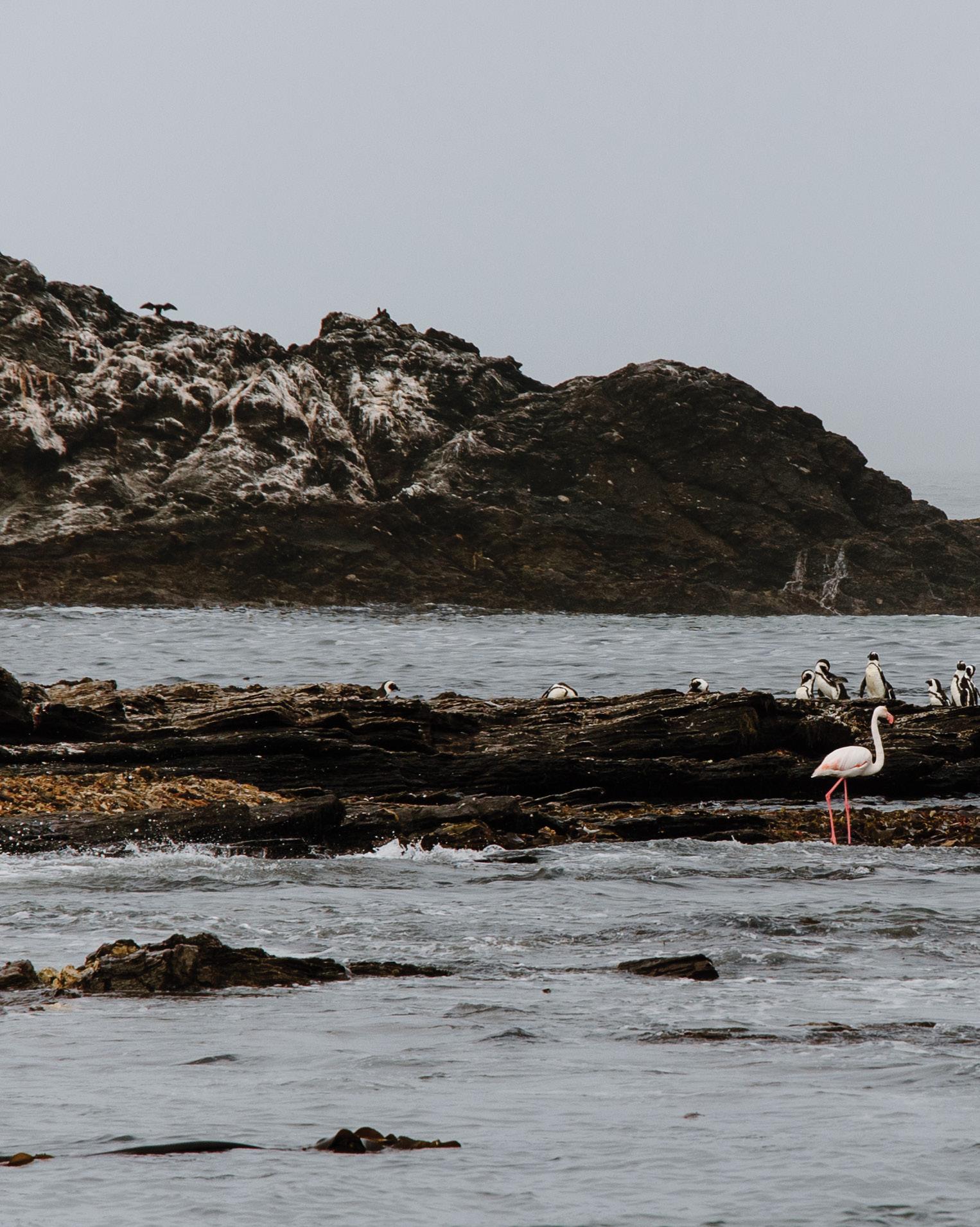
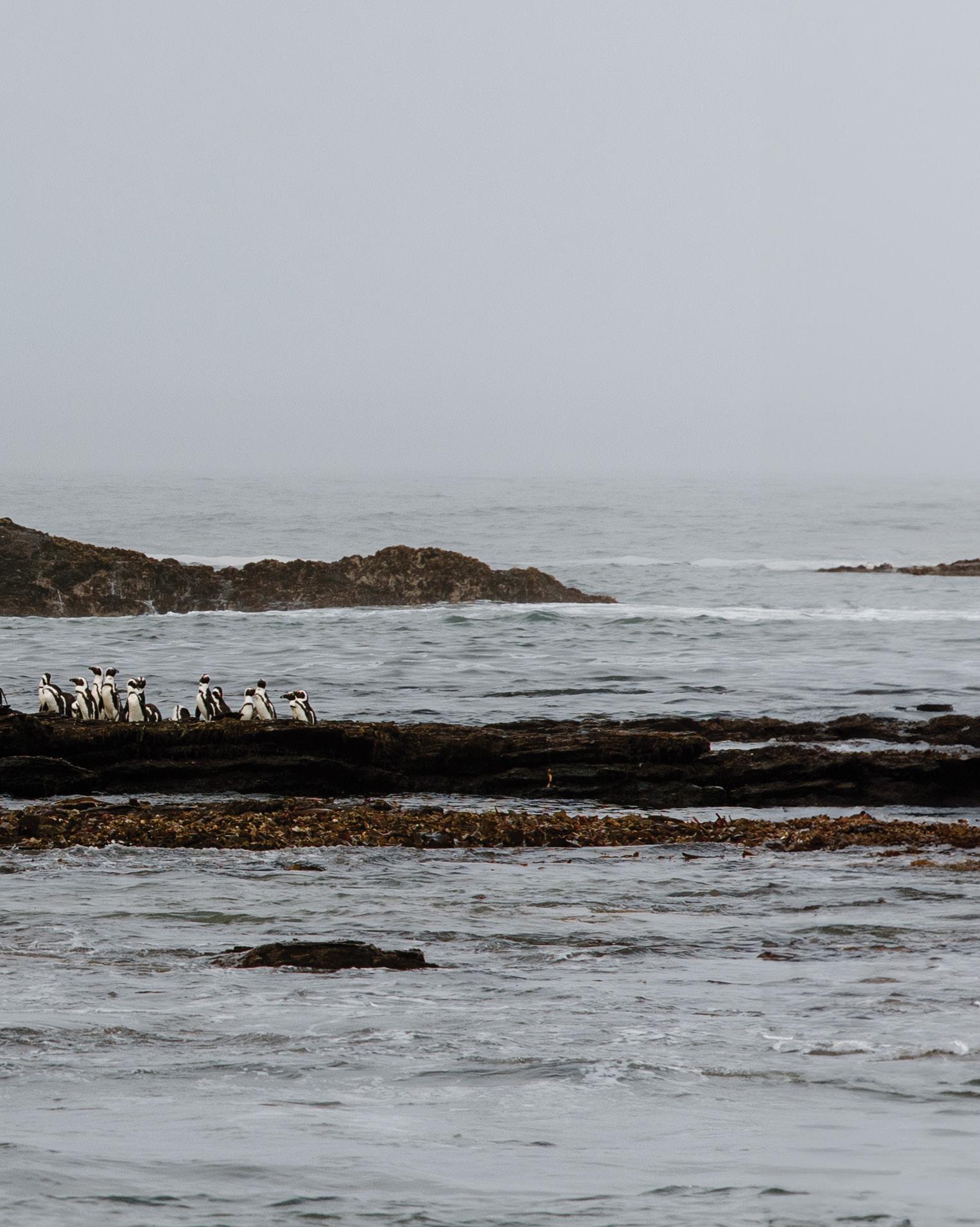

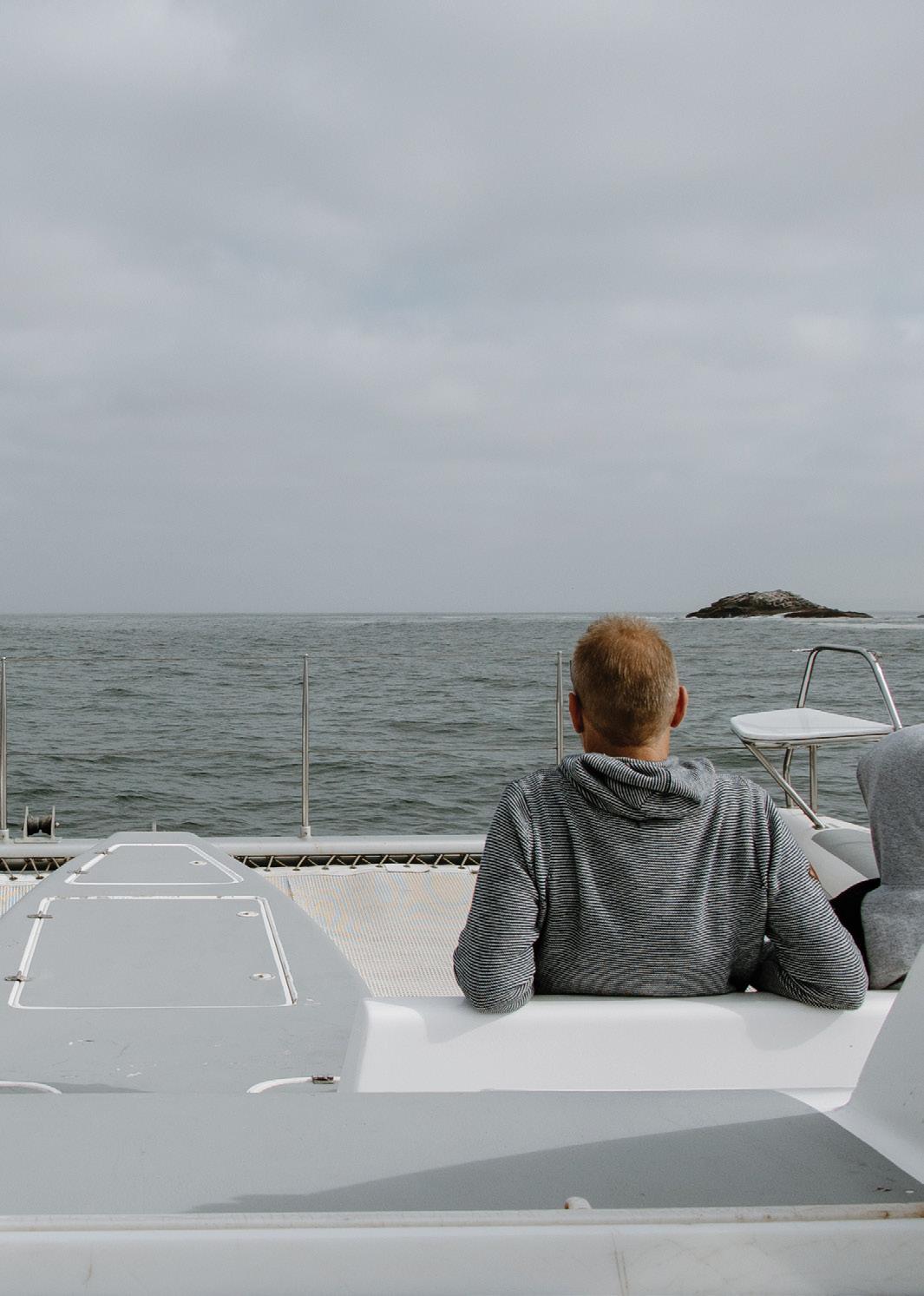


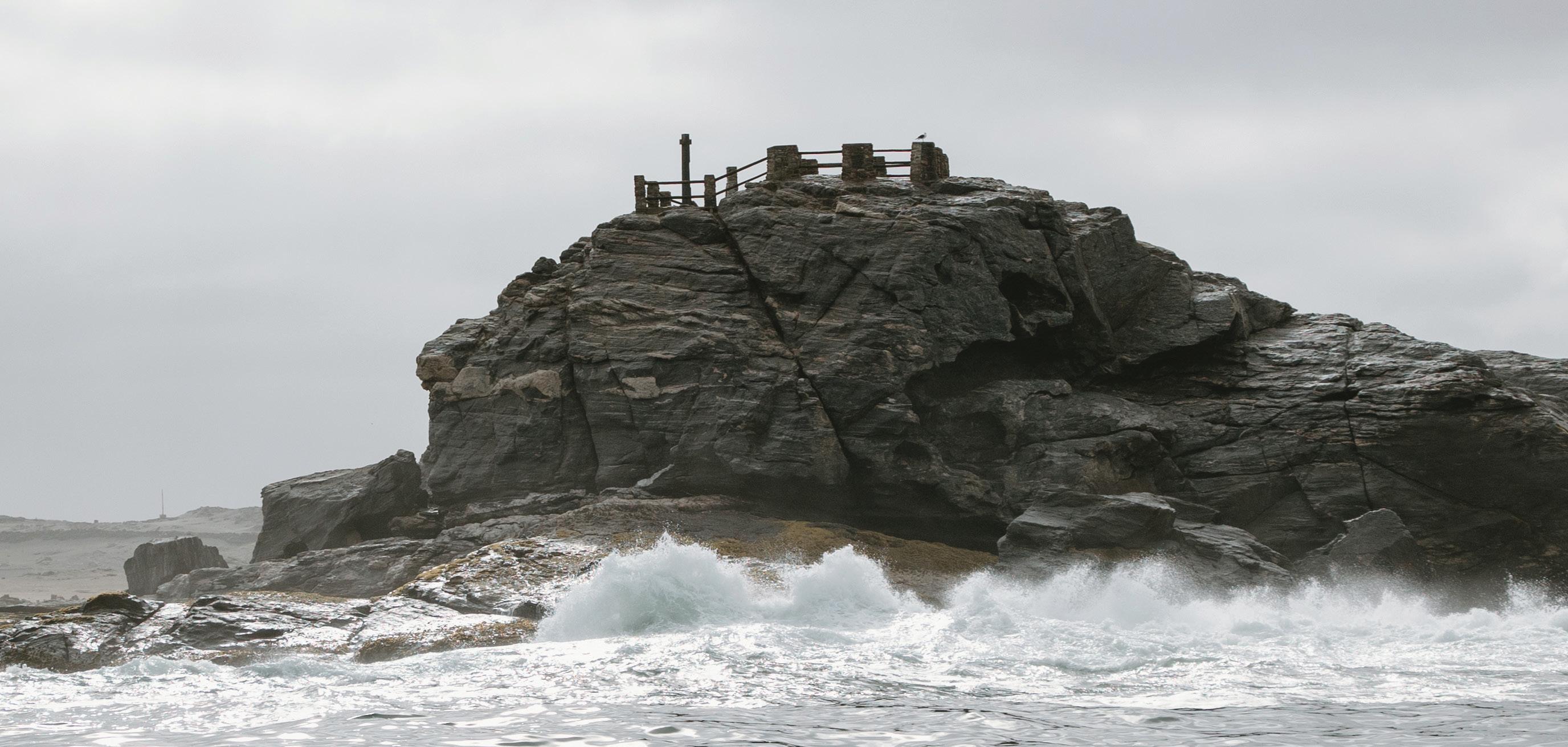
As the first light of dawn stretched over the Lüderitz Waterfront, we gathered at the jetty, greeted by the crisp morning air and the promise of adventure. The crew of Penguin Catamaran Tours—Skipper Christo and deckhand Eslon—welcomed us aboard with warm smiles, their enthusiasm setting the tone for what would be an unforgettable journey. Along with our warm welcome, we each received a branded buff, a thoughtful memento. A few other guests joined us, and after a quick safety briefing, we pulled on our jackets against the brisk sea breeze. The Namibian flag fluttered proudly on the catamaran, a vibrant splash of colour against the soft morning sky.
With a steady hum, the engines came to life, and we drifted away from the harbour, Lüderitz slowly shrinking into the horizon. Just as we settled into the gentle rhythm of the waves, the unexpected happened—a whale! A majestic, elusive silhouette breaking the surface of the water. It wasn’t the typical season for whale sightings, but that didn’t stop Christo from making the moment last. Carefully, he adjusted course, keeping a respectful distance while ensuring we had the best possible view, following the whale for as long as it allowed before it disappeared into the deep.
As we continued, Eslon and Christo painted the seascape with stories—tales of Lüderitz’s history, its explorers, and the rich marine life that called these waters home. Their knowledge made the journey all the more immersive, giving life to the sights around us.
We approached Diaz Point, where, in 1488, Portuguese explorer Bartolomeu Dias planted his stone cross, a symbol of early European voyages to the southern African coast. While
the original cross has long since succumbed to time, a replica now stands in its place, keeping the story alive. Nearby, a striking red-and-white lighthouse has stood watch over the coastline since 1915. Not far from this historical landmark, we came upon a rocky outcrop teeming with Cape fur seals, sprawled lazily in the faintly glowing sunlight, their dark coats contrasting against the greenish-yellow moss clinging to the rock. Below them, the waves crashed in rhythmic bursts, the morning light playing over the frothy surf.
Further out, the ocean stretched vast and blue, and as we neared Halifax Island, the island, a protected breeding ground for African penguins, appeared like a rugged sanctuary rising from the water. From the hammock-like nets, we watched as the penguins waddled across the terrain, their black-and-white figures standing out starkly against the weathered cliffs. Once a guano mining site, the remnants of abandoned buildings dotted the island—a silent reminder of its past, now reclaimed by nature as penguin nesting sites. Flamingos, seagulls, and cormorants added to the avian symphony, each species carving out its own place in this unique ecosystem.
As we took in the view, the crew surprised us with hot chocolate, served in hand-decorated mugs adorned with delightful penguin illustrations. It was, without exaggeration,
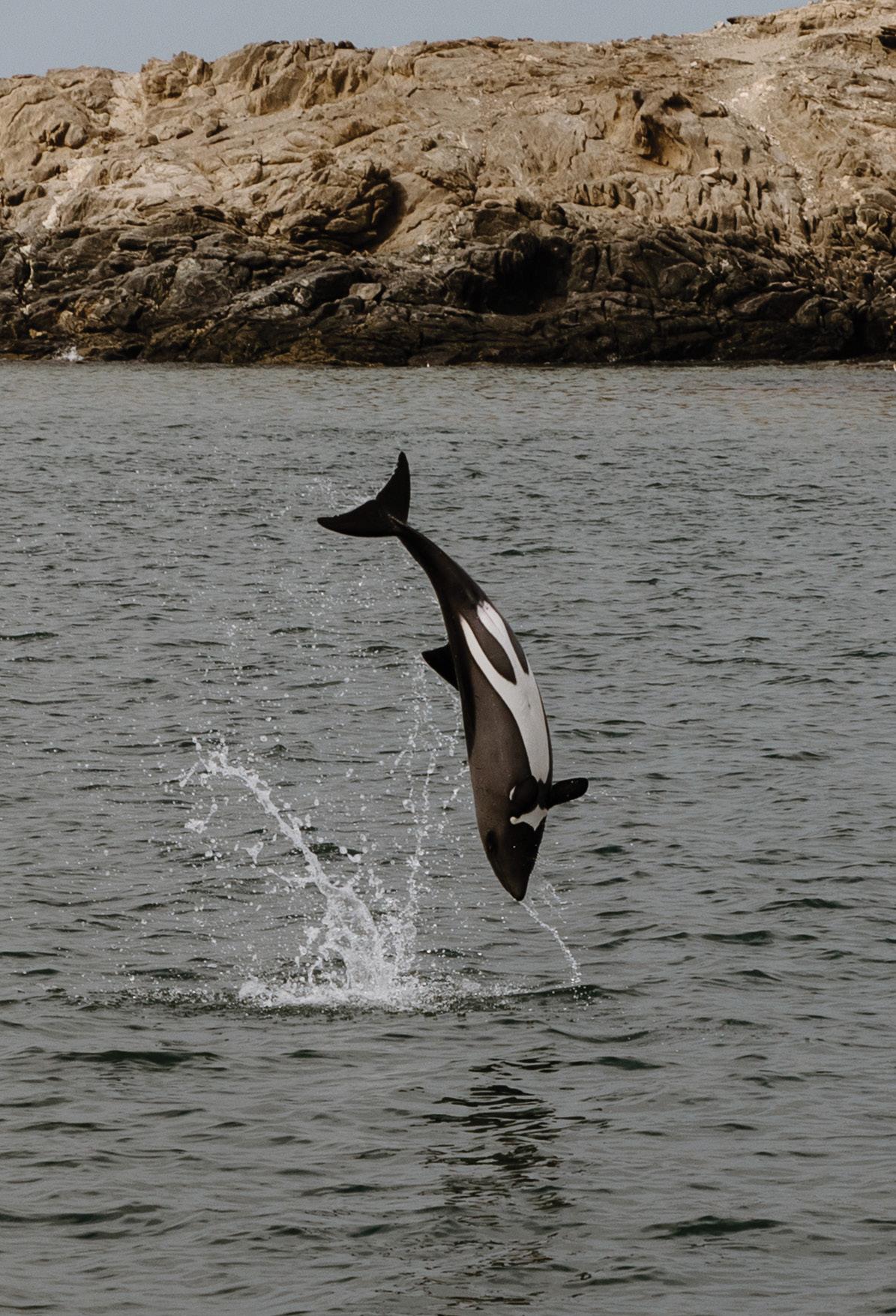
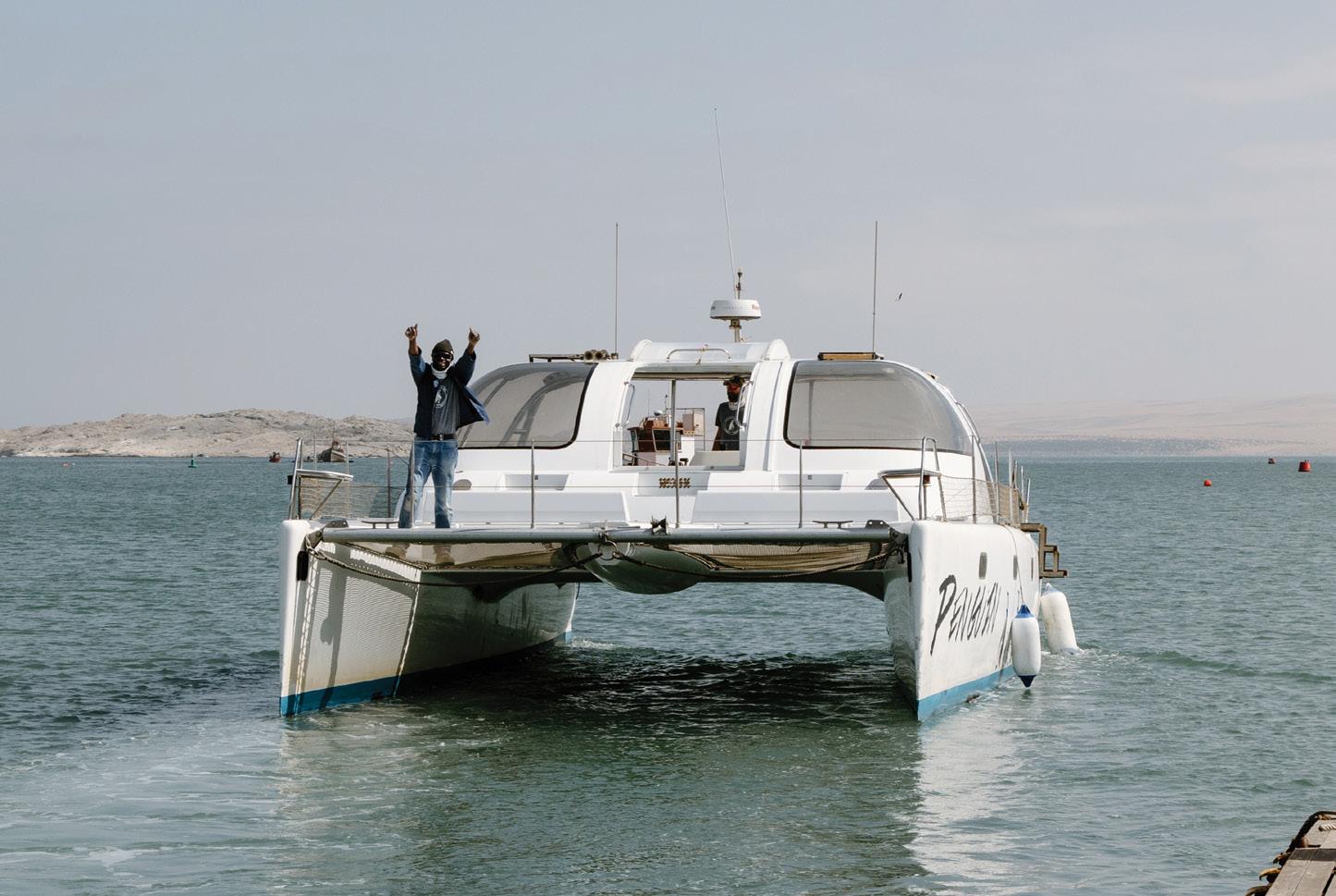

Their energy was contagious, and we found ourselves overwhelmed with excitement and awe, watching in disbelief as they raced alongside us, showing off their speed and agility.
the best hot chocolate we had ever tasted—rich, velvety, and warm enough to chase away the Atlantic chill. Sipping it while gazing at the penguins before us felt like the perfect culmination of the experience.
On the way back, Heaviside’s dolphins joined us, effortlessly keeping pace with the catamaran, riding its waves and darting playfully beneath the hull. Their energy was contagious, and we found ourselves overwhelmed with excitement and awe, watching in disbelief as they raced alongside us, showing off their speed and agility.
As Lüderitz came back into view, we sailed past Shark Island, its bold red building standing out as a final landmark before our return. Upon docking, Christo and Eslon helped us ashore, their hospitality unwavering to the very end.
With one last wave from the crew, we stepped off the boat, hearts full, already longing for the next adventure upon Namibia’s untamed waters. TN
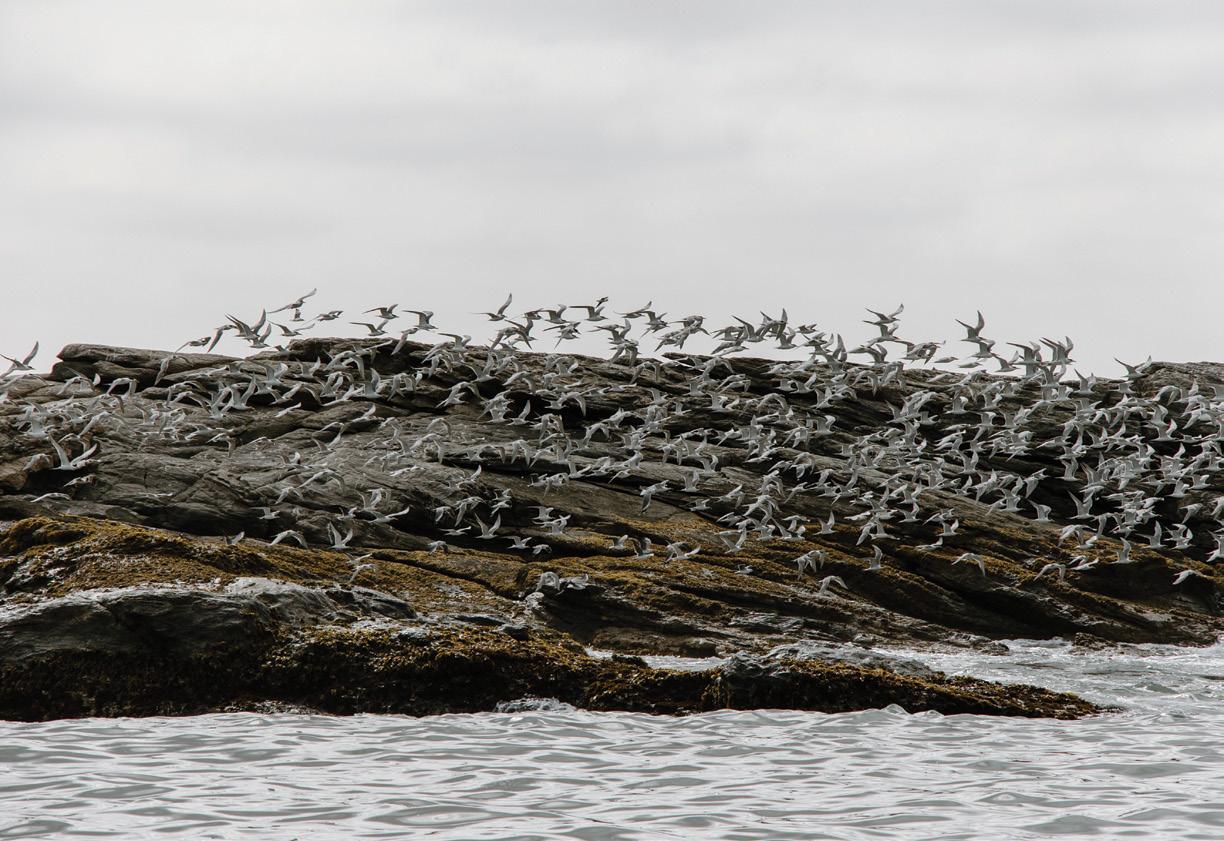



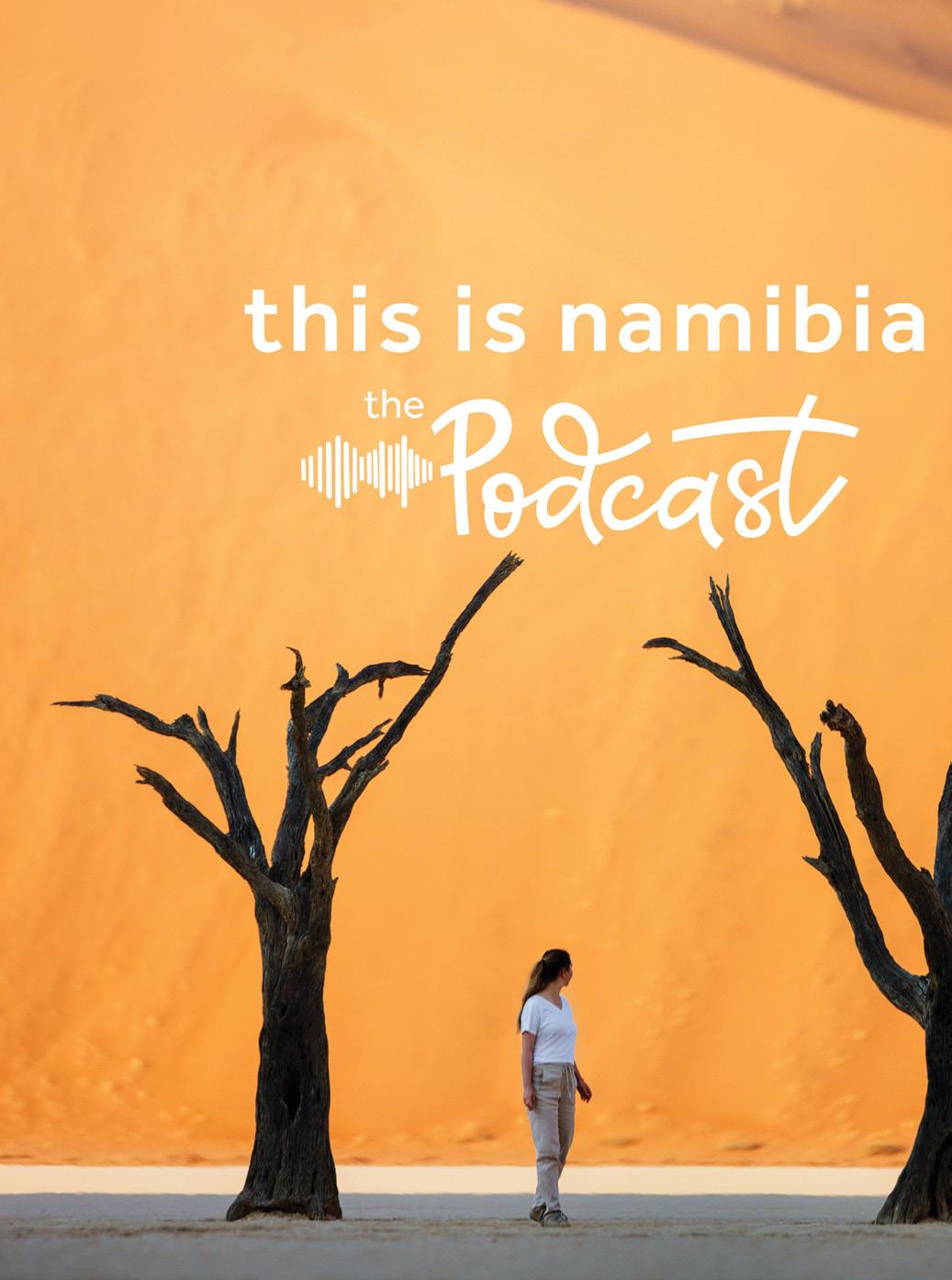

This year we're focussing on telling and sharing STORIES THAT MATTER across our various magazines and digital platforms. Join the journey and share your stories with audiences that understand and value why certain things matter.
Why ethical business, conservation, tourism, people and communities matter. How these elements interrelate and how we can bring about change, contribute to the world and support each other. Whether for an entire nation, an industry, a community, or even just an individual.
Visit www.travelnewsnamibia.com to subscribe to our digital publication on Zinio or to order physical copies of the magazine.



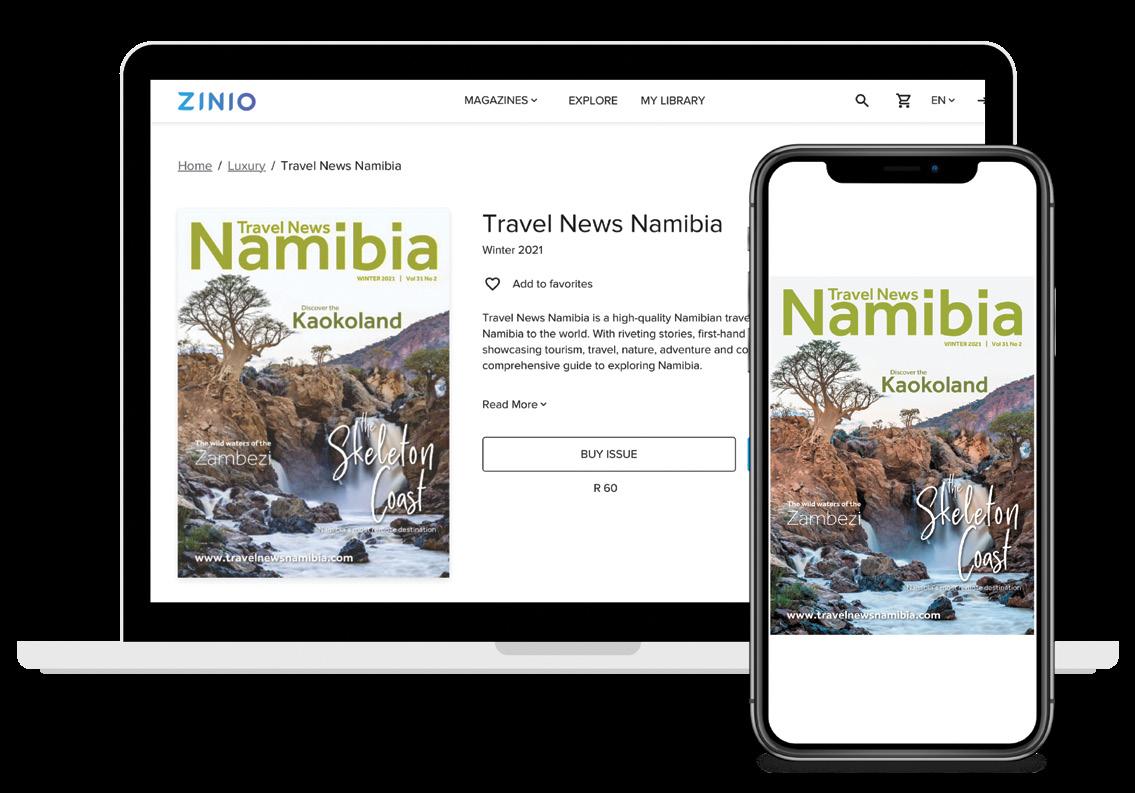
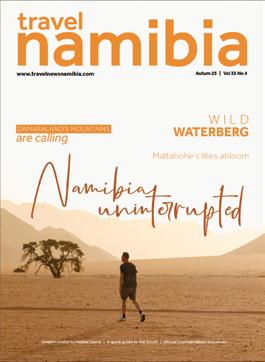

www.venture.com.na or email us at info@venture.com.na for a curated proposal.
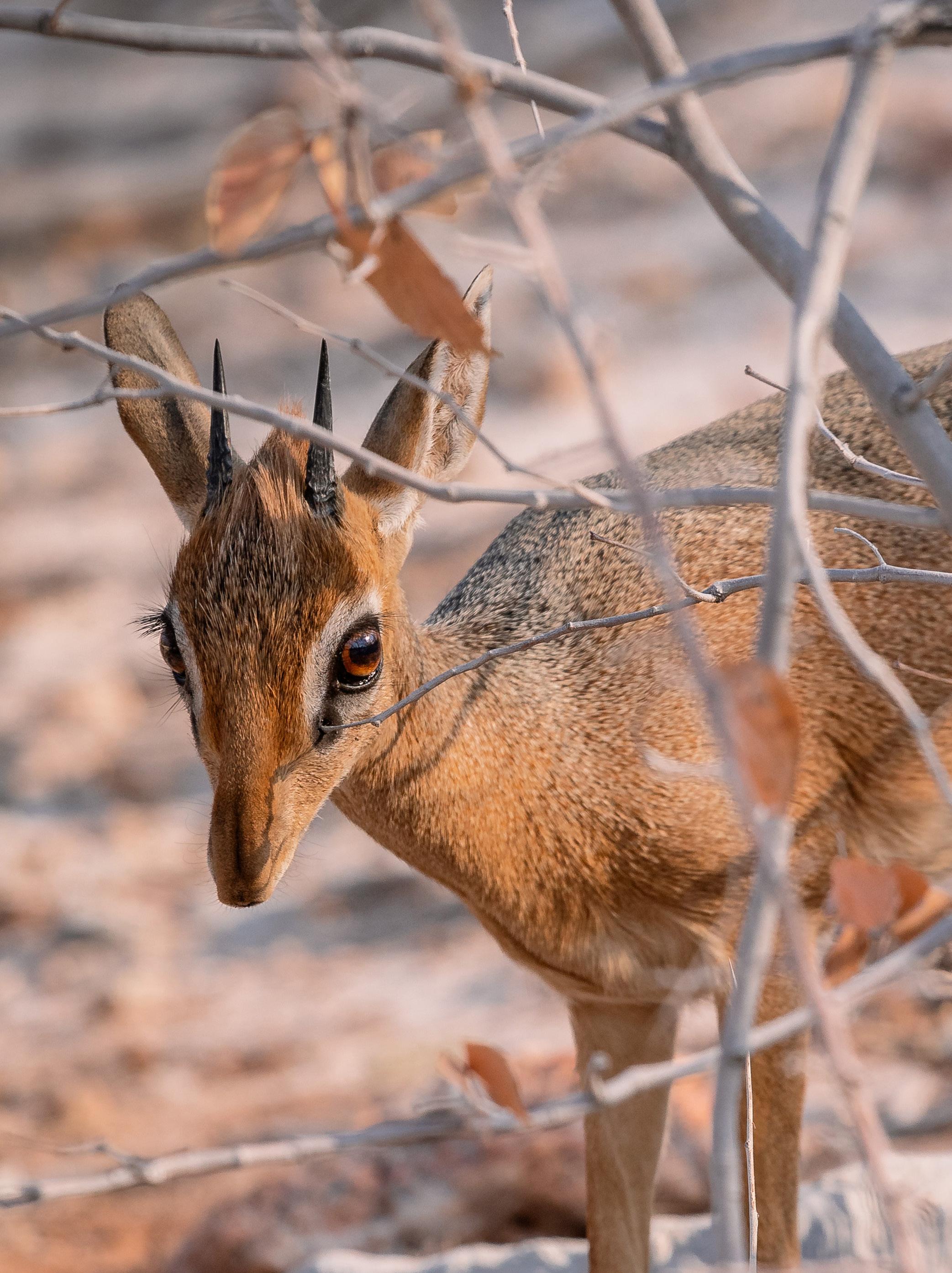

By putting nature first at Ongava, we set the scene for a renewed understanding and appreciation of the importance of wildlife conservation.
